

A Decade of Change!







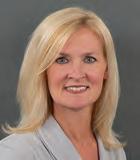



Robert James Vice President
Dan Denehy President
Courtney Corroon Research Consultant
Pamela Roumas Admin. Assistant
Erin Redgate Marketing Assoc.
Carolyn Kepcher Senior Consultant
Karen Alexander Senior Consultant
Patrick Finlen Exec. Vice President
Barbara McAuliffe Senior Consultant
Mark Sell Exec. Vice President


EDITOR’S NOTE

DAVE WHITE
Dave White is the editor of BoardRoom magazine. If you have comments on this article or suggestions for other topics, please send Dave an email to: dave@boardroommag.com.
It’s Been 10 Years of Change!
It has been an amazing partnership. I truly love the club business, the members, the profession, and the industry. CMAA has gotten into my blood and my work has become about the passion for success of CMAA and its members.
What is so cool is that I am just one of 30 professional staff members who feel the same way. It may be work, but I have never been more fulfilled or enjoyed work more.
So says Jeff Morgan, CEO and President of the Club Management Association, during a wide-ranging interview with BoardRoom magazine during the CMAA’s World Conference in Las Vegas.
It’s about a Decade of Change...the 10 years since Morgan took the helm of the CMAA.
• How has the private club industry evolved?
• What’s your view of the GM/COO/CEO concepts and their relationship to the CMAA? Where will this lead in the future?
• Thirty-five percent of families have and never will have children, up from less than 20 percent in mid-1980. This is a significant demographic change over the past two decades. How will this impact clubs over the long term?
• One of the comments over the last 10 years, and not just on the more personal side, was that you didn’t come from the club industry. So, it seems, listening to you, there were advantages to that. What opportunities did you see?
• CMAA’s 100th anniversary is coming up in 2027. How much has the industry changed over the years, and why?
Indeed, when Morgan came on board, a lot of change was happening, and CMAA has grown from 6,500 to 7,800 members during the past 10 years.
“We have a very passionate staff and have just evolved as an organization together, and a lot of my team has a very long tenure. So, it’s been awesome,” expressed Morgan.
It’s an enlightening interview for anyone interested in the private club industry.
n n n
Where’s the pro? What are they doing? Is the pro shop an inviting place? Are the pros good teachers?
These are some of the questions that arise when we visit
our favorite golf course or private club, and John Fornaro addresses them in his Publisher’s Perspective this issue: What Are The Responsibilities of the Private Club Golf Pro Today?
One opinion today is that with COVID-19 in the rearview mirror, the focus of golf and country clubs should be on retention and usage so they can retain their sustainability. To find some answers, Fornaro posed the questions to some of the industry’s leading commentators, including John Easterbrook, Chief Member Officer for the PGA of America, Paul Levy, PGA, CMAA and 40th presidents of the PGA of America, Michael Leemhuis, Principal, Leemhuis Consulting, Russell Sylte, CMP, PGA Master Professional and general manager and COO of The Santaluz Club of San Diego, Robin Shelton, CCM, PGA Master Professional and general manager of the Newport Beach Country Club, Newport Beach, CA and others.
John is well qualified to have his say, if only because he was a part-owner of a private club in San Clemente, CA.
“As part owner of a club, I removed my pros from the pro shop and moved them to the driving range. I paid them a livable wage along with bonus money when the average handicap of members dropped. All the club’s lessons were free. My pro also was focused on usage and retention, which I believe is extremely important.”
It’s an interesting read with a variety of opinions!
n n n
And in this issue, we continue with our stories of BoardRoom’s top presidents, including Liza Barnett Emmet, Commodore, Florida Yacht Club |Jacksonville, FL; Jim Doehring, President, Edgewood Country Club, Burr Ridge, IL; William Doyle, President, Westwood Country Club, Vienna, VA; Jim Foley, President, Exmoor Country Club, Highland Park, IL; Bill Hamel, President, Carmel Country Club, Charlotte, NC; Michael Hartrick, President, Toronto Lawn Tennis Club, Toronto, Ont., Canada, and Ed Kelly, President, TPC Treviso Bay Golf Club, Naples, FL. BR
Publisher/CEO
John G. Fornaro
Editor
Dave White
Chief Creative Officer
Heather Arias de Cordoba
Copy Editor
Chryssoula Filippakopoulos
Innovative Ideas Editor
Heather Arias de Cordoba
APCD Executive Director
Bill Thomas
Editorial & Marketing Director
Dee Kaplan
Business Development
Joshua Nuzzi
Operations Director/Subscriptions
Krystal Santoro
Contact Information www.BoardRoomMagazine.com www.apcd.com (949) 376-8889
Featured Columnists
Rick Coyne
Henry DeLozier
John Fornaro
Bonnie J. Knutson
Contributing Writers
Ronald Banaszak
Rita Barreto
Kris Butterfield
Ronald F. Cichy
Timothy J. Clow
Frank Cordeiro
Michael Crandal
Dave Doherty
Todd Dufek
Boris Fetbroyt
Chryssoula Filippakopoulos
Dick Kopplin
Kurt Kuebler
Nancy Levenburg
Phil Newman
Susan Greene
Mark Gurnow
Larry Hirsh
Julia Kelly
Chris Kulinski
Laura Leszczynski
Eric Loftus
Melissa Low
David Mackesey
Brian Meanley
Wayne Moriarty
Jessica Payne
Strategic Partners and Allied Associations





Co-Founder/CEO
John G. Fornaro
President
Keith Jarrett
Chief Analyst Frank Gore
Chief Information Officer
Jeff Briggs
Executive Director
Bill Thomas
Executive Assistant/ Director of Support
Joshua Nuzzi
Gregg Patterson
Tom Wallace
Dave White


Robert D. Podley
Whitney Reid Pennell
John Rowland
Emad Saedi
John Schultz
Toni Shibayama
Mike Strauss
Michelle Tanzer
Gordon Welch
Frank Wolfe













The Digital Summit is back! The private club industry’s leading annual event happens on May 8th.
Attend the Summit to benefit from:
•CMAA-approved Continuing Education Credits
•Access to immersive, interactive sessions
•First-hand customer experiences
•Expert-led private club trends discussions
Don’t miss your chance to engage with private club leaders as they address your questions and o er insights into real club challenges, experiences, and pain points at Clubessential’s 2024 Digital Summit.


WHAT ARE THE RESPONSIBILITIES OF THE PRIVATE CLUB GOLF PRO TODAY?
JOHN FORNARO
Before COVID-19, most private clubs focused on membership recruitment. Many clubs ended up with full members rosters. With COVID in the rear-view mirror, the focus should be on member retention and usage, and aprivate club’s golf pro is critical to this retention and usage. So, what are the responsibilities of the private club golf pro today?

SORRY MEMBERS
PHIL NEWMAN
The U.S. economic landscape continues to stabilize as inflation eases and consumer spending remains resilient despite high interest rates and a tight labor market. Falling inflation has provided some relief for businesses as input costs normalize; however, prices for some key commodities. As inflation continues to ease, pressure on clubs from members to control and reduce prices will intensify.
GLOBAL PERSPECTIVES | 80

THREE THINGS YOUR BOARD SHOULD BE DOING
HENRY DELOZIER
Most private clubs are in their halcyon days. Memberships are full to overflowing in nine out of 10 clubs. Access to new funds has accelerated capital spending priorities. And the worst of the antisocial and undesirable behaviors demonstrated by some members during the pandemic seems to have subsided. Happy days are here, again.

DISCOVERY AND THE MYTHS ABOUT DATA
RICK COYNE
From the “dues-based” nature of the revenues to constantly changing volunteer boards, it’s a challenge for private clubs to find a path to consistent and fact-based decision-making. Like churches in terms of club volunteer leaders, this well-intentioned process can make a club’s decision-making process look like a sailboat tacking into the wind in short order.
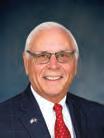


ESTABLISHING A MODERN-DAY PERFORMANCE MANAGEMENT SYSTEM
DICK KOPPLIN, KURT KUEBLER & TOM WALLACE
Over time, we have consistently been surprised to discover that in many scenarios there is a subjective process for performance evaluation or not one at all. This is concerning as we often see a connection between managers who aren’t receiving feedback and managers who are being let go from their positions.
MEMBERSHIP MUSINGS | 84

AWARD OR REWARD? THAT IS THE QUESTION.
BONNIE J. KNUTSON
Most private clubs are in their halcyon days. Memberships are full to overflowing in nine out of 10 clubs. Access to new funds has accelerated capital spending priorities. And the worst of the antisocial and undesirable behaviors demonstrated by some members during the pandemic seems to have subsided. Happy days are here, again.

SOME PEOPLE JUST DON’T GET IT NANCY LEVENBURG
As I write this, I’m beginning to organize and pack for my 16th cruise on board the same cruise line (Princess). This cruise will be to the Caribbean, and I’ve now achieved “Elite” status. Princess’ loyalty program is one factor that’s on my mind when I start envisioning my next cruise. Do I want to be a Princess Elite passenger who’s treated like royalty? Or do I want to be on the bottom rung on another cruise line? You can guess …
LEGISLATIVE COMMITTEE | 44

2024 LEGISLATIVE AND REGULATORY UPDATE
MELISSA LOW
As Congress addresses outstanding spending legislation and priorities during the first quarter of the year, the federal regulatory agencies have been busy with new proposed and final rules affecting the employment landscape in the club industry.
TRIBAL MAGIC | 108

FUN TIMES ON ‘THE FANTASY NINE’ GREGG PATTERSON
I have a dream. This is the dream of an Old Geeky Guy, a walker and a talker who hasn’t played much golf, and what golf he played was really bad. But when he played, the playing was fun.



ON THE FRONTLINES .............. 50
What Off-Season?
By Mark Gurnow
DISTINGUISHED CLUBS 94
The Argyle Club By Ronald Banaszak
DISTINGUISHED CLUBS 96
Salish Cliffs Golf Club By Ronald Banaszak
DISTINGUISHED GOLF DESTINATIONS.... 97
World Golf Village By Ronald Banaszak
EXCELLENCE IN CLUB GOVERNANCE ... 102
Addressing Transparency Red Flags in the Boardroom By Henry DeLozier
INNOVATIVE IDEAS ............106-107
Detroit Athletic Club
Flint Hills National Golf Club By Chryssoula Filippakopoulos
THIS MUCH I KNOW FOR SURE ...... 119
Membership Privileges? WHAT THE #@*$%& ARE YOU THINKING???
By Dick Kopplin
FEATURE ................. 90
Peter Jackman, Terminal City Club Receives John Fornaro Impact Award By Wayne Moriarty

FEATURE 92
Randy Addison Recognized With BoardRoom’s Lifetime Achievement Award By Timothy J. Clow

DEPARTMENTS



Chryssoula Filippakopoulos
EXECUTIVE COMMITTEE
COMMITTEES

PUBLISHER’S PERSPECTIVE

John G. Fornaro is the publisher/CEO of BoardRoom magazine, co-founder/CEO of Distinguished Clubs and the CEO of the Association of Private Club Directors (APCD). If you have comments on this article or suggestions for other topics, please contact John Fornaro at (949) 376-8889 or via email: johnf@apcd.com
What Are The Responsibilities of the Private Club Golf Pro Today?
Before COVID-19, most private clubs focused their attention on membership recruitment. Not surprisingly, many clubs ended up with full members rosters as members sought a respite from COVID-19.
That’s because members could play golf as an outdoor activity and people could insulate themselves somewhat from the ravages of the pandemic.
With COVID in the rear-view mirror, the focus for private clubs should be on member retention and usage to help their club maintain sustainability.
A private club’s golf pro is critical to this retention and usage. So, based on this statement, What are the responsibilities of the private club golf pro today?
“It’s not a singular focus. A good golf professional has many responsibilities,” said Paul Levy, PGA, CMAA, Principal, PKL Club & Golf Management Services, LLC, a search executive with Kopplin, Kuebler & Wallace and the 40th President of the PGA of America.
“The golf professional is responsible for the overall member golf experience. This includes, in order of importance:
• Recruiting
• Hiring and training a well-motivated and energized golf staff
• Providing a world-class golf experience daily
• Coaching and teaching their membership to enjoy the game and how to utilize and enjoy the golf experience and operation
• Offering an effective, inviting and inclusive tournament program, and
• Managing the tee sheer and the golf merchandise concession in the golf shop.”
And there’s consensus from John Easterbrook, Chief Member Officer for the PGA of America and Michael Leemhuis, Principal, Leemhuis Consult, LLC, based in North Palm Beach, FL.
“The golf professional shouldn’t have a singular focus. The position is too valuable and I’d suggest the golf professional be involved in as much as possible,” said Easterbrook.
“Being the golf ambassador and growing the game of golf for the club’s members; growing participation and connecting people to the game and administration of the club events are all responsibilities of the pro.
“Typically adding retail operations and merchandising as well as being in lock step with the agronomy lead on a course set up and playability” are additional responsibilities.
“The golf professional is typically the club’s conduit of communication. Since golf members are typically high users, the golf staff hears about all areas of the club,” he added.
“PGA of America is working hard with private club boards to increase compensation and improve retention programs for their golf professionals. Many clubs have implemented flexible scheduling and focus on the golf professional striking a solid work-life balance. Many clubs have also made the appropriate compensation adjustments to keep their very valuable team leaders.
“COVID-19 proved the value of golf professionals and superintendents working together to keep the game open and growing. This led to great performance in the private club market and showcasing the value of the ‘operators’ has led to conversations driving compensation and retention programs,” Easterbrook explained.
“The golf pro is, in my humble opinion, one of the most important staff members at a club, if not the most important when it comes to members and member satisfaction … after all, it’s what you would expect when you join a club with golf facilities,” Leemhuis expressed.
“The responsibilities are all-encompassing… playing, teaching, coaching, merchandising, tournaments and running the golf business. All are important and need to be managed and prioritized. And the golf pro needs to be involved in all aspects of the club,” added Leemhuis, MA Ed. CCM, CCE, Master PGA and CMAA Fellow.
Rick Coyne, principal with ClubMark, said, “While ensuring a golf program touches every level of golfer, including those not in the ranks of regular players, in fairness, golf professionals have been somewhat insulated from integrating into the overall fabric of the club membership.
“Golf is significant to the lives of almost every member and the golf professional is a key personality to every golfer. Underutilized yes. Golf professionals can play an enormous role in other areas of the club’s success simply by engaging.
“Whether that is membership, event planning outside of the golf course or other ways to bring new players from existing non-playing members. They can play an enormously important role when they integrate into other areas,” Coyne added.
“Should it be the singular focus? Heaven no! While there is the reality that few members ever leave a club as their handicap is lowered, attending to the handicaps is only one focus. Professionals in every department must seek to understand


CASE STUDY

RICK COYNE
Rick Coyne is president, Club Mark Advisors. He can be reached via email: rcoyne@clubmark.com
Discovery and the Myths About Data
Private clubs are unique animals in the world of business.
From the “dues-based” nature of the revenues to constantly changing volunteer boards, it’s a challenge for private clubs to find a path to consistent and fact-based decision-making. Like churches in terms of club volunteer leaders, this well-intentioned process can make a club’s decision-making process look like a sailboat tacking into the wind in short order.
Two things often go wrong. Uninformed volunteer boards often take control and without inherent or accumulated knowledge, they subsequently make uninformed and/or bad decisions.
Let’s be clear. This isn’t another hit job on boards. Honestly, after these 50-plus years in the business, I think the problem boils down to a few solvable strategic and tactical moves.
They take control. First, all kinds of people and all kinds of motivations want to serve on a volunteer board or committee. For this discussion, let’s assume that the volunteers we are discussing are sincere about serving for the betterment of the club and its members. Others with perhaps less than noble intentions should have been weeded out in the selection and vetting process. Easier said than done, right?
In either case, new board members are often unfamiliar with a dues-based business and have minimal institutional memory from which to learn. Put yourself in their shoes.
• Without an orchestrated and mandatory orientation of past and current club conditions and action plans
• In the absence of a visible strategic plan or direction to guide the club year over year
• With a replenishment capital strategy or projects on the horizon with no visible plan
• With no organizational structure or responsibility matrix to identify their roles.
They see a void that needs to be filled and that job must be theirs.
Bad decisions. Let’s be fair here and understand some of the issues surrounding the potential failure of good intentions. Every club, and likely every volunteer, wants board and committee members who are fully oriented and educated on a myriad of things. The void is often the non-availability of the volunteers to attend the orientations, or there’s no intention or plan to orient incoming volunteers.
At the very least, each incoming volunteer leader should know the following:
• What a “dues-based” business is and how it operates differently from other businesses
• The roles and responsibilities of a volunteer and rules of engagement as a volunteer
• The club’s mission and vision, what it means and why it is important
• The current strategies, goals, objectives and past per formance indicators
• How the club is strategically positioned to your com munity market demographics and competitive envi ronment with attractive brand awareness
• The genesis of any current strategy or master plan, how the club got there and why it’s important to re main on track
• What is important to club members in terms of why they join and remain members and how club depart ments are responding to these needs.
Frankly, nobody, including a tenured and experienced general manager/chief operating officer, could go into a club without this same intelligence and be expected to make critical operational or strategic decisions. The difference between an experienced professional and a volunteer is the professional knows to get this information before making critical decisions.
Reliable and trusted data that is easily translatable into actions and strategies is foundational to getting everyone on the same page. Clubs have endured decades of governance and consistency issues, all of which are solvable with data and an understanding of what it means.
As Charles Reade reflected, “Sow a thought, and you reap an act; sow an act, and you reap a habit; sow a habit and you reap a character; sow a character, and you reap a destiny.”


Learning is an integral process of success made greater when shared with your team. A team that learns together, grows and succeeds where others don’t.
If you are hiring a new general manager, if you are getting ready to change board members or add new committee members, develop a process in which everyone is on the same page. In the interim, embrace data. It can be trusted. BR







PLIGHTS AND INSIGHTS

NANCY M. LEVENBURG
Nancy Levenburg, PhD, is professor emerita in Management from the Seidman College of Business at Grand Valley State University in Grand Rapids, MI. She has published hundreds of articles in business and professional journals, and has assisted over 200 organizations with strategic planning, marketing strategy and improving operations. She is the president of Edgewater Consulting and a member of Spring Lake Country Club in Spring Lake, MI. For more information, contact her at: levenbun@gvsu.edu or (616) 821-5678.
Recognizing Longtime Members
“I can’t expect loyalty from the army if I do not give it.”
– George C. Marshall
As I write this, I’m beginning to organize and pack for my 16th cruise on board the same cruise line (Princess). This cruise will be to the Caribbean, and I’ve now achieved “Elite” status.
Princess boasts four loyalty tiers, beginning with “Gold” (after your first cruise) and culminating in “Elite,” which is awarded after completing 15 cruises or spending 150 days at sea.
And with my new Elite status, I have not only priority embarkation and disembarkation, Wi-Fi, a complimentary in-room mini-bar and discounts on ship shopping but also complimentary laundry services and shoe polishing, although I can’t imagine wearing anything other than sandals or tennis shoes on a Caribbean cruise. And more goodies on top of all this.
Princess’ loyalty program is one factor that’s on my mind when I start envisioning my next cruise. Do I want to be a Princess Elite passenger who’s treated like royalty? Or do I want to be on the bottom rung on another cruise line? You can guess …
According to Forbes, loyalty programs not only give customers perks and benefits but also build an emotional connection between brands and shoppers – or between cruise lines and cruisers. “This connection is what keeps customers coming back time and time again. In fact, 78 percent of consumers are more likely to buy from a brand with a loyalty program.”
As another example, my favorite lunch spot in Grand Rapids also has a loyalty program that I’ve joined, allowing me to accumulate points based on the day of the week I dine there and the total dollar amount of my order. I can redeem my points for cash back on a purchase or other freebies, such as a soda drink or dessert. Bath and Body Works, Amazon Prime, Starbucks, Sephora, REI, Chipotle and Delta Airlines offer loyalty programs.
And we all know that attractive rewards and incentives can lead to repeat purchases and long-term loyalty, which helps businesses grow their customer base and increase their revenue over time.
So, how many private clubs offer loyalty programs? Or recognize (and reward in some way) their longtime and loyal members? Something to say thank you for their patronage over the years? If not, should this be something your board of directors considers?
Here’s why (three reasons):
Reason No. 1. Joining a country club isn’t cheap, and members are constantly spending money. The average cost of a country club membership, according to a survey done by Golf Digest, is $520 per month. In addition to regular monthly membership dues, members pay for golf carts, club storage, lockers and so on. And then there’s drinks at the bar or while out on the golf course, dining, spending on branded merchandise in the pro shop, private lessons and hosting special events at the club.
And it all adds up over time. So, what would it cost to throw in a gift for those who’ve been members for various numbers of years … for example, at 10 years? How about a club-branded coffee mug? Twenty years? A set of coasters bearing the club’s logo? Or perhaps something more substantial like a reserved spot in the member/guest tourney, a waiver of food minimums or a complimentary golf lesson from the head pro? Something that says “thank you.” Why? It’s polite.
Reason No. 2. It makes sense financially. You can’t overstate the importance of retention. And it reportedly costs four to five times as much to attract a new member than it does to keep an existing one.
Reason No. 3. It increases the lifetime value of your members. Member lifetime value is the net profit attributed to the overall relationship you maintain with a member over time. It tracks how valuable a member is to you now – and how much this ongoing bond might be worth in the future. Loyalty programs improve MLV when members spend more money – whether in the bar, dining room or pro shop –and/or do so more frequently.
Employer anniversary awards show employees that they’re important. They matter. Shouldn’t your longtime members matter, too? BR

CLUB FACTS & FIGURES
Sorry Members

PHIL NEWMAN
Philip G. Newman, CPA, CIA, CGFM is a partner with RSM US LLP. He can be reached via email: philip.newman@rsmus.com
Lower Inflation Doesn’t Equal Lower Dues in 2024 and Beyond
The U.S. economic landscape continues to stabilize as inflation eases and consumer spending remains resilient despite high interest rates and a tight labor market.
Falling inflation has provided some relief for businesses as input costs normalize; however, prices for some key commodities, particularly in the food and beverage space, remain elevated. As inflation continues to ease, pressure on clubs from members to control and reduce prices will intensify.
This pricing pressure and stubborn input costs will challenge club operating budgets.
Producer prices rose at an accelerated pace in the second half of 2021 and throughout 2022. It wasn’t until earlier in 2023 that the producer price index for finished consumer goods began to ease, recently falling to .2 percent in September from the two-year peak of 16 percent in July 2022. September 2023 marked the eighth consecutive month in which producer prices rose slower than consumer prices for food at home and away from home. Consumer prices rarely rose faster than producer prices in the previous two years, but the trend reversed in early 2023, fueling member expectations for price cuts.
Even as producer prices recover, other critical costs, including transportation, warehousing and labor, remain expensive compared to pre-pandemic levels. While the growth of such expenditures has slowed, it does not alleviate the challenge they pose to clubs delivering desired member experiences in a challenging cost environment. The longer-term impact of inflation will continue to weigh on club suppliers with food and beverage companies, paying nearly 23 percent more for warehousing and about 11 percent more for freight in September 2023 than two years ago.
How is this narrative likely to play out in the private club space in 2024? RSM pulse survey responses in November 2023 from more than 600 club leaders and managers revealed that while anticipated cost in-



creases were less than when compared to 2023, members should not expect club operating costs to decrease.
Looking at this data solely from the food and beverage perspective, the responses trended, not surprisingly, toward the higher percentage increases. Given these expectations for the largest part of any club’s operating expense budget, the corresponding impact on club operating dues should not be a surprise. Explaining to members the personal financial pressures that continue to impact club staff can be difficult. Members tend to operate and exist in a different economic sphere than the people who work at their club. With improving national inflation data, one of the most impactful data points that clubs can share in this regard is arguably the concept of “rent burden.”
The Department of Housing and Urban Development defines rent-burdened households as those “who pay more than 30 percent of their income for housing, including utilities, and may have difficulty affording necessities such as food, clothing, transportation, or medical care.”
The Waller, Weeks and Johnson Rental Index (The Index) (https://www.fgcu.edu/cob/lucas/overvalued-rental-markets) can be a meaningful, dollar-based tool to educate members on one of the largest drivers of staff costs and, in turn, pay rates and operating dues. Consider the highest 20 rent-burden locations across the country: While the data for major metro areas may not surprise, members at a private club in Naples, FL, audibly gasped upon learning employees, living a few miles north in Cape Coral, need an annual household income of almost $90,000 to afford other necessities for their families.
Club management should endeavor therefore to make budget presentations as personal and localized as possible so that members fully understand the continuing local cost pressures despite an improving national inflationary environment. BR
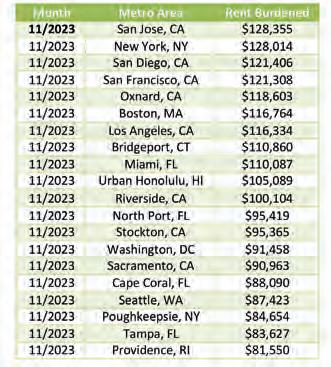

BOARDROOM BASICS AND BEYOND


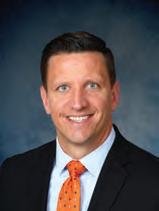
Best Practices for Establishing a Modern-Day Performance Management System
Over time, while completing executive placements for private clubs and when reaching out to top-performing general managers, we have consistently been surprised to discover that in many scenarios there is a subjective process for performance evaluation or not one at all.
This is concerning as we often see a connection between managers who aren’t receiving feedback and managers who are being let go from their positions.
As we noted in Part I, “It’s YOUR Club … But It’s MY Life!” (BoardRoom magazine, January/February 2024), clear communication and alignment of initiatives are essential for a GM’s success.
Transparency is vital for a new GM and it is equally as important to maintain that transparency as time goes on. There should not be any blind spots for the club’s leader, and without regular feedback on performance or a system in place, there likely will be.
While some managers may be comfortable not having a specific and measurable review process, we see that top-performing clubs and their executives have formal annual goal-setting/feedback processes and meet twice annually to review these goals. These are reasons we believe managers should instigate the implementation of such practices:
• With a formal system in place, there’s no denying that the review is fair, mutually agreed upon and measurable. The system also helps avoid challenges presented by board turnover.
• Without a review, the GM doesn’t know the perceptions, priorities or preferences of others, and this creates blind spots. When the GM is made aware of blind spots, they can then work to communicate better or overcome these situations.
• In the absence of measurable goals, there is the risk that an uneducated president or board could deny a portion of the GM’s bonus simply based on their opinion(s).
• Accountability at every level is becoming mainstream in businesses today. It is only a matter of time until a board member or club president begins to question the process.
• The best GMs in the business seek feedback and strive to constantly improve. Seeking feedback is proactive.
Would the GM rather the board/executive committee/ club president design the review process, or would the GM like to lead that charge?
• As feedback becomes more prominent with younger generations and in business practices, allowing feedback to flow through the entire organization will become increasingly important to club success.
We recommend the GM and club president/executive committee calendarize the review process so it isn’t forgotten about. At the beginning of the year, goals should be established together, then reviewed mid-year review and at end-of-year.
Managers and presidents must understand the importance of these meetings as they create synergy and avoid disconnects in club leadership. We believe these conversations should be kept to a group no larger than the executive committee, and the criteria should be determined and agreed upon by the GM, the club president and/or the executive committee.
While some clubs base a GM’s bonus 100 percent on financials or on beating the budget, we believe that is a mistake. We also have seen bonus potential of up to 50 percent of a GM’s annual salary and some with no bonus incentive. We recommend a bonus potential equivalent to 20 percent of the GM salary and based on measurable and mutually agreed upon goals.
The GM should have some input as to what he or she is being reviewed on and by whom. Those involved in the process should be a select group of objective people who know and understand the GM and the criteria based on agreedupon areas. The most common areas include:
• Member satisfaction/Net promoter score – Must have surveying in place for one year
• Employee satisfaction/Net promoter score – Must have surveying in place for one year
• Financial management
• Membership management – Net growth/Waitlist management
• Human capital management
• Capital management
• Strategic leadership




A Decade of Change! What Does the Future Hold for Jeff Morgan, FASAE, CAE, and the Club
Management Association of America?
It’s been 10 years....10 years since Jeff Morgan became CEO and President of the CMAA...The Club Managers Association of America at the time.
It’s been a time of change, so how has the CMAA under Jeff’s leadership, now the Club Management Association of America, evolved? What has CMAA accomplished in that time? What are the hot-button issues, and what does the future hold for both CMAA and private clubs?
Here are some of the questions Morgan was asked during an interview with BoardRoom’s publisher, John Fornaro and editor Dave White.
BRM: The CMAA was formed almost 100 years ago and focused exclusively on club general managers. How has CMAA evolved, and what has been the impetus for change?
JM: Over the years, CMAA focused on education and resources for club management professionals who were GMs, and then it expanded to those aspiring to be GMs, mainly individuals in the food and beverage department.
I was fortunate to come in at the right time because there was a lot of change going on, and CMAA could be part of embracing that change and evolving for our members’ needs. From a club standpoint, part of that change was that clubs were not necessarily growing in number, but they were growing in sophistication in their operations.
We started having conversations at the board level that the Club Managers Association really is not what we are; we are a club management association. We are a bigger community. And Burt Ward, CCM, CCE, who was a president in 2006, said, “Oh, I tried that; we tried to change the name to club management,” and he said the members killed it at the time.
We discussed it, and the more we talked about it, the more the members said, “Well, that makes perfect sense.” So, we put it up for a vote. That year, we had two or three different things to vote for, and one of them was changing my position as well because I used to be the CEO of an association.


I felt those members elected to the board should become chairman, and I should be the president and CEO, to align ourselves more with where the world was going. Club Management Association of America was approved with 98 percent of the vote, and my title change was approved with 92 percent.
Over the past decade, CMAA has grown to serve many more club management professionals, beginning with its name change to replace “managers” with “management” to better reflect all that we do to serve club professionals. In concert with this change, we rebranded CMAA and our CMAA Chapters with one logo, so the CMAA name and logo is synonymous with club management everywhere CMAA is mentioned.
With this change, CMAA began growing its professional communities –starting with our existing member interest groups, including the Wine Society, Women in Club Management, Yacht Club Managers, and our Golf Council.
We have added CMAA communities like Club Wellness, Communications, and Club Chefs as homes for club professionals who serve vital roles within their clubs. We support these club professionals in their specialized roles, which helps the entire club succeed, including the top club professionals.
We have now created exclusive online communities and in-person events related to clubs’ functional areas. We have also added specialized programs unique to board governance and capital improvements. All these programs are designed to help clubs and club professionals succeed in their roles.
Our focus at CMAA is education, information, and community. CMAA’s core certification program has been overhauled and updated continually during the last 10 years to keep it in sync with the changing competencies of club management. We have broadened the licensing of the Certified Club Manager (CCM) certification to span six of seven continents and be the key certification requirement globally for club professionals.
BRM: Is this evolution because the private club industry has changed in recent years?
JM: The club has become and continues to evolve toward this atmosphere of a lifestyle club, bringing together better health, fitness, nutrition, mindfulness, richer community, and more happiness for club members by integrating or leveraging the various areas of the club to create exceptional experiences for all.
New sports have been added to clubs, existing golf and racquet sports upgraded, fitness evolved into wellness, clubhouses modernized and food and beverage standards raised to meet the current expectations of members. It has been a renaissance of sorts for clubs and the growth in waiting lists
bears out the success of clubs who continue to invest in the member experience. In some respect, that is exactly how CMAA sees its mission – continually investing in the members’ professional journey to help all strive for excellence.
BRM: One of the comments over the last 10 years, and not just on the more personal side, was that you didn’t come from the club industry. So, it seems, listening to you, there were advantages to that. You saw opportunities that maybe someone from within might not have seen.
JM: It is hard to replace a long-term CEO with someone new; it’s a bit of a kiss of death. I love a challenge and I saw a lot of opportunities coming in here, so I didn’t have a problem with that. But what I realized a couple of years in is this: Would you hire a member to run your club? If I ask any member of CMAA, they will say absolutely not, they’re not a club management professional. How could they? So, it’s the same thing with the association. Should you hire a member to run your association?
They’re not an association professional; they’re a club management professional. So, the goal of an association professional – and I know meetings, education, all the compiled research, all those things – is figuring out how to marry that professional knowledge with the association knowledge. That is why we have many committees and task forces, and the board is leveraged in all that. I’m not the subject matter expert; they’re the experts, but I know how to take the knowledge they’re seeking and apply it to deliver the education, resources and experience that they need for career success.
BRM: So, you saw that opportunity?
JM: Yes, and as you know, it’s not about me, but I’m a big believer in John Kotter, a Harvard professor and an expert on change. One of his beliefs is that to make change, I’m just the pied piper out there, planting seeds of concepts and seeing where they go. We were challenged because we were doing everything the same way; our evolution had stalled. It was a time to review our offerings. We went through everything systematically, looked at it, and asked, “Does this make sense? What could we do differ- ➤
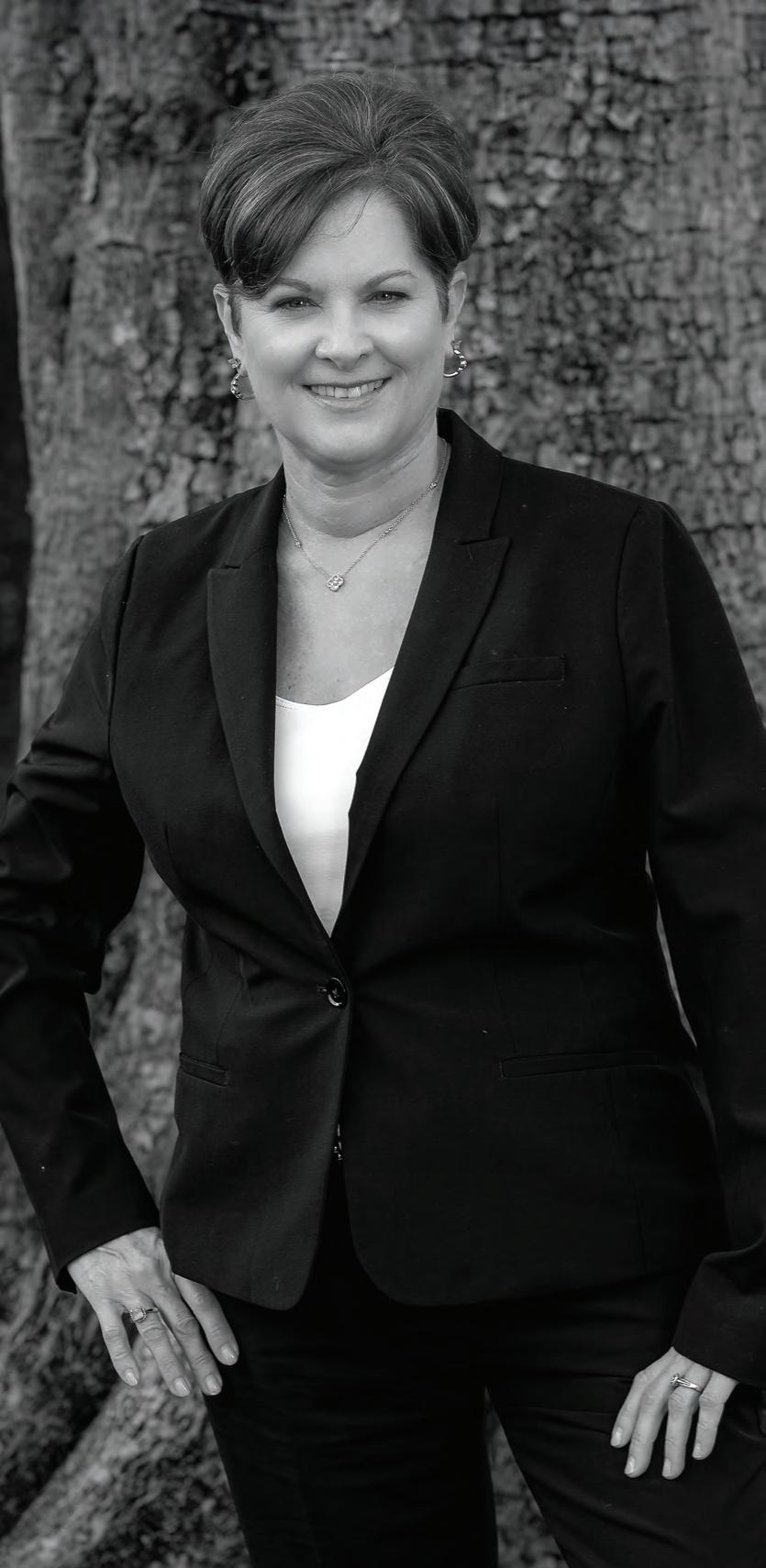



ently?” One of the things that the National HQ staff was not privy to were the financial details. I empowered them; this is yours. And again, this is the pied piper leading; it’s not me telling or commanding down; we’re teaming together, so let’s figure this out. And so, we started going through what we needed to do to put everything in order.
I arrived at CMAA excited about moving to an association that was tired in many ways and was dealing with the retirement of a 25-year CMAA CEO. However, I quickly learned that CMAA and club management professionals are special. The members care about the national headquarters staff team and the association. They give countless hours to the association to help their peers. The CMAA members are experts in so many things I am not. I have great admiration for club management professionals and their craft, yet I have skills they do not.
It has been an amazing partnership. I truly love the club business, the members, the profession and the industry. CMAA has gotten into my blood and my work has become about the passion for success of CMAA and its members. What is so cool is that I am just one of 30 professional staff members who feel the same way. It may be work, but I have never been more fulfilled or enjoyed work more.
BRM: So, when they brought you on board, the thought process was, hey, we need someone who knows how to run an association, correct?
JM: I credit the foresight of the board of directors at that time. Damon DiOrio, CCM, CCE, was the president, and Rick Bayliss, CCM, CCE, and Tony D’Errico, CCM, CCE, were serving on the board. I credit them with really taking a leap of faith. I remember being interviewed and I went through a very reputable national search firm hired by the CMAA board of directors and the search committee. In my world (at the time I was CEO of a financial association), if you used a search firm, you had to get approval from your board to interview. I went to my board, and they said, “Oh sure, go ahead and interview. But you’re a finance guy, you like the financial associations. But what a cool thing to interview for.”
I came into the interview, sat down with the committee and said, “Here’s everything I see is wrong. There’s stuff that doesn’t make sense here and looking at the programs, these things don’t make sense.”
This is not how an association should run. And I wasn’t necessarily being critical...I was being matter of fact as I see it and here are the problems I see.
I remember the search committee members saying when we finished the interview, “Thank you very much. We appreciate you coming in and being
so honest and telling us.” I was surprised with their response given my evaluation of the current operations. After I got home that evening, the search firm called me and said, “You’re the top candidate.”
I came in for the second interview, and ultimately, they wanted to hire me, so I had to meet with the board of directors. I said, “We’re going to have a meeting immediately and come up with a strategic plan.”
I did a day-long facilitation with the board, and basically, it was like, “We’re going to be transparent and communicate. We’re going to look to the future and listen and understand where we want to go, and we’re going to fix the operations.” Those three goals guided our efforts for the next two years.
And then we did a strategic plan that was co-created and crowdsourced. We began with a full membership survey and then brought all the leaders in from all the chapters. Again, this pied piper mentality. If everybody is part of that conversation, everybody is going to buy into it.
I worked with Damon DiOrio as president for half a year and Tony D’Errico for the next full year. We had a lot of tough decisions to make. They trusted me once they understood; they trusted where we were and carried my water for me.
The more, as a community, we learn from each other and take the best ideas, the better all clubs are lifted to be better in what they do. That benefits everybody. And CMAA is at the core of that community aspect. And I mean, that is our secret sauce: community. The education is great, but ultimately, its community, right? The selfish benefit to the club members is they get a more educated and informed GM/COO/CEO and management team, which in turn provides them with a better experience and a better financially run club.
BRM: What’s your view of the GM/COO/ CEO concepts and their relationship to the CMAA? Where will this lead in the future?
JM: CMAA has been a leader over the past several decades in promoting the concept of GM/COO. That effort continues to evolve as clubs become more sophisticated and more business-like in their operations. Club governance has moved toward focusing on the same things business boards do – strategy, risk, succession, and over-





Mickelson National Golf Club, Canada
The Club at Las Campanas, New Mexico
JOHN R. COCHRAN

sight and letting the club management professional truly be that chief club executive.
What I find most exciting is we have seen a few clubs move toward a club CEO model. While this is still a minority, it shows how clubs can become completely business-like in their governance and operations – driven by highly skilled strategic club executives using data and analytics, among other tools, just like businesses.
While the core focus of club management professionals is taking care of their members, this is done with the marriage of art and science and is beginning to move toward the CEO model more and more. Whether this leads to all chief club executives being called CEOs is unlikely in the near future, but it does mean that we are moving forward in club governance and operations with more club CEOs each year. This shows the success of the club management profession and its positive impact on the club.
BRM: Thirty-five percent of families have and never will have children, up from less than 20 percent in mid1980. This is a significant demographic change over the past two decades. How will this impact clubs over the long term?
JM: In our archives, we have a letter from a past CMAA president during the 1980s that says clubs are doomed because these baby boomers are coming in and changing what clubs are doing, and it’s gonna kill private clubs. And families were the big thing. I think we have been so family-focused that, again, our heads are down and we need to make sure we understand, OK, that’s great, but the demographics show there are more and more childless families. Their needs may be slightly different. I don’t know or fully understand the impact of this, but I want to start that conversation and that’s my role.
BRM: It is because childless families may have a lot more money.
JM: You’re absolutely right. It could benefit the clubs, just as hybrid work has benefited clubs.
It’s also the Gen Z folks. Those without kids are paying more and more for experiences. They care less about material things and more about experiences, which again plays right into clubs. I’m very bullish on clubs, as I know you are, too. We’re at an amazing point in our evolution as a society and I think clubs serve a key role and will continue to do that. Gen Z is much more focused on mental health challenges, being good stewards of the world and doing good in the world. So, do clubs have a bigger purpose in the community that should be discussed?
I love my members. I love what I’m doing. And while it is a job, I have a real passion to help. I want to see all of them succeed. It’s very gratifying. I mean, I skip to work every day because I get to be in this space.
I joined a club after I started at CMAA. I had always been in the club space because I dealt with the C-suite in Fortune
500 companies and Wall Street. But you know, I care for these people and they care for me. It’s contagious and my team feels that way too.
BRM: CMAA’s 100th anniversary is coming up in 2027. How much has the industry changed over the years, and why? Are there any aspects of the industry that have remained the same?
JM: Here’s a sampling of the education sessions offered at CMAA’s first Conference in 1927:
1. Why Clubs need a General Manager?
2. Cost Accounting for Clubs
3. The Woman Club Manager
4. Purchasing Practices for Clubs
5. The Dead or Inactive Member in a Club
What has changed? Clubs are no longer wrestling with the need or value of a club manager. They know they need it and there is no distinction between men and women – all are just club professionals.
While purchasing practices at a club are much different than they were 100 years ago, they are still a key focus area of the operation along with the staff team. I suspect many clubs 100 years ago had bookkeepers, so cost accounting was a new skill clubs were wrestling with. Today, this is no longer a new skill. Our club CFOs have a firm grasp on this and all aspects of management accounting.
Today, our accounting challenges are focused on choosing the best software, capital dues modeling, financing structures, analytics and membership categories. Finally, I am pleased (tongue in cheek) to see we have a much better understanding of who is on our membership roles at the clubs and truly know if someone is no longer living. That wasn’t the case in 1927.
BRM: Can you give us some background related to your family and family involvement in the industry?
JM: I am fortunate to have been married to my wife, Susie, a critical care nurse, for more than 40 years. We have two children in their mid-30s. We have traveled extensively as a family, as we thought it was particularly important for our children to understand the world is full of diversity—in looks, cultures, thoughts and beliefs.
If we leverage this diversity, we will be better people and have a better society. Both my children got their start in association management early in their careers. I was pleased to see them do that, as it gave them great exposure to so many professional opportunities. My son has since moved on to sales. My daughter has followed in my footsteps and sees association management as a career, having worked for three different associations. She’s now with the Urban Land Institute In D.C., which is focused on green buildings and urban planning.
It has been fun to watch them grow and thrive. I could not be a prouder Dad. BR
“We recently engaged KK&W, and specifically search executive’s Marcie Mills and Michelle Riklan, to do a search for our Assistant General Manager and Chief Financial Officer respectively. From start to finish the ladies exceeded expectations, were very flexible and adapted easily to the ebb and flow of a startup operation. They were able to bring several qualified candidates to the table and, at the end of the searches, we were able to retain the candidates of our choice. If we have additional needs in the future, we know that KK&W is just a phone call away.”
Eric J. Dietz, CCM, CCE, PGA, General Manager/CEO The Tree Farm Operating Company, LLC

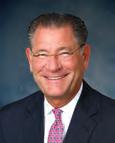






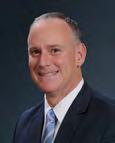




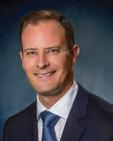






TO BROWSE


Specializing in GM/COO, CEO, AGM, Clubhouse Manager, Food & Beverage, Financial, Golf, Culinary, Agronomy, Racquets, Human Resources, Fitness & Wellness, Membership/Marketing Searches.

RICHARD KOPPLIN KURT KUEBLER THOMAS WALLACE
JODIE CUNNINGHAM CHRIS DECHILLO
J. G. TED GILLARY
MICHAEL HERD
MICHELLE RIKLAN
MARCIE MILLS
ANNETTE WHITTLEY ARMEN SUNY
MICHAEL SMITH
LEN SIMARD
PAUL LEVY SAM LINDSLEY
LAWRENCE MC FADDEN
EXECUTIVE COMMITTEE

RITA BARETTO
Rita Barreto is an engaging, motivational speaker on the national stage. She also has 30-plus years as an award-winning human resource executive for a Fortune 500 company. She offers customized, industry-specific consulting services to navigate change and build an agile and thriving company culture. Don’t hesitate to visit toptierleadership.com, and then give Rita a call to book a free 20-minute consultation.
Clubs Embrace Transformational Leadership Development
For 28 years, BoardRoom magazine has been an essential resource for club managers, offering them insight into providing an exceptional member experience.
Add in club managers’ responsibility for instituting sound fiscal practices and initiating programs to retain a motivated staff. It’s a tall order and requires investing in leadership development at the top levels. I have delivered countless keynote speeches to professional organizations as a leadership consultant. Additionally, I have served as a strategic advisor to numerous private and public companies and clubs wanting to reshape their organizational culture and structure.
Honestly, I’ve lost track of the volume of calls asking for leadership development assistance. These conversations are quickly followed by a litany of frustrations, such as turnover, morale, decreasing customer service and loss of income. If you want to gain a competitive advantage, dig deep into the changing dynamics of employee expectations and the ever-evolving role and mindset of what leadership requires in today’s work environment.
While individuals may have innate leadership qualities, becoming high-value leaders requires rigorous, ongoing development and training. Forward-thinking boards and CEOs recognize that leadership development is critical to their success.
Think about how you feel about leadership development: Do you view it as an investment or a cost? Current ROI studies speak volumes – where employers see an average of $7 return for every $1 spent on training.
Effective leadership cannot be overstated. It is the cornerstone upon which organizational growth, innovative efficiencies, revenue growth and productivity are built. Clubs and organizations that embrace leadership development produce measurable benefits. Done right, it delivers an impact that transforms the workforce from top to bottom.
BELIEVE THE RESEARCH ON LEADERSHIP DEVELOPMENT
According to research conducted by the Society for Human Resource Management, organizations with strong leadership development programs report higher levels of employee engagement and retention. Specifically, organizations with high-quality leadership development programs were found to have:
• 5 times higher shareholder returns
• 2 times higher revenue growth
• 1.5 times higher profit margins.
Overall, these statistics suggest that effective leadership development benefits employees and the bottom line of organizations and private clubs.
WHAT IT TAKES TODAY TO BE A GREAT LEADER
Times have changed and leaders are faced with unprecedented challenges, from engaging remote workers to competing from a small talent pool with organizations that can provide more flexibility and benefits.
Leaders must embrace a mindset that they can work through challenges and position their clubs as the place to be. They must be passionate about building workplace cultures where employees feel valued, challenged and respected. Focusing on employees’ mental health and well-being is now added to the list of leadership priorities. Leaders also need to become emotionally intelligent leaders. What does that look like? It’s a leader who shows compassion, is excellent in communicating in diverse ways, understands the uniqueness of different generations and regularly coaches others.
It’s important to note that coaching isn’t micromanaging. It’s becoming a pro at asking questions. I regularly coach leaders to openly share mistakes they have made and encourage others to do the same. It is some of the best training you will ever get, and it demonstrates vulnerability on the leader’s side.
Leaders must also be self-aware. The stories you tell speak volumes about what’s important to you. Becoming an effective communicator should be on top of everyone’s list of skills to build in 2024 and beyond regardless of their position.
Be sure to collect stories to share with others. Stories are impactful in driving home a point and are often remembered more than an indicator chart. A quick tool to use when crafting your story is story, point, action, or SPA.
Develop memorable stories about the club, customer service or the need for innovation, and be sure each story has a point. Bring your audience into your story (action) by saying something like this: “What about you, what are you doing to improve our customer service?”
WHY LEADERSHIP DEVELOPMENT IS IMPORTANT TO YOUR CLUB’S SUCCESS.
Opportunity for self-reflection. The day-to-day grind typically doesn’t allow time for leaders to pause and reflect on their purpose and evaluate on how they lead and create goals for the future. Many leadership development programs include assessments that help leaders crystallize their purpose and re-imagine the kind of leader they want to become. As a result, a reduction in stress and renewed energy surfaces.
Model the importance of development. When you work in a fast-paced club environment, it’s important that club managers and department heads continuously sharpen their skills. It demonstrates that the club has a culture of continuous learning, and it serves to motivate employees in the knowledge that opportunities for advancement exist.
Succession planning. It’s common to work with individuals who have gone from peer to boss in the club environment. The good news is that there are internal opportunities for growth, reducing the need for external hiring. Identify internal talent and nurture the development and growth of these individuals.
Leadership development is not a one-time event. It’s a lifelong process focused on creating a culture of excellence and exemplary customer service. Are you investing in leadership development? BR

REDEFINING CLUB EXCELLENCE
Cobalt Software brings clubs into the future with its next generation all-in-one best in class solution.
Streamlined Operations, Unmatched Efficiency!
Experience hassle-free operations and reclaim valuable time with Cobalt’s Award-winning comprehensive solution. Welcome to the next generation of club management!

www.mycobaltsoftware.com info@mycobaltsoftware.com | (561) 453 - 0200
EXECUTIVE COMMITTEE

Dr. Ronald F. Cichy, O.M. is professor emeritus, Michigan State University. He can be reached via email: cichy@bus.msu.edu
Leadership Lesson from Johnny Fly
When your name is Johnny Fly and you are the leader of the Johnny Fly Trio, one of the signature songs that you play is “Beer Barrel Polka” (“Roll Out the Barrel”).
This dance tune is based on the European success of “Skoda Lasky” by Lew Brown, Wladimir A. Timm, Jaromir Vejvoda and Vasek Zeman. Dance tunes, particularly polkas, are designed to be fun and make you happy.
Here are some of the lyrics:
“ … There’s a garden, what a garden, only happy faces bloom there … “
The garden: Johnny Fly, my grandpa, was a gardener and a naturalist. His massive backyard garden had a two-foot wide grass path through the middle; he planted crops in the rest of the space. The garden included corn, raspberries, squashes, tomatoes, two types of pear trees and potatoes. Everything that you can imagine grew there. And we ate it all.

Johnny Fly liked to share his yield from the garden with relatives and neighbors. Sharing was fun because when you share, particularly food, your soul gives to the other’s soul. Happiness increases in all involved. Some of the yield was also “put up” in canning jars to be available during the cold winters in Upper Lower Peninsula Michigan.
The Trio: Johnny Fly led a four-man band known as the Johnny Fly Trio. The Trio played polkas, waltzes and other popular tunes of the day at weddings, festive events and other gigs. Johnny Fly played the concertina and sang lead voice. People came from miles around to hear and dance to the Trio.
“ … Oh, there’s music and there’s dancing … When they play a polka, they all get in the swing …”
The purpose of the Johnny Fly Trio was to share happiness by giving people a fun-filled afternoon. To have them forget their cares and woes, if only for an evening. And smile. And dance and have fun.
Barrels of fun
“ … Roll out the barrel … We’ll have a barrel of fun …”
Johnny Fly knew all about barrels because he was the chief cooper (wooden barrel maker) for the Morton Salt Company. As a highly trained craftsman, Johnny Fly made the barrels the salt was shipped in. Barrel making was his full-time day job.
The run: Fun! Fun! Fun!
“
… Roll out the barrel …
We’ve got the blues on the run …”
Think about how much running everyone does in their club in a typical shift. As chair of the club’s sustainability committee, you are required to meet with committee members and select members of the board of directors. You may also be running to meet talent assigned to sustainability initiatives. Perhaps you are positioning yourself to be elected a member of the board of directors or even board chair.
Music: “… Zing. Boom. Tararrel! …
… Ring out a song of good cheer …”
Johnny Fly loved to whistle, particularly when in his garden. Now that I look back at it, he was “practicing” to later play the tune on his concertina. This whistling and practicing made the tune a permanent part of his playlist. He taught his fun music to his Trio members.
“ … Now’s the time to roll the barrel for the gang’s all here …”
My grandpa had a plaque displayed on his living room wall. It read: “We get too soon oldt, and too late shmart.” He had finished school with the fourth grade to go to work and help support the family. He is one of the shmartest men I have ever met. And he had a lot of fun each day.
Application to you: Stop for a few minutes and ponder how much fun you have in your activities, work and relaxation. Would others describe your place of work, your club, as a fun place to be? Do you hear others laughing? Are members having fun? Are they releasing some of the pressure accumulated during their workday? Does talent, with careers at the club, see the fun and pass it on to the members?
You, too, can create fun times like Johnny Fly and his Trio did. Be shmart about it. BR

RONALD F. CICHY






THE JONAS CLUB SOFTWARE MANAGEMENT APP
Designed for Club Executives and Department Managers, the Jonas Club Software Management App empowers you to see the latest activities at your club, look up members, view live reports, communicate with staff, and keep a count of your inventory all within a few taps on your phone. Your Jonas Club Software system, always within reach.
EXECUTIVE COMMITTEE

MICHAEL CRANDAL, CNG
Michael Crandal, CNG is co-author with Gabriel Aluisy of the groundbreaking book “The ABCs of Plutonium Private Club Leadership.” www.plutonium.club. He can be reached directly at (760) 464-6103
The Best Private Club Presidential Advice I Ever Received
Over a 35-plus-year career in private club leadership, I’ve served members and staff at several premier clubs.
There’s no question that the confidential advice received from dynamic club presidents contributed to my career and the success of each club. Perhaps the following may be meaningful to the leadership at your club as well.
While difficult to put into any sort of order of impact, here are the top three that come to mind.
1) Westwood Country Club – St. Louis, MO/ President Walter Stern: Immediately after a favorable annual performance review with the executive committee, Stern asked to meet with me privately for a few minutes. He wanted to offer some advice that would have a lasting impact on all facets of my leadership in the private club industry.
He asked me this question: “How many classes of membership should a club have?”
Well, I knew that our club had almost 10. But I also believed that a numerical answer to his question would depend upon the uniqueness of every club. He saw my hesitation and quickly gave me the correct answer that I should never forget.
He told me, “Michael, every premier private club should have only one class of membership. First class! Just make sure that everyone on your team knows that everything needs to be first class.”
In an instant, the wisdom shared hit home. He was spot on. He quickly wrapped it up by saying, “As an example, let’s say a member wants to host a weenie roast. Don’t think of this as something a premier club would never do. No. Instead, you just make sure it is executed as a first-class weenie roast. Have this approach to everything your team does. Remember, there is only one class of membership –first class.”
From that day forward, this presidential advice guided my career.
2) Exmoor Country Club – Highland Park, IL / President Milt Lynnes: Before his first board meeting as president, we had a private dinner together off campus. He shared two concepts he felt were important in any successful private club.
The first bit of advice: “Nothing important ever happens at the club.”
I was stunned. This was my career that I loved dearly and was fiercely devoted to. And my new president tells me it is not important.
He laughed and explained his thinking. “Michael, every member basically belongs to have fun. To enjoy themselves with family, friends and associates. Yes, weddings, events and all aspects of day-to-day operations are all very important. But, we are not curing cancer, sending rockets to Mars or establishing world peace. In other words, keep things in perspective.”
The second bit of advice: “Do not ever allow artificially low dues in the operating budget.”
My president shared what his response would be if any member ever came to him and began a conversation with words like “But, Milt – everyone can’t afford this.”
He said he would always listen to what they had to say and respond by saying, “And – your point is?”
If they persisted, he would listen further and then say, “Yes, I do hear what you are saying. But, again, what’s your point?”
I got Lynnes’ point. Dues levels must be sufficient to support first-class operations.
3)
Thunderbird Country Club – Rancho Mirage,
CA / President Bud Gravette: My president stopped by my office after Saturday morning golf. He shut the door, sat down and said he wanted to ask my opinion on something.
He asked me, “Michael, if you had to prioritize – actually list from top to bottom – what are the most important areas of club operations?”
He didn’t let me squirm too long. He smiled and gave me the right answer. “The area that any member may be using at any point in time. To that member at that very moment in time – that is their very most important in all of club operations!” To summarize Gravette’s wise advice, “Every area of club operations, at all times, must be treated as priority No. 1.” BR

From pre-hire to retire, ClubPay streamlines operations with a custom suite of outsourced Payroll and HR solutions to meet your club management needs.



Andrew Miller, Account Manager
Colby Spooner, Account Manager
EXECUTIVE COMMITTEE

WHITNEY REID PENNELL
Whitney Reid Pennell, president of RCS Hospitality Group, is a celebrated management consultant, educator, and speaker. RCS specializes in strategic planning, operations consulting, food and beverage management, executive recruitment, and training programs. RCS has been recognized 11 times with BoardRoom Excellence in Achievement Awards. For more information, phone (623) 322-0773 or visit the RCS website at www.consultingrcs.com
Navigating 2024 Private Clubs at the Intersection of Trends, Workplace Challenges and Strategic Evolution
In 2024, the private club landscape finds itself at a crossroads, influenced by a confluence of factors ranging from evolving workforce dynamics to the ever-shifting demands of club members.
Adding a layer of complexity to this landscape is the backdrop of an election year, a time when economic trends and contentious conversations often take center stage. In the face of societal trends and political discussions that can be polarizing, one cannot help but ponder the potential implications for private clubs.
There is an essential need for increased training for staff members to navigate the challenges of remaining neutral in the face of contentious conversations. With societal trends and politics becoming intertwined with daily discourse, private clubs must equip their staff with the skills to foster inclusive and welcoming environments.
Training on these topics is critical. Your training should promote neutrality, respect and effective communication, ensuring that your club continues to welcome members of diverse backgrounds and perspectives.
WORKFORCE DYNAMICS: A MULTIGENERATIONAL CHALLENGE
A continuing consideration for private clubs in 2024 is the dynamic nature of the workforce, shaped significantly by the presence of Generation Z. Its members, born between the mid-1990s and the early 2010s, are entering the workforce with distinct expectations, influenced in part by the unique challenges they faced during the COVID-19 pandemic.
As private clubs grapple with attracting and retaining talent from this generation, the shutdown of trade schools and public and private school disruptions during the pandemic have created a shortage of skilled labor. This shortage, coupled with the entry of inexperienced workers into the hospitality industry, raises questions about training expenses and the overall quality of service within private clubs.
Additionally, the shift toward remote and hybrid work options, which gained momentum during the pandemic, continues influencing workforce dynamics. Private clubs may need to adapt their staffing models to accommodate employees seeking flexible work arrangements. The challenge lies in creating a cohesive and productive work environment without sacrificing member service.
MEMBER
DEMANDS: TAILORING EXPERIENCES FOR A DIVERSE MEMBERSHIP BASE
The private club industry has witnessed a shift in member demands, reflecting the diverse needs of a multigenerational and multicultural membership base.
In 2024, clubs must navigate the delicate balance between high-touch and low-touch service preferences, accommodate varied quality standards and provide facilities and service offerings that cater to the diverse demographics within their membership—ranging from grandparents to single members, DINKS and families with young children.
The impact of Generation Z on member demands is particularly noteworthy. Having missed out on crucial social opportunities during the restrictive COVID-19 settings, Gen Z members may seek enhanced social experiences within private clubs while being reluctant to join or have expectations that are financially untenable for the club’s budget.
The challenge here is to create environments that foster interaction and engagement while recognizing the preferences shaped by the digital communication habits acquired during the pandemic.
ELECTION YEAR ECONOMIC TRENDS: NAVIGATING UNCERTAINTY
The economic climate during an election year introduces an additional layer of uncertainty. Historically, election years have witnessed fluctuations in economic indicators, influenced by the unknown of policy changes, government spending and shifting investor sentiment.
In 2024, private clubs must be vigilant and adaptive, understanding the potential impacts on member spending patterns, investment decisions and overall economic stability. Clubs should prepare for potential shifts in member spending habits based on economic uncertainties associated with an election year.
CRAFTING A VISION FOR 2024
As you navigate 2024, thoughtful and reflective strategic foresight becomes imperative. Recognizing the nuances of a multigenerational workforce, catering to diverse member demands and adapting to election-year economic trends while managing a minefield of potentially contentious conversations will be key to shaping a successful future for your club.
Fusing these elements into a cohesive strategy will ensure resilience and appropriate responsiveness as challenges present themselves. Clubs that can weather the immediate challenges while simultaneously taking proactive steps to achieve their vision for the years to come will be the most successful.
Having strategic planning updates and committing to inclusivity and staff training should be topics on your boardroom agendas this year, positioning you for a successful 2024 and beyond. BR





EXECUTIVE COMMITTEE

ROBERT PODLEY
Robert D. Podley, CCM, CAM is general manager at the Colonial Country Club, Ft. Myers, FL. He can be reached at (239-768-7200 or via email: rpodley@Troon.com | www.colonialgolfclub.com
Collaborating Across Departments and Teams Strategies for Xillennial Leaders
In the fast-paced world of club management, collaboration is the key to success. As Xillennial leaders, we understand the challenges of working across departments and teams to achieve our goals.
We know that effective collaboration requires more than teamwork. It requires innovative strategies that bridge generational gaps, leverage technology and foster a culture of communication.
Fostering a culture of communication. Communication is the notorious ringmaster of collaboration chaos. As Xillennial leaders, we recognize communication’s significance in breaking down silos and building strong connections.
By creating a culture of open and transparent communication, we can cultivate an environment where ideas flow freely, collaboration is seamless and everyone feels valued and heard. From organizing regular team meetings to using messaging apps and video conferencing tools, we can ensure that information is shared effectively across departments and teams.
Let’s also encourage active listening, empathy and respectful dialogue, allowing diverse perspectives to enrich our discussions and drive innovative solutions. By embracing a variety of communication channels and promoting a culture of open exchange, we can build strong bonds, foster collaboration and propel our club leadership.
Goal Setting. Traditional goal-setting methods may not always resonate with the Xillennial. That’s why we must reimagine goal setting as an exciting and engaging process.
Let’s create opportunities for collaborative goal setting, where teams from different departments come together to brainstorm and define shared objectives. We can use tools like vision boards or digital platforms to capture and track our goals, making them tangible and inspiring.
Additionally, we can introduce gamification elements, such as setting milestones and celebrating achievements with rewards or recognition. By involving everyone in the process and infusing it with creativity and enthusiasm, we can foster a sense of ownership, motivation and collaboration. Together, we’ll strive toward common goals, break down departmental barriers and achieve remarkable results for our clubs.
Team building. Incorporating elements of friendly competition can energize team building. We can host inter-departmental challenges, like trivia or a scavenger hunt, to encourage teams to collaborate, communicate and showcase their knowledge and skills.
By infusing team-building activities with excitement and a sense of shared purpose, we can create stronger bonds, foster camaraderie and enhance collaboration across departments. Moreover, let’s not limit team building to scheduled events. We can create an environment that encourages informal interactions and spontaneous connections. For example, dedicating space for a communal lounge or game area where employees can relax, engage in friendly competitions or chat over a game of foosball or ping-pong.
These casual interactions can lead to organic relationships and an atmosphere of collaboration beyond organized activities. After all, team building is about creating memories and inside jokes that will keep us grinning through those marathon club meetings.
Embracing technology. In addition to communication, technology can play a significant role in project management and task coordination. Project management software, such as Asana or Trello, allows teams to create, assign and track tasks, ensuring transparency and accountability across all projects. With a centralized platform, everyone can stay updated on progress, deadlines and dependencies, eliminating confusion and facilitating collaboration. Moreover, embracing technology means exploring automation and digital solutions to streamline repetitive and time-consuming tasks. From automated email responses to workflow automation tools, we can free up valuable time and energy, enabling team members to focus on highvalue activities that require critical thinking and creativity.
Let’s not forget the power of data and analytics in driving informed decision-making and collaboration. By leveraging data visualization tools and analytics platforms, we can gain insights into performance metrics, member behavior and market trends. These insights can guide our collaborative efforts, allowing us to make data-driven decisions that lead to innovation and success.
So, my fellow Xillennial leaders, let’s dismantle those communication barriers, infuse our goal setting with a splash of excitement, embrace perspectives like a mixtape of perfectly timed recordings of diverse radio hits, plan team-building escapades that rival theme parks and leverage technology to enhance our collaboration.
Together, we’ll create a club management experience as exciting as discovering a bar or cell service on a deserted island. Cheers to Xillennial leadership and collaboration, where tradition dances with innovation and laughter becomes the secret ingredient to our success. BR


EXECUTIVE COMMITTEE

JOHN SCHULTZ
John Schultz is the chief executive officer of Club Leadership Alliance. Founded by Kopplin Kuebler and Wallace, Club Benchmarking and McMahon Group, Club Leadership Alliance is a premier organization dedicated to providing resources, education and support to club leaders across the industry. With a mission to empower clubs to thrive and rally club leaders around best practices, CLA fosters a community of collaboration and innovation. John can be reached at (704) 309-3015 or john@clubleadershipalliance.com
Club-Specific Portals Offer Many Benefits
As a volunteer governing board member at a private club, you know – or will soon learn – that you’ve taken on an immense responsibility.
Board members must be informed leaders who are thoughtful, strategic stewards of their clubs. At Club Leadership Alliance, we empower club leaders to rally around the core values and best practices we’ve identified as characteristic among – and essential for – relevant, enduring clubs.
An online, cloud-based, secure board portal is a relatively new tool that advances club governance and helps boards succeed. It’s a document repository and a one-stop hub for the material and tools you’ll need to make the most of your valuable time and maximize your contribution as a board member.
Implementing a club-specific board portal offers your club numerous benefits and can significantly enhance the efficiency and effectiveness of governance and operations.
Popular board portals include Board Effect and Boardvantage. The CLA Board Portal is designed specifically for the private club industry.
I want to share some compelling reasons to use this helpful resource:
• A board portal streamlines communications and enhances transparency. It provides a secure and accessible platform where board and committee members can collaborate, share documents, exchange ideas and communicate in real time. This eliminates the need for multiple email threads, physical documents and phone calls.
• This enhanced document management approach is sophisticated yet easy to use. It lets your club store important board information in one secure document repository. Minutes of meetings, financial reports, annual audits, bylaws and other relevant material can be organized and easily searchable. This ensures that board or committee members have instant access to the information they need, reducing the administrative burden and enabling better-informed decision-making.
• Access to documents can be easily managed by “permission-based” protocols. Board portals provide
increased security, protecting sensitive club information. Typically, board portals employ the highest level of encryption protocols, multi-factor authentication and role-based access controls. This ensures that only authorized individuals can access specific documents and features. The heightened security reduces the risk of data breaches and unauthorized information leaks, safeguarding your club’s reputation and integrity.
• Board portals efficiently streamline the entire meeting management process. Administrative staff can conduct date/time polls for meeting availability, schedule and arrange meetings and execute follow-up reminders on one convenient platform, saving significant time and cost. You can create meeting agendas, distribute pre-meeting materials and track attendance electronically. Verifying board and committee member engagement is vital to good governance.
• To improve decision-making during meetings, board members can access historical documents in real time, take collaborative notes and annotate materials within the portal. This ensures that everyone is on the same page, promotes focused discussions and facilitates the timely completion of agenda items, leading to better governance and strategic thinking.
• Adopting a board portal can significantly reduce administrative overhead and associated costs. By eliminating the need for physical paperwork – get rid of the three-ring binders, printing and mailing – your club can save on printing costs, postage and storage space. Also, streamlined communication and document management features can save valuable time for both board and committee members and administrative staff. Our analysis has shown that the cost savings exceed the annual cost of the portal.
Historically, private clubs have been slow to adopt new technology, but that tide has turned. This is a significant improvement. From online tee times and dining reservations to exercise classes, you’ve likely already learned how technology can improve the member experience. Board portals are the newest addition to enhancing the ability of board members to be excellent stewards of their clubs. And they are welcome tools I hope you’ll take advantage of. BR





EXECUTIVE COMMITTEE

CHRIS KULINSKI
Chris Kulinski, PGA is a PGA career and recruitment consultant serving the Western, Central, and Northeast New York sections. He can be reached at (561) 366-2791 or ckulinski@pgahq.com
How the PGA of America Is Helping PGA Professionals Attract the Next Generation of Golf Industry Employees
As the golf industry evolves, attracting the next generation of employees to work in our industry has become a priority for employers seeking fresh perspectives and diverse skill sets.
To entice young people to the world of golf employment, innovative strategies centered on inclusivity, technology, career growth and workplace culture are crucial. These strategies can also be used to attract members to private clubs.
The PGA of America has a dedicated recruitment team focused on educating the next generation about the opportunities within golf and the value of becoming a PGA member. This team attends events and has dedicated resources for the public to connect with the PGA of America recruitment team (pga.com/workingolf). These resources along with educational opportunities for PGA members are helping golf facilities find employees with innovative ideas.
EMBRACING TECHNOLOGY IN OPERATIONS
Golf courses are increasingly integrating technology into their operations, making it essential for prospective employees to be tech savvy. Facilities can leverage this trend by highlighting opportunities for tech-driven roles, such as course management software experts, social media marketers or data analysts. Demonstrating a commitment to staying at the forefront of technological advancements not only attracts younger tech-oriented candidates but also streamlines operations and enhances customer experiences.
OFFERING CAREER DEVELOPMENT AND ADVANCEMENT
Young professionals value career growth and development opportunities. Golf employers can attract top talent by showcasing clear pathways for advancement within their organizations. Using the PGA of America’s Career Services Department and recruitment team allows PGA members to advance their careers and show the next generation the resources available when you are a PGA member. The PGA can provide mentorship programs, professional development initiatives and certifications in specialized areas within the golf industry. These services communicate a commitment to nurturing talent and investing in employees’ long-term career success.
CREATING INCLUSIVE WORK ENVIRONMENTS
Inclusivity and diversity are vital factors for the next generation of employees. Employers can cultivate an inclusive work-
place culture by implementing policies that support diversity, equity and inclusion. The PGA of America partnered with the University of North Texas to offer “Inclusion, Diversity, Equity, & Access Essentials” training for all of their employees, 41 sections and nearly 30,000 professionals. This initiative allows PGA members to use these resources at their facilities.
FLEXIBLE WORK ARRANGEMENTS
Offering flexible work arrangements is increasingly important for attracting younger employees who prioritize work-life balance. Golf employers can consider options such as remote work for employees working on tournament software, flexible scheduling or compressed workweeks to accommodate the diverse needs of their workforce. Providing flexibility demonstrates an understanding of employees’ needs and contributes to higher job satisfaction and retention rates.
ENGAGING SOCIAL MEDIA AND EMPLOYER BRANDING
Using social media platforms and cultivating a strong online presence is essential for attracting younger talent. The PGA of America’s recruitment team uses social media to attract talent into the industry and to PGA membership. Golf employers can leverage platforms like LinkedIn, Instagram and X, formerly known as Twitter, to showcase their workplace culture, employee testimonials and career opportunities. Engaging content, behind-the-scenes glimpses and interactive campaigns humanize the brand, making it more appealing to potential candidates.
OFFERING PERKS AND BENEFITS
Competitive compensation and attractive benefits packages play a significant role in attracting top talent. Beyond salary, perks like gym memberships, wellness programs, golf course access and educational assistance can differentiate employers and make positions more enticing to prospective employees. Attracting the next generation of employees to the golf industry requires a multifaceted approach that embraces technology, fosters career growth, prioritizes inclusivity, offers flexibility, engages through social media and provides attractive perks. By implementing these strategies, golf employers can position themselves as desirable workplaces for young talent, ensuring a dynamic and thriving workforce within the industry. BR




LEGISLATIVE COMMITTEE

MELISSA LOW
Melissa Low, CAE, is the vice president, communications and advocacy, for the Club Management Association of America. For the latest information on these and other issues affecting the club industry, please visit CMAA’s Legislative Report blog at www.cmaa.org.
2024 Legislative and Regulatory Update: Independent Contractors, Overtime and Seasonal Workers
As Congress addresses outstanding spending legislation and priorities during the first quarter of the year, the federal regulatory agencies have been busy with new proposed and final rules affecting the employment landscape in the club industry.
INDEPENDENT CONTRACTORS
On Jan. 9, the Department of Labor released the final rule to redefine a worker’s status as an employee or independent contractor under the Fair Labor Standards Act. The final rule is almost identical to the proposed rule that was presented for public comment in December 2022, focusing on a six-factor economic realities test to assess the working relationship between the individual and the entity. The proposal earned more than 55,000 comments, including joint comments from the Club Management Association of America and the National Club Association.
This rule officially rescinds the 2021 independent contractor rule that outlined five factors with added weight given to two: (1) the control workers have over their job duties and (2) their own opportunity for profit or loss.
The final rule was effective Monday, March 11. However, lawsuits are pending, which might affect the rule’s full implementation. Under the rule, clubs must consider the following six factors in determining whether an employment relationship exists:
1. Opportunity for profit or loss depending on managerial skill
2. Investments by the worker and the employer
3. Degree of permanence of the work relationship
4. Nature and degree of control
5. Extent to which the work performed is an integral part of the employer’s business
6. Skill and initiative.
Beyond the six factors above, the DOL notes that additional factors may be relevant in a totality-of-the-circumstances approach “if the factors in some way indicate whether the worker is in business for themself, as opposed to being economically dependent on the potential employer for work.”
OVERTIME RULES
On Aug. 30, 2023, the DOL issued a long-awaited proposed overtime rule to adjust the FLSA provisions governing who is eligible for overtime. The rule was last updated in 2019.
Currently, to qualify for exemption from overtime, an employee must meet the salary basis test (paid a predetermined and fixed amount not subject to reduction or variation), the salary level test and the duties test.
Salary threshold (level test): The proposal increases the minimum salary required for an employee to qualify for exemption from the current level of $679 per week, the equivalent to $35,308 per year, to $1,059 per week, or $55,068 annually. However, the DOL also noted in a footnote that the projected threshold for 2024 could be $1,158 weekly, or $60,209 annually (based on the calculation methodology used noted below).
Automatic increases:
• The proposed rule would automatically update the earning thresholds for exempt and highly compensated employees every three years using current wage data
• Specifically, the DOL proposes to update the salary level by adjusting it to remain at the 35th percentile of weekly earnings of full-time non-hourly workers in the lowest-wage region (currently the South)
• For highly compensated employees, the total annual compensation would be indexed as the annualized weekly earnings of the 85th percentile of full-time non-hourly workers nationally.
Duties test: The proposed rule maintains the current job duties test for bona fide executive, administrative and professional employees. Highly compensated employees: The proposal sets the total annual compensation requirement for highly compensated employees at $143,988 per year.
Use of bonuses: There is no change to this category. Employers will still be allowed to use nondiscretionary bonuses and incentive payments (including commissions) that are paid annually or more frequently to satisfy up to 10 percent of the standard salary level.
On Nov. 3, 2023, the CMAA submitted official comments to the DOL regarding the proposed update. These comments focus specifically on the impact on our industry and club operations. The Association requested further consideration from the DOL on multiple factors, including the flawed methodology for the initial update, the unintended consequences of automatic updates and the need to increase the inclusion of nondiscretionary, bonuses, incentive payments and commission. More than 33,000 public comments were submitted. The DOL must now review the comments and prepare the final rule. It could come as early as the second quarter of this year.
SEASONAL WORKERS
In a move that mirrors its actions in FY2023, the Department of Homeland Security, in conjunction with the DOL, announced its intention to release 64,716 additional H-2B visas for FY2024. These visas provide welcome relief for many employers as the first half FY 2024 allocation was already exhausted as of Oct. 11, 2023.
Of the nearly 65,000 visas being made available, 20,000 visas will be earmarked for workers from Columbia, Costa Rica, Ecuador, El Salvador, Guatemala, Haiti and Honduras. The remaining 47,716 visas will be designated for returning workers, those who have received an H-2B visa within the past three fiscal years.
Meanwhile, DHS and DOL continue the efforts of the H-2B Worker Protection Taskforce in cooperation with the White House. The Taskforce has proposed policy options to address threats to the program’s integrity, vulnerabilities for H-2B workers and the impermissible use of the program to avoid hiring US workers. In September, DHS announced a rulemaking proposal implementing program integrity measures impacting employers and increasing protections for H-2A and H-2B workers. BR

COMMUNICATION COMMITTEE

JULIA KELLY
Julia Kelly is vice president of sales and marketing with Troon and can be reached at
jkelly@troon.com.
Crafting Email Messages that Get Read
“If I had more time, I would have written a shorter letter.”
Mark Twain
Although scholars may debate whether or not Mark Twain wrote, “If I had more time, I would have written a shorter letter” more than 150 years ago, the sentiment still stands on its own: It can be time-consuming to craft engaging and compelling messages. Writing out an important communication is only the first step. It’s the crafting that happens during the editing process that is key to productive communications.
Messaging comes at us from all angles in the form of push notifications, signage, voice mail, social media, chatbots, meetings, phone calls and more – all day, every day. But email continues to prevail in the category of “overload.” It has been generally recognized that the first electronic mail was sent in 1971 and by the ’80s its success prompted many software providers to offer email features to their established platforms.
Email (as it became known) was welcomed as an efficient new communications tool, at least until the birth of the unavoidable and repetitive nuisance now known as “spam” in the mid-1990s. Faced with this new threat, users flocked in earnest to programs that would block this content, yet there still seems to be too much email that makes it through.
As a result, our human filters are now more apt than ever to briefly scan and hit the delete button, or simply ignore and delete the message without ever reading the content.
So, where does this leave us in the private club industry, when we’re regularly using email to communicate important information to members, boards and committees, and even our associates? We certainly can’t stop using it, but we can hone our craft to help ensure that more people read our messages.
• Use empathy. Research has shown that we are less persuasive via email than we think we are, because of its lower “compliance effect.”
By its very nature, email is missing the crucial nonverbal cues like body language, facial expressions and inflection that are normally present in face-to-face communications. These cues help us build trust and empathy, which in turn helps us to influence others to engage with and respond to our messaging. If we shift our paradigm to using email as a
two-way dialogue, it forces us to think about engagement. We’re often so focused on pushing out a message that we neglect to consider how it will land for the receiver. Recipients are more likely to read a message (and do what we’re asking, such as take a survey, join a club, follow a rule, book a reservation, etc.) if it conveys a win-win where something is in it for them.
• Don’t muddle and meander. In dissecting the typical email, it usually becomes evident that the key message could have been communicated in at least half the words. And, by the way, although AI could be credited with improving the overall quality of what we read, it has also contributed to the addition of even more unnecessary words.
So, just get to the point. Taking the time to edit out what you don’t need will make what remains even more memorable.
• Articulate your objective(s). Use concise sentences and end your message with a clear and specific desired next step. “Let me know if you’d like to discuss” is not as clear as “Are you free at 2 p.m. to discuss?”
• Spam filtering. If you’re unusually challenged by undelivered messages, it wouldn’t hurt to remind recipients how spam filters work. Anti-spam regulation has been a good thing in so many ways, but one “unsubscribe” will block your messages forever, even if the receiver didn’t intend to do that.
• Is email the right channel? Before pushing send, consider whether or not email is the best way to deliver your message. Would it be more productive to deliver it another way, or at least supplement it with additional channels?
• Layer your strategy and market it. Send a summary reminder of the multiple channels within your strategic communications program at least two or three times a year. This keeps the various channels top of mind and empowers members to seek out the information “they didn’t know about” on their own.
Following these guidelines and best practices won’t just result in a shorter letter. It should make your email messages easier to read and more compelling and effective overall. BR


“After
COMMUNICATION COMMITTEE

LAURA LESZCZYNSKI
Laura Leszczynski is the vice president of marketing and strategy at Strategic Club Solutions. She can be reached at laura@strategicclubsolutions.com.
Bridging the Communication Gap Engaging the Next Generation in Club Life
One of the most significant club challenges today is effective communication with the younger generation. At Strategic Club Solutions, we consistently see a need for diverse preferences in our clubs’ survey data.
Unlike previous generations, where newsletters and bulletin boards were the norm, today’s young members seek convenience, immediacy and a digital-first approach.
The question then arises: How do clubs communicate effectively with a generation inundated with options? Our research indicates that people in their 20s, often labeled as the smartphone generation, predominantly consume information digitally. They are more likely to engage with content that comes to them, rather than seeking it out. This is crucial for clubs aiming to attract and retain younger members.
Every club we work with cites communication as a key challenge. It’s no surprise since research shows the average American is exposed to 4,000-10,000 ads per day.
To address this and stand out, we must turn to innovative strategies, like neuromarketing, which uses psychological principles to capture attention. Incorporating storytelling in digital communications can create a more relatable and engaging experience. Leveraging social proof, like testimonials from peers, can significantly increase engagement.
Adjusting the format also makes a big difference. For example, using video increases engagement. In fact, social video generates 1,200 percent more shares than text and image content combined. Viewers retain 95 percent of a message when they watch a video compared to 10 percent when they read text.
Best practices include a multifaceted approach. Clubs should not only rely on traditional methods such as email and newsletters but also embrace newer platforms, like social media, apps and video content. Personalization is key.
However, beyond the medium, it’s the message. Younger generations are looking for meaningful engagement. They value transparency and authenticity over polished corporate messaging. Clubs should consider hosting interactive sessions, like “office hours” or “town hall” meetings, where members can engage directly with leadership, including the general manager or board members. Informal settings, like coffee or lunch with club officials, can also foster a sense of community and belonging.
When attracting a younger generation through communication, clubs should be aware of several critical “must not do’s.” Avoiding these pitfalls is essential for effective engagement and building a positive relationship with this demographic.
Do not rely solely on traditional communication methods: Avoid relying only on print newsletters, formal emails or one-way communication channels. Younger generations often prefer interactive, digital-first platforms, like social media, apps and instant messaging.
Do not overlook the importance of mobile optimization: Do not ignore the necessity of having a mobile-friendly website and communications. Most younger individuals access information primarily through their smartphones.
Avoid overly formal or corporate language: Steer clear of jargon, overly formal language or corporate speak. Younger audiences often favor a more conversational, authentic tone that resonates more personally with them.
Do not neglect privacy and data security: Be cautious about how you handle personal data. Younger generations are more privacy-conscious, and mishandling data can lead to distrust and disengagement.
Avoid one-size-fits-all messaging: Do not send the same message to all members. Younger generations value personalization and content that speaks directly to their interests and needs.
Do not underestimate the power of visual content: Avoid text-heavy communications without visual elements. Younger audiences are more engaged by dynamic content, like videos and images.
Do not ignore feedback and engagement metrics: Avoid sticking rigidly to a plan without considering feedback. It’s crucial to adapt based on the engagement and responses you receive from younger members.
Do not overlook the importance of social issues: Avoid being indifferent or silent on social and environmental issues. Many younger individuals are socially conscious and appreciate when organizations align with their values.
Avoid being inconsistent in your messaging: Do not be sporadic or inconsistent in your communication frequency and style. Consistency helps in building trust and keeping the audience engaged.
Do not disregard the importance of two-way communication: Avoid making all communications one-way. Encourage and facilitate two-way dialogue, allowing younger members to voice their opinions and feedback.
By avoiding these common mistakes, clubs can more effectively communicate with and attract younger generations, fostering a more inclusive, engaging and dynamic environment. BR

ON THE FRONTLINES

MARK GURNOW
Mark Gurnow is general manager of Superstition Mountain Golf and Country Club, Gold Canyon, AZ.
What Off-Season?
Private country clubs stay open year-round, but whether it’s during the winter months when the course is buried under ice and snow or in the middle of the hot summer, there’s always an “off-season.”
Superstition Mountain Golf and Country Club, a BoardRoom magazine Distinguished Club located just outside Phoenix, AZ, enjoys mild winter weather, so we consider the heart of summer off-peak. Many of our members are snowbirds, and this means a slightly slower pace for us in the summer. While we are finding that more and more members are staying throughout the year, June through August are the quietest times at the club.
That said, anyone who has worked at a private golf club will tell you there’s no such thing as an off-season.
When the membership is quieter and the number of tee times per day dips, the staff at Superstition kicks it into overdrive. Here are a few things we worked on during our off-season this year.
COURSES
We closed one of our two Jack Nicklaus-designed courses and undertook a bunker sand refresh, general bunker maintenance and greens resurfacing. Scott Krout, our longtime director of agronomy, led the major undertakings. Krout has been at Superstition Mountain since 1997, when the first golf course was under construction.
We made repairs to the climate-controlled comfort stations and overhauled the cart tunnels and cart paths. A new set of tee markers was installed, and the team performed extensive trimming and maintenance on the course’s surrounding natural desert landscape.
DINING
We are proud to offer our members an exceptional food and beverage program, from elegant tasting dinners to casual lunches and everything in between. After carefully reviewing our member survey and product mixes, we realized it was time for a change.
We know that our members dine at the club as much as four or five times per week. Dining at any one restaurant that frequently will make anyone tire of the same menu each day. We also found that at least 60 percent of sales in the dining areas came from specials.
This prompted our F&B director to come up with an innovative program that would require our talented F&B department to step things up a few notches. At least half the menu would change every two weeks. The other half would remain constant, keeping member favorites, what we call our “Superstition Staples,” always available.
The off-season allowed us to lay a foundation with the staff, making sure we were fully prepared and had the new, rotating menu concept dialed in before the busy season. The executive chef trained the team in technique versus simply following a set recipe so they would be able to handle the changing menu items.
The change impacted front-of-house operations as well. Staff had to get used to learning new menus every week, updating the POS systems, etc. The F&B department has risen to the challenge, and we think the rotating menu concept will succeed.
AMENITIES
Naturally, our members love golf, but we also have an active tennis club with an expanding pickleball program and a lively bocce ball league. During the summer, we resurfaced the bocce, tennis and pickleball courts. The addition of two more pickleball courts will better “serve” the membership.
To better suit the changing needs of our club, we installed a door so we can use the cardroom in the ladies’ locker area for mixed events, such as bridge, wine tastings, private dinners and more. We also added an entrance for the men to enter the cardroom as, obviously, they cannot go traipsing through the ladies’ locker room.
We installed pavers on the private dining room patio to update and expand the space. This also allowed us to place conduit under the new pavers to run power for patio heaters. Speaking of heaters, this is also the time when we prep for fall/winter events and begin assembling portable heaters.
And so much more.
I am grateful to our dedicated staff for putting in the work to ensure members have the best possible experience every time they step onto the course or into our club. It is because of them that Superstition continues to be an exceptional place to live and play. BR






GREEN COMMITTEE

MIKE STRAUSS
Mike Strauss is GCSAA’s media relations manager. For more information about Thank a Golf Course Superintendent Day, visit gcsaa.org/thank-a-golf-course-superintendent.
GCSAA Advocacy Efforts Bolstered With Support from GCSAA Foundation
Keeping golf sustainable is a major focus of the Golf Course Superintendents Association of America. While keeping golf sustainable should be important to everyone in the industry, golf course superintendents play a major role in sustainability as environmental stewards.
Golf course superintendents are highly educated and use science-based approaches and environmental best management practices to maintain golf courses. These professionally managed greenspaces provide environmental, recreational and economic benefits to their communities.
The GCSAA Foundation, the philanthropic organization of GCSAA, enables superintendents and their teams to keep golf sustainable through a variety of ways. The Foundation helps fund the research, advocacy and education that make sustainability possible.
GCSAA’s advocacy efforts take place on national, state and local levels, and are giving golf a voice on the key legislative and regulatory issues that impact the industry. Some of the notable tools used by GCSAA for advocacy include the Priority Issues Agenda, the Grassroots Ambassador Program, National Golf Day and collaborations with other industry partners. These efforts help ensure that golf courses are viable, because without golf courses there is no game or business of golf.
PRIORITY ISSUES AGENDA
GCSAA’s Priority Issues Agenda outlines where GCSAA stands on key issues impacting the golf course industry. In 2024, GCSAA’s advocacy priority issues focus on the value of golf, water, labor and immigration, pesticides, fertilizers and power equipment.
GCSAA uses the Priority Issues Agenda as a guide to focus advocacy efforts on the issues that matter most to the golf industry. GCSAA has also created priority tool kits to help members advocate on current hot-button issues.
Water availability, water quality, water rights, water use and water costs are significant issues for golf courses at all levels of government. Golf course superintendents are responsible stewards of water resources and GCSAA supports water conservation and water quality protections, laws and regulations that are based on sound science.
A prime example of GCSAA’s efforts is its work on labor issues. Labor is a major challenge for many golf courses and having an available, legal and trained workforce is vital to the economic success of golf facilities. GCSAA efforts in this area include working for expansion of the H-2B Visa program, expanding its First Green science, technology, engineering, arts and math (STEAM) education program to introduce young people to the game and industry, and creating a new First Green and Workforce Development Department to have staff dedicated to this issue.
GCSAA also works in tandem with other coalitions and organizations to strengthen their stance on key issues.
GRASSROOTS AMBASSADORS
For the last decade, GCSAA has seen great success with its Grassroots Ambassador Program. The goal is to connect GCSAA members with members of Congress to build strong working relationships and improve federal policies impacting the industry. The program has established a network of committed volunteers to serve as “go-to” advocates for lawmakers and their staff on golf course management issues. GCSAA provides the tools and training members need to become effective advocates for the industry.
These relationships have established open lines of communication with congressional offices and, in many cases, have even led to members of Congress visiting courses to get a first-hand look at the benefits golf courses provide to communities. Currently, 504 GCSAA members are paired with members of Congress, out of 535 total congressional districts, making sure golf’s voice is heard when there is legislation that affects golf courses.
NATIONAL GOLF DAY
As part of the American Golf Industry Coalition, GCSAA is one of the driving forces behind National Golf Day, an annual event held each May in Washington, D.C.
As part of the event, industry representatives meet with members of Congress and federal agencies to discuss golf’s 15,000-plus diverse businesses, 2 million jobs impacted, tax revenue creation and tourism value.
In addition to a lobby day, the GCSAA spearheads community service projects on the National Mall and in the D.C. area. Last year, 220 individuals took part in six projects. The projects included sodding, mulching, mowing and fertilizing areas on the National Mall.
Making a difference
With the help of the Foundation, GCSAA continues to be a voice for the superintendent profession and the industry by telling golf’s story on a national level.
Clubs can help with keeping golf sustainable by working with their superintendents on issues regarding golf course management and by having conversations with members regarding the regulatory issues that could affect their course. Contributions to the GCSAA Foundation help fund GCSAA’s Grassroots Ambassador Program and make a difference. BR
Learn more about GCSAA’s advocacy at https://www.gcsaa.org/ and learn more about the GCSAA Foundation at https://www.gcsaa.org/foundation






DAVE DOHERTY
Dave Doherty is CEO and founder of the International Sports Turf Research Center, Inc. (ISTRC) and holds three patents regarding the testing of sand- and soil-based greens. He can be reached at (913) 706-6635 or via email: daveistrc@hotmail.com
The Birth and Aging of a Golf Green
When a golf green is constructed, USGA-recommended sand and a small amount of organic matter are used.
Normally in this country, a Canadian sphagnum peat is mixed with the sand to give the greens mix some water and nutrient-holding properties and provide food for the microbes.
The amount of organic matter/peat that will be blended into the sand to form our greens mix will vary depending on architect specifications.
The architects’ job is not an easy one. They need to consider the quality of water that will be available for irrigation purposes, the type of turf selected, climate, size of greens, number of rounds played, green speeds desired, aerification budget and many other factors to determine the proper mix of sand and peat that will be ideal to support the turf selected and provide golfers with the putting surface desired.
Normally the ratios of sand to peat by volume are between a 95/05 and an 80/20 mix. Today, however, we are seeing more and more greens constructed with the peat being on the lower end of 5 percent and an inorganic amendment of around 10 percent added to the blend, resulting in an 85/05/10 mix of sand, organic and inorganic.
Most inorganic products used in our industry will provide additional water holding without sacrificing air pores and will also provide additional cation exchange capacity (CEC).
A cation is the ion in an electrolyzed solution that migrates to the cathode; broadly: a positively charged ion. This ion will attract and hold nutrients that have a negative charge.
The logic behind this thinking is to start the greens with as much in the way of air pores as possible without making them too droughty. If you will remember, in my last article the point was made that roots from our turf can only live in air pores not in solids or water pores (Rooms at the Inn).
With this understanding of the need for oxygen for our turf, it makes sense to start our greens out with as many air pores as possible but still have adequate water and nutrient-holding properties. From the day we seed, sod or sprig (start our grow-in), the amount of air pores in our greens start to decline.
A green built with USGA-specified sand and organic matter will start its life on average with 55 percent solids and 45 percent pore space. The pores will have a distribution of around 30 percent air and 15 percent water. At the two-year stage of a greens life with what is considered normal twicea-year hollow tine aerifying, the greens properties will be 60 percent solids and 40 percent pores. The distribution of air and water pores will have done a flip and changed to an on average of 15 percent air and 25 percent water. See the following chart. BR
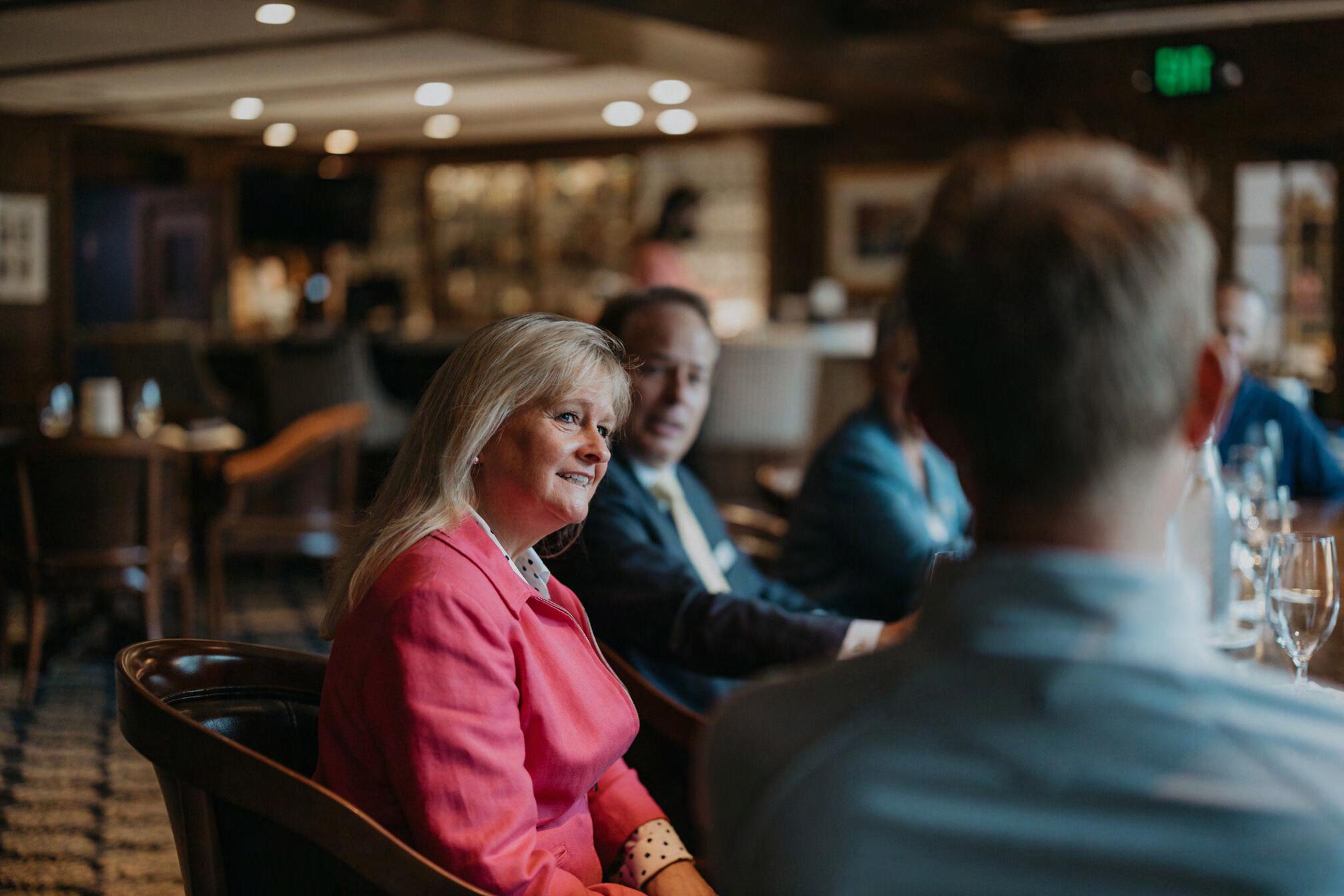

SAND-BASED GREENS ARE USGA GREENS, FEBRUARY 16, 2024, BY PAUL JACOBS, AGRONOMIST, CENTRAL REGION

HARNESS THE POWER OF THE PGA BRAND


LARRY HIRSH
Larry Hirsh, CRE, MAI, SGA, FRICS is the president of Golf Property Analysts (www.golfprop.com), a leading golf and club property consulting, appraisal and brokerage firm based in Philadelphia. He blogs on a variety of club and appraisal issues at http://blog.golfprop.com. He is the author of “The Culture of Golf - Isn’t It Just a Game?” available at: https://golfprop.com/the-culture-of-golf/.
Golf Course Aerification: Who, Why, How, When and Where
Recently, in mid-season, aerification took place at my club, closing the golf course for the week.
I’ve always wondered what, exactly, the process is for, why it happens at certain times and where on the golf course it’s required. Thus, I went to my good friend and agronomist extraordinaire, Terry Buchen of Golf Agronomy International, to learn more about an often frustrating process that disrupts the golf season, often when we think the greens are just getting to their best.
Depending on whether the golf course has its own equipment, either the grounds crew or a third party will perform aerification. The first question: Why do we aerify and deal with the disruption and temporary compromised conditions?
Buchen says: “Removing excessive amounts of thatch and organic matter (OM), reducing compaction and providing more air to the soils below. Ultimately there should be a 50 percent air and 50 percent water mixture in the soils for the roots to breathe properly. OM is usually being produced much faster than it is being removed and golfers would not tolerate having aerification being done frequently enough to keep up with its growth.”
Since it seems aerification takes place at the most disruptive times, I asked how frequently it’s needed. The most important thing is that aerification takes place when the turf is growing fully. That means in the north, with “cool-season” grasses, in late spring (after the poa annua dies out) and late summer, when it’s a bit cooler (hopefully) but allowing enough time for the holes to heal before winter.
In the warmer southern climates, Buchen suggests 2-4 times during the summer off-season spaced about 4-6 weeks apart. He says tees, fairways and roughs should follow the same schedule as greens, north or south. In transition-zone climates, it can vary depending on the type of grass, elevation, winter climate and other factors.
Many of us have heard about various types of “tines” used in aerification. Buchen explained that there are solid “pencil” tines that poke holes but don’t remove any cores. They range from 1/8” to 1/4” in diameter and typically from 4” to 6” in length. There are also solid tines that don’t remove
cores, ranging from 1/4” to 1” in diameter and from 4” to 10” in length. Coring tines remove a core and are hollow. They range from 1/4” to 1” in diameter and from 4” to 10” in length.
The larger the tines, the more excessive OM is removed, along with other benefits. The deeper the tine, the more soil is removed and the more modified soil (topdressing) can be introduced.
One of the primary concerns of aerification is scheduling. Buchen strongly advises that clubs, considering their climate, schedule aerification first based on agronomics and then plan major events (member-guest, club championship, etc.) around that schedule.
Regardless of climate, aerification should be scheduled so recovery can occur during a season when the turf is fully growing. Even in Florida, Buchen says, they aerify during the summer months because the warm season grasses are in full growth mode. Thus, in southern climates, less disruption occurs. Most superintendents hope for dry weather during the process to expedite both “punching” and healing.
Buchen says that the typical recovery time is 2-4 weeks, depending on several variables, such as soil temperature, fertilizing before aerification and the size, depth and spacing of the holes. He recommends fertilizing 7-10 days before aerification as one way to speed the healing process.
Even though most golfers loathe aerification, the bumpy and slow greens it leaves behind (temporarily) and at some courses closure for up to a week or so, the risks of not aerifying, according to Buchen, include excessive thatch buildup, softer playing conditions and unhealthy turf, resulting in the need to regrass sooner than normal. Compaction continues to increase on the soils below. This can become problematic and costly.
Aerification is like the old Fram Oil Filter commercial that says, “Pay me now or pay me later.” It’s usually best to do it now and take care of what we have rather than experience poorer quality conditions and more frequent replacement, which not only becomes more costly but impacts the property value. BR


GREEN COMMITTEE

JOHN ROWLAND
John Rowland, Ph.D., is an agronomist with USGA in Fort Lauderdale, FL. He can be reached at jrowland@usga.org, or 954-952-7743
This story is published courtesy of USGA.
A Tale of Two Coasts
Historically, dry weather has made things challenging for golf courses on the West Coast of Florida. Hopefully, some rain will arrive soon to reduce bicarbonates in the soil and give irrigation systems a break.
While the East Coast of Florida has been getting rain regularly, much of the West Coast has been lucky to get even an occasional shower. While visiting golf courses on the East Coast, including some in the process of growing in newly planted grass, there was very little talk of drought or lack of water.
This differs dramatically from the West Coast, which, aside from a hurricane and a couple of other systems, has received very little rain for months. Southwest Florida, from the Tampa Bay area to Fort Myers, had its driest summer in 26 years.
This brings me back to the update “How Dry I Am, How Wet I’ll Be!” I wrote about Florida’s typically dry winters and tropical, wet summers. A week after that April update, the Fort Lauderdale area got 30 inches of rain. Steady rains can lower soil sodium to negligible levels and reduce bicarbonates in the soil, lessening their impact on soil pH and turfgrass quality. This is why you see such a positive turfgrass response after a good rainfall, especially after you have relied on irrigation water for an extended period.
Unfortunately, the West Coast of Florida has had to rely heavily on irrigation water with significant levels of sodium and bicarbonates due to the lack of rain. Maintaining soil moisture around field capacity and using the leaching requirement when scheduling irrigation to leach sodium through the rootzone will usually be sufficient to manage warm-season turfgrasses in sandy soils.

Some courses are applying calcium and/ or potassium due to their propensity to hold more tightly on exchange sites to further reduce soil sodium levels. Others are injecting acids into their irrigation system to neutralize bicarbonates and lower pH, which can increase the availability of iron and manganese and improve turfgrass quality.
With the well-drained sandy soils typically found in Florida and significant levels of calcium in most irrigation sources, adjusting the acidity of irrigation water below a pH of 7.0 will limit bicarbonate accumulation and can be used in conjunction with the leaching requirement.
When irrigating between periods of intermittent rain, a pH between 6.5 and 7.0 is typically acceptable. In times of drought, an occasional reduction to around 5.5 can help spark up the grass and increase its color. Be cautious when the pH of irrigation water reaches 5.5, as there can be a dramatic drop in bicarbonates and continuing acid injection beyond that point can quickly lower the pH to dangerous levels since the buffering influence of bicarbonates is essentially gone at that point.
To learn more about this, check out my recent conversation on maintaining optimal soil pH with Dr. Micah Woods. In the meantime, let’s hope the busy season ahead has better weather in store for Florida. BR
Published courtesy of USGA. Southeast Region Agronomists: Chris Hartwiger, Director, Agronomy chartwiger@usga.org
Jordan Booth, PhD, Director USGA Course Consulting Service jbooth@usga.org
John Rowland, PhD, Agronomist jrowland@usga.org
Chris Neff, Agronomist cneff@usga.org




Todd Dufek is the locker room manager at The Country Club at DC Ranch in Scottsdale, AZ. He is the president of the Locker Room Managers Association with a website at www.yourlrma.com. For a six-month free trial membership and a free book on the secret to excellent locker room services, contact Todd at yourlrma1999@gmail.com.
There’s a Master Class for Locker Room Managers
What could take 16 months to teach a locker room manager and his staff? Everyone in the club industry, including board members, knows that if everything is good in the locker rooms (i.e., there are no member complaints), management doesn’t need to worry about a thing. Besides, four facts about locker room managers contradict the need for further training.
First, they spend part of their day socializing with members and their guests. Locker room managers in general (I’ve talked with many of them) are personable, great storytellers, outgoing and love to talk about sports—especially golf. Drop by any men’s locker room at a country club and you will likely find the manager carrying on a captivating conversation with members while keeping them thoroughly entertained.
Second, locker room managers spend the majority of their time taking care of a variety of footwear and many are selftaught. After all, shoe care isn’t rocket science.
Third, managers keep tabs on amenities to make sure the locker room and the wet areas are stocked and looking in “tiptop” shape, and they have a basic knowledge of what products members want in the bathrooms.
Fourth, managers track locker rentals and cancellations. And they report the changes to the accounting department monthly.
As a board member or club COO, you should know that many managers are generally good at carrying out the responsibilities outlined above. In fact, one of the four responsibilities is a basic skill that managers may possess on day one (No. 1). And those with little or no experience tend to learn the others on the job (No. 2, No. 3 and No. 4).
However, these skills are fundamental and locker room managers need more to do an outstanding job. Therefore, to become the best in the business, locker room managers need to learn a new, more complicated skill set. A goal that every country club aspires to for each of its employees.
Yes, there is a 16-month master class for locker room managers. And it would have been a simple matter to expand it to 24 months. There is that much knowledge that locker room staff need to gain to be the best at what they do.
So, what does a locker room manager need to know to excel at his job and learn beyond the four fundamental areas noted above? A list of some of the topics follows:
• The basics of greeting members
• Telltale signs of an amateur locker room manager
• LRMA shoe care system

• How to repair shoes
• How to “wow” your members and guests
• How to choose the best amenities for your club
• How to use the tee sheet as a guide for your workday
• One-page flow charts/guides: How to Handle Problem Spikes, How to Care for Dress Shoes, How to Care for Golf Shoes and dozens and dozens more.
Waiters and waitresses regularly receive training on menu changes and serving protocols. Golf professionals must keep up with the latest developments in club and ball technology and purchase cutting-edge tee prizes. Locker room staff are no different. When was the last time your club spent money on training for your locker room staff?
Be sure and show your locker room staff that you appreciate them on Golf and Country Club
Locker Room Staff Appreciation Day on Friday, May 10th! BR
EmployeeExperience!
Transform your workplace with Three and Jackie Carpenter.
Dive into a "People F1rst" philosophy that prioritizes connection, transforming your organization and leading to thriving teams.
Ready to lead a transformation?
Energize your team with a customized virtual or in-person session.
Three and Jackie Carpenter are passionate about creating work cultures where employees are fulfilled, inspired and engaged.
Their People First philosophy transforms organizations by focusing on connection and leads to teams who thrive!

Order Today!


"People F1rst" is your roadmap to a thriving organization, available now on Amazon.
Elevate your employee experience and create a culture of excellence. We’ll educate, inspire and activate a “People F1rst” Culture in your club!
COMMITTEE

TONI SHIBAYAMA
Toni Shibayama is a broker/risk consultant for S&K Insurance in Southern California. She has more than 15 years’ experience in risk management, job safety, workers’ compensation, wellness and HR consulting. Toni will speak at the CMAA World Conference & Club Business Expo in Las Vegas, NV, on March 8. The topic: “Avoiding Lawsuits & HR Drama at Your Club - The Critical Tools for Leaders.” Toni can be reached at toni@sk-insurance.com and at (213) 627-5204.
Don’t Let an Insurance Disaster Put Your Club in a Hole INSURANCE
On Feb. 17, 2022, the famed Oakland Hills Country Club suffered a devastating fire that swept through the club, engulfing the two-story frame clubhouse and causing massive structural damage and the roof to collapse. But was there enough insurance coverage in place to rebuild?
Insurance issues faced by any club that suffers a total loss focus on various areas of concern.
Building valuation and adequacy of insurance limits: Building values are often not updated each year and rolled over from one year to the next. If the completed Statement of Property Values shows the value unchanged from expiring, there will likely be an underreporting of building replacement costs.
Overreliance on blanket limits as a margin of safety: A blanket limit is a total of all building values (taken from Statement of Property Values), with typically 80-85 percent of total building/structure values attributed to the clubhouse. The possibility that a single occurrence could damage or destroy more than one building can result in a total loss, even when the building is sprinkled.
Failure to understand the coinsurance provision: The coinsurance provision provides for rate adequacy with replacement cost values determined by the claims adjuster at the time of loss. The insurance policy requires that the building values be reported at 100 percent.
A coinsurance penalty applies if the building valuation is insured for less than 100 percent. If the building value is reported at only 80 percent to value, the insurer pays only .80 of every loss dollar and the club pays .20 as a coinsurance penalty, resulting in an insurance shortfall.
Your club can avoid this problem if you have an agreed value to waive the coinsurance, which means you should get an appraisal to establish replacement cost for the buildings. This is even more important in a period where inflation has driven building costs to new highs.
Construction costs for a typical clubhouse in Southern California are $500-$600 per square foot. What happens if there is an inadequate insurance recovery?
Business income coverage: This insurance coverage pays for loss of net income (for nonprofits: revenue less expenses) and continuing expenses incurred during the period of restoration.
How to complete a business income worksheet:
First, project annual business income values by:
• Identifying sources of revenue that would not continue during a business interruption (do not include membership assessments or fees)
• Estimating the revenues for the next 12 months
• Subtracting out the cost of goods sold (supplies, merchandise, food, beverage) from the total.
The result is the business income annual value (not the limit). Second, determine the period of restoration to arrive at the insurance limit. It is the time needed to return the club to pre-operational loss levels. Allow for:
• Loss adjustment: claim settlement process (both direct and business income losses)
• Restoration process:
• Pre-construction: developing and approving building plans; waiting for building permits; and clearing the site: demo, debris removal
• Actual reconstruction of the building:
• Consider weather delays, labor and material shortages
• Often, architectural design features, like those found in the Oakland Hills clubhouse, take more time to replicate.
Most club estimates are based on actual reconstruction time, only leading to more potential for underinsurance.
Third, calculate the insurable limit:
• If 12 months are needed to restore operations, use the entire annual business income value
• If 18 months: 1.5 times the annual business income value
• If 24 months: 2.0 times the annual business income value. Most insurance carrier business income forms end coverage at 24 months.
Oakland Hills Country Club gives initial estimates to rebuild the clubhouse at “a couple of seasons.” In Michigan, a golf season runs from April 1 to Oct. 31, thus 24 months to build. But this does not consider the application of a coinsurance penalty. It is strongly advised to secure a no coinsurance form or agreed value to waive any coinsurance. In addition, it takes time to settle a business income claim. Historical data, forecasting, interim financial statements and budgets are used to help establish the loss. Revenue decline unrelated to the loss itself, such as a pandemic shutdown coinciding with the period of restoration, is not insurable.
If your club does not have the expertise to negotiate a settlement, consider the role of CPAs and public adjusters. What would you do in the event of a major loss to your clubhouse?
You will need business recovery planning to minimize the time to rebuild and resume normal business operations. Fortunately, there will be some continuation of revenues as you will likely be able to keep the golf course open even if the clubhouse is destroyed. Avoid the temptation to renew as is or with minimal changes. Take the time to learn what you have, what you don’t have and what you need. Be sure to provide renewal information in a timely fashion to your insurance agent. The best advice … plan for the worst-case scenario. Then, be ready to deal with it. BR



TROON PRIVÉ
Every private club has its own unique identity and we want to help your club maintain yours. Of course, that requires a different approach than the status quo of self-management, which is why Troon Privé® continues to grow. As Troon’s dedicated private club division, we are a proven professional services organization that provides best-in-class systems, processes and resources to the private clubs we serve. Visit TheTroonApproach.com to learn more about who we are and why our clients partner with us.




The Club at Castlewood Pleasanton, California
Calvert Crossing Golf Club Calhoun, Louisiana
West Bay Club Estero, Florida
Cimarron Hills Golf & Country Club Georgetown, Texas
Capital Canyon Club Prescott, Arizona
HR COMMITTEE

BRAD D. STEELE
Brad D. Steele, JD, started Private Club Consultants to provide in-depth legal and operational answers for America’s top private clubs. For more information about PCC, email Brad at steele@privateclubconsultants.net, call/text him at (703) 395-5463 or connect with him at www.linkedin.com/in/BradSteelePCC.
The DOL’s New Independent Contractor Classification Rule More Trouble for Club Leaders
The Department of Labor issued its long-awaited independent contractor classification rule in early January. As expected, this rule brings back the six-factor “economic realities test” for determining if a worker is an independent contractor or an employee under the federal wage and hour law known as the Fair Labor Standards Act.
This new rule will likely force clubs that use ICs (e.g., caddies, fitness instructors, massage therapists and other club workers) to make operational changes to ensure compliance.
The rule went into effect on Monday, March 11. However, lawsuits are pending, which could affect the full implementation. Still, club boards and senior staff should begin taking a long, hard look at how they classify their workers and reevaluate those classifications where necessary to minimize potential liability.
Under the rule, the following six factors will determine whether a worker is an independent contractor rather than an employee.
1. Does the worker have opportunities to generate profits/ losses based on his managerial skill, judgment and business acumen? (Does he market the business to other clubs, set his fees based on market rates and accept/decline work based on sound rationale?) If yes, then he’s an IC.
2. Does the worker make capital or entrepreneurial investments in the business? (Does he invest in ways to reduce costs or expand his marketability rather than simply paying the costs associated with doing a specific job?) If yes, then he’s an IC.
3. How permanent is the relationship between the club and the worker? (Does he have a specific project or work for a short period at the club, or does he work continuously?) If he spends little time at the club, then he’s an IC.
4. What nature and degree of control does the club have over the worker? (Does he set his schedule and fees, and does he have the ability to work for others, or is he super-
vised, trained, clothed or disciplined by a club?) If the club has little control over the worker, then he’s an IC.
5. Is the work performed integral to the club’s business? (Does the club need this job to be done? Is it critical, necessary or central to the club’s business?) If it is not integral, then he’s an IC.
6. Are the worker’s skills unique or specialized, and does he use that fact in a business-like manner? (Does he bring something to the club it does not have and would not train its employees to do?) If the worker’s skills are unique and he uses them to his benefit, then he’s an IC.
In the end, this rule focuses on whether the worker is economically dependent on the club for his livelihood or, as a matter of economic reality, in business for himself. Unfortunately, these six factors will likely make it more difficult to classify workers as ICs.
Ultimately, the DOL created this new rule to minimize “wage theft” by employers who wrongly classify workers as ICs rather than employees. As such, this rule allows the DOL to investigate claims that your club failed to pay minimum wage and overtime to workers you thought were independent contractors.
While DOL liability is the primary concern with this new rule, potential employment tax issues can arise with misclassification as can penalties for not complying with state IC classification laws, which have become more restrictive over the years. Furthermore, workers can file claims against your club themselves – usually as a class action lawsuit – if they feel they have been misclassified and not paid what they are due.
With such landmines laid out for clubs, it is clear that club leaders must prioritize classifying their workers correctly, which will likely mean the way a club has treated workers in the past will have to change to protect it from DOL penalties in the future. BR
ENVIRONMENTAL RECOGNITION
Through our environmental graphics and dimensional designs, we've woven a modern aesthetic seamlessly with the rich tapestry of the club's history. Our meticulously crafted panels and mixed materials form a breathtaking display, immortalizing pivotal historical moments and honoring past champions. Witness the fusion of innovation and heritage at its finest, encapsulated within every detail of this remarkable transformation.

Before After


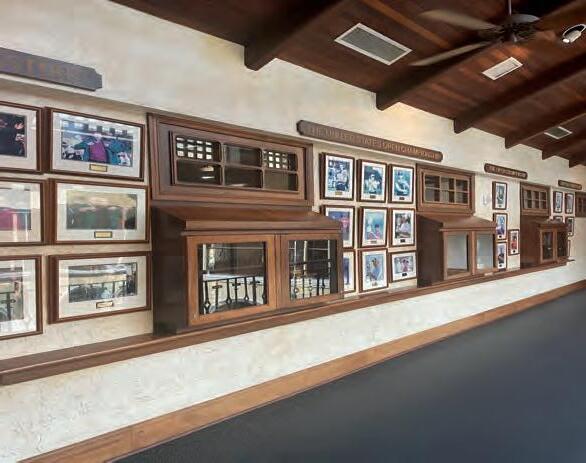









ANDREW HEFFNER
MEMBERSHIP COMMITTEE

KRIS BUTTERFIELD
Kris Butterfield is director of membership, communications & public relations at Bethesda Country Club and president of PCMA. She can be reached at (301) 767-8252 or kris.butterfield@bethesdacountryclub.org
Understanding Your Demographic
After you enter a room of private club membership professionals, it is not long before you hear someone utter the word “capacity.” We spent decades dreaming about having low attrition rates and long waitlists.
But the thing about dreams coming true is that we always have another dream lined up. Now that our resignations are low and our waitlists long, we need to understand how to uphold this ratio in the years to come.
Ensuring future success means focusing on the present. To maintain our coveted waitlists, we need to master exceeding expectations and truly enhance the member experience. We know that current member satisfaction leads to new member referrals, further supplementing our waitlists.
Let me present this simple exercise for you and your team to thoroughly comprehend member use of your club. We all know that attention is in the details, so let’s take a closer look at how certain factors can improve our efforts to provide an outstanding experience.

Start by analyzing your age demographic. Categorize the data by age groups that make sense to your club. Work with your team to identify when certain groups use the club.
For example, a few highlights from this chart include:
• There are more members in their 50s than in any other age group.
• Fifty-year-olds are empty nesters with nothing but time on their hands. They have flexible work schedules and are always the last to leave the Club Grill Bar on any given day.
• Members begin to resign in their 60s.
• Sixty- and 70-year-olds remember the club before the COVID-19 boom. They quietly accept the impact of new members as long as they can still enjoy their liver and onions for dinner. They enjoy watching the younger members of
the club, remembering their days with kids before the club had junior programs.
• An equal number of members are in their 40s and 60s.
• Forty- and 60-year-olds tend to use the club similarly. They dine early on weekdays and tend to golf later in the day on weekends.
• One-quarter of members are 49 and under.
• Thirty- and 40-year-olds are the newest members and never considered themselves the “country club” type. This group requires a little more onboarding. For example, explaining to this group the tradition of wearing tucked-in shirts on the golf course. They enjoy weekday family dinners after junior programs, and we appreciate their substantial club spend.
Analyzing your age demographic can bear a lot of fruit. Distinguishing when each member group uses the club can determine the areas to focus on when considering capacity concerns. Conversely, it will illustrate where the club has room for more members and more use.
Wouldn’t it be great to add life to parts of the club that are empty?
This exercise can indicate where to create programs that might strengthen member use in that part of the club. Knowledge is power and this is a great drill, even for clubs that have a cap written into their bylaws.
Some say that a happy wife leads to a happy life. In this case, happy members lead to consistent referrals, and referrals lead to an ever-growing waitlist. BR

MEMBERSHIP COMMITTEE

SUSAN GREENE
Susan Greene is the general manager/COO of Waterlefe Golf and River Club, MPOA. She is a member of CMAA’s corporate relations committee, past national president of PCMA, past regional education chair, licensed community association manager and real estate professional. She can be reached at gm@waterlefefl.com
Having Boards Impact the Generational Divide Just Makes Cents
Arguably, most of our board members are classified as Baby Boomers. They were born between 1946 and 1964. After all, there are 71.6 million of them in the US.
So, how does our current generation of board members begin to engage and create the next generation of club leaders?
Let’s be reminded of the upcoming generations. Generation X was born between 1965 and 1970-80 and is between 43-58 years old. There are 65.2 million of this generation in the US. The generation coming up behind Gen X is Generation Y, commonly referred to as Millennials. Its members were born between 1981 and 1994-96. There are 72.1 million Millennials in the US.
According to Kasasa, an award-winning financial technology and marketing services company, Gen Xers have the following characteristics:
1. Self-sufficient, results-oriented and hard-working, with a tendency to be quiet achievers
2. Entrepreneurial, educated and independent thinkers
3. Value diversity, challenges and responsibility
4. Enjoy creative input and are resourceful
5. Embrace technology and social media
6. Read newspapers, watch TV and listen to the radio.
On the other hand, Gen Yers or Millennials have these characteristics:
1. A strong desire for work-life balance
2. Tech-savvy
3. Civic-minded and socially conscious
4. An entrepreneurial spirit
5. Appreciate diversification
6. Value personal growth and have a collaborative nature.
Now, let’s see what the characteristics of our Baby Boomers are:
1. They are optimistic (look on the brighter side)
2. They work hard and are resourceful
3. Aren’t afraid to use their self-assurance to call it quits (personally and/or professionally)
4. May not be as conservative as you think (ready to listen)
5. They are super competitive and goal-centric.
How can we put them together for the good of the future of our clubs? (Refer to the corresponding characteristics above.)
Diversity and inclusion: Create a generational advisory council to the board. Invite existing Gen Xers and Gen Yers to participate and ask them to invite their peers inside and outside the club to join this council. The purpose is to grow their respective segment of members and to advise the board on more inclusive club activities. Characteristics: BB = 4; Gen X= 3 and 4; Gen Y=5 and 6.
Technology integration: Does your club have a communications manager? This role is critical to incorporating digital tools and platforms to make it easy for your generations to get involved. Characteristics: BB =1; Gen X = 5; Gen Y = 2.
Mentorship programs: Board members should assume the role of mentoring future club leaders. Through a mentoring program, your leaders of tomorrow will be versed in club policies, procedures and history. Characteristics: BB = 2 and 5; Gen X = 4; Gen Y = 6.
Flexibility: Board members should encourage club events with a mission of fostering the proper work-life balance. Encourage virtual meetings, virtual speakers’ forums, consider membership amenities that include support for parents and caregivers, offer collaborative learning member to member. Characteristics: BB = 2; Gen X = 2 and 4; Gen Y = 1.
Social and environmental issues: Our boards should work hard to create a philanthropic environment. Younger generations are drawn to purpose-driven initiatives and the positive impact your club makes on its community. Each board member should chair at least one event per year and ask a generational opposite to be the co-chair. Characteristics: BB = 5; Gen X = 1; Gen Y = 3.
By combining the traits, preferences, values and aspirations of all generations, your club leadership will be set for success. Just makes cents. BR





Pelican Bay Marker 36 Naples, FL
MEMBERSHIP COMMITTEE

Sustaining Excellence
JESSICA PAYNE
Jessica Payne is director of membership, San Jose Country Club, Jacksonville, FL. She can be reached at (904) 737- 9064 or via email: Jessica.payne@sjccjax.com www.Sjccjax.com
The Art of Onboarding and Inboarding
In the world of exclusive clubs, where FME dues ensure the lights stay on, the heartbeat and legacy of the club extend far beyond mere financial contributions.
At the core lies the transformative power of onboarding and inboarding – a journey that goes beyond joining, fostering loyalty, and ultimately, securing the future.
Properly onboarded members are the lifeblood of a thriving club, showcasing their loyalty through active participation in events and exploration of all facets the club has to offer. Their commitment is more than attendance; it’s a recognition of value, a testament to the club’s significance in their lives.
Education becomes the cornerstone of sustained success. From understanding intricate by-Laws to navigating club handbooks and leveraging online tools, the ongoing education of members proves pivotal.
This culture of learning, however, originates from the top – with board members serving as torchbearers of true education and knowledge.
Enter the membership director, the guiding force responsible for informing, educating, and implementing the rules and regulations that define the club’s essence. Starting at the top, these directors ensure that every member, properly onboarded, becomes a potential steward of the club’s principles, evolving into future board members, ready to inform, educate, and implement.
In an ever-changing landscape marked by unpredictable weather, economic recessions, stringent budgets, soaring food costs, and evolving employment laws, the importance of such education becomes evident. The lessons of 2020, where pandemics became a stark reality, further emphasized the need for resilience and adaptability.
As country clubs flourish and face unprecedented challenges, a simple yet profound question resonates – have you been properly onboarded, and are you currently being inboarded?
An educated and informed member emerges not only as a financial asset but as a custodian of the club’s legacy, ensuring a prosperous future for generations to come. It is in this commitment to continuous learning that the club’s true strength lies in weathering storms and shaping a legacy that transcends time.
In the dynamic landscape of country clubs, the first 30, 60, 90 days of a new member’s journey prove to be fundamental. Research reveals that members who are engaged, informed, and properly inducted during this initial period are likely to stay 10 times longer than a member who has not been properly onboarded. This statistic translates into a profound impact on the longevity and legacy of country clubs. These unprecedented times have seen country clubs facing unique challenges, with waitlists stretching from months to years across the nation. As membership directors, it becomes imperative to maintain a consistent level of attention and detail through onboarding and inboarding processes. This commitment is the linchpin for ensuring the continued legacy, longevity, and lifeline of our cherished country clubs.
Amidst the flux, new blood brings new measures. It’s a period not just for recruitment but a strategic focus on retention and appreciation. Every member onboarded with care becomes a building block in the foundation of the club’s future.
It’s a time to relish the journey, witnessing hundreds of new families creating thousands of memories, contributing to the collective joy and happiness that our world always needs.
In essence, the onboarding process is not merely an administrative task but a vital investment in the thriving future of country clubs. So, let’s embrace this amazing ride, celebrating the influx of new members, and nurturing the bonds that will resonate for decades to come.
Fairways and Greens! BR










LEGAL COMMITTEE


Alcoholic Beverage Licenses: Pour Me Two Shots
For many members, a day at the club often includes enjoying an alcoholic beverage.
From clubhouse dining to a round of golf, many social activities and events include a variety of these beverage offerings. Some clubs also offer alcohol for off-premises consumption, such as wine by the case for members to enjoy at home.
However, to sell alcohol legally, clubs must hold an active alcoholic beverage license. Thus, board members and club managers must understand the different types of licenses available and the requirements for the type of sales they intend to make. Failure to hold the proper license and meet the selling and serving requirements of the license could result in a complete loss of the ability to sell any alcohol.
The sale of alcohol is governed by state law, but the issuing authority may be a local government, such as the city or county where the club is located. In any case, licensing types vary depending on where the alcohol will be consumed, at the club or off-premises, and what type of entity is involved.
Many times, there are licenses strictly for clubs, and some states also distinguish between the types of clubs. For example, Florida has an “11C Club” license that allows the sale of alcoholic beverages for consumption of drinks for members and guests on-premises and an “11CG Golf Club” license for golf clubs.
It is important to apply for and maintain the appropriate type of license. Clubs that only hold a license for on-premises consumption are generally not permitted to sell packaged alcohol for off-premises consumption. Further, off-premises consumption licenses may vary based on the type of alcohol being sold. In Florida, for example, the “2APS” license permits the sale of only beer and wine for off-premises consumption.
During COVID, many on-premises licensees were temporarily permitted to sell these beverages for off-premises consumption. Given that many members enjoyed the ability to purchase through their club for convenience and potential savings, many clubs desire to make these sales a continued amenity for members. To do so, clubs must maintain a license that specifically allows for off-premises consumption for the applicable category of beverage being sold.
Applications for alcohol beverage licenses can be complex, often involving various government agency approvals, background investigations and registration requirements for the
club’s officers and managers. When applying for a license, clubs must describe the premises where alcohol will be sold in detail on a sketch accompanying the application. The sale of alcohol outside of the sketched premises is not permitted.
Golf clubs, however, often serve players directly on the course, which will usually not be the same as the clubhouse or pool area depicted in the sketch. This may require an additional supplementary license corresponding to the club’s primary license for the sketched premises.
Applying for and obtaining the appropriate license is only the first shot. Once the proper license is obtained, the next round involves maintaining compliance with the state’s laws and regulations.
For instance, election cycles often result in a change in club management. Many clubs are not aware that when a change of officers occurs, state regulations may require the club to update its licensing records, which may require the club to file an updated application or other forms with the state’s alcohol beverage authority.
Florida law requires clubs to update their officers with the state within 10 days of any change, and newly elected officers must complete an affidavit and have their fingerprints submitted to the state within this period.
The consequences of failing to comply with alcoholic beverage laws are sobering. It can result in suspension or revocation of the license, loss of the right to sell any alcohol, and would likely impair a club’s operations, revenue stream and reputation significantly.
Such failure could also subject the club and individual officers and managers to fines, penalties and potentially criminal charges. Thus, make sure you obtain and maintain your alcoholic beverage license under the influence and guidance of qualified professionals with the requisite experience. BR
Michelle Tanzer, Esq. is chair of the Global Club and Branded Residences group at the law firm of Nelson Mullins, serves on the National Club Association board of directors, arbitrates club-related disputes for the American Arbitration Association and authored “The Club Litigation Book: Keeping Clubs out of Court.” Ms. Tanzer can be reached at (561) 866-5700 or via email: Michelle.Tanzer@NelsonMullins.com. Brian Meanley, Esq. is of counsel in the Global Club and Branded Residences group at Nelson Mullins and can be reached at (561) 343-6937 or via email: Brian.Meanley@NelsonMullins.com.









Ridgewood Country Club, Paramus, NJ
Baltusrol Golf Club,
TECHNOLOGY COMMITTEE

FRANK WOLFE
Frank Wolfe, CAE is CEO for Hospitality Financial and Technology Professionals (www.hftp.org).
A New Approach to Finance Strategies to Accelerate the Month-End Reconciliation Process
Introduction adapted by Frank Wolfe
Every board member knows how important the month-end reconciliation process can be when it comes to understanding where exactly your business is at financially. As noted in a recent article published by HFTP (https://www.hftp.org/ blog/streamlining-hospitality-finance-month-end-reconciliation), this is where all the valuable data comes together to summarize a club’s financials and performance.
Optimizing the process was an important topic at the HFTP 2023 annual convention last October and the subject of an education session, “Accelerate Closing with Precision: Expert Strategies to Boost Efficiency While Ensuring Financial Accuracy.”
HFTP members were surveyed ahead of the session, and their responses exposed a stark reality. Less than 20 percent of respondents could finalize the process within five days, while 12 percent noted it takes them over 11 days.
Fortunately, there are ways that leadership can support and empower a club’s finance team to accelerate this process, thus improving overall performance. The following strategies were put together by the session panelists, which included Rajan Gupta, managing partner at Centelli; Thomas Smith, chief business officer at Imperial Golf Club; Aric Briggle, regional vice president of hotel finance at Davidson Hospitality Group; and Lisa Martin, regional director hotel finance at Davidson Hospitality Group.
KEY STRATEGIES TO ACCELERATE MONTH-END CLOSING
(Originally published at blog.hftp.org)
1. Communication excellence: Bridge internal and external gaps
Communication emerged as a significant hindrance, both within teams and with external stakeholders. Barriers often arise from past disengagement by predecessors and a perception of finance interactions as “reprimands.” Strategies for improvement include assertiveness training, active listening, more frequent check-ins between teams (i.e., not only when you need something), active coaching of financial
principals to non-finance leaders and the use of checklists to ensure task continuity during unforeseen circumstances.
2. Continuous close: Proactive management of accounts
While “continuous close” is a proven strategy for efficient month-end closing, our survey revealed that only seven percent adopt it consistently. This approach spreads the work over the month, addressing journal entries and other transactional activities as they occur rather than allowing them to build up. Proactive and efficient, it aids in error detection, budget maintenance and overall preparedness. The fact so few adopt this approach (despite its advantages) may signal a need for process reassessment.
3. AI and process automation: Transforming the finance landscape
AI and process automation are becoming indispensable and redefining hospitality finance. While technology has streamlined operations, gaps persist and are usually filled by human intervention (people copying data and staring at spreadsheets!). Intelligent automation using digital workers can eliminate these manual tasks, allowing teams to focus on complex issues. These digital workers can run on any current software, and they enhance efficiency and free human resources for strategic endeavors.
What’s more, they can also address the industry’s talent shortage, too. While not replacing humans, they remove repetitive processes that are often the most frustrating for team members and alleviate pressure during peak periods. By automating repetitive tasks, digital workers contribute to happier employees and guests and, ultimately, more profitable businesses.
It is important to maintain efficient accounting processes for the club’s overall financial health. By introducing these strategies to optimize month-end close, you can help ensure your finance team can report performance information more quickly, accurately and efficiently. BR




Congratulations
MOVERS & SHAKERS
BOARDROOM magazine is promoting advancement in the club industry via its Movers and Shakers section on the website.
This section pays tribute to new placements and advancement for club executives and staff.
In addition to announcements on social media and on the website, these posts are shared through bi-weekly and monthly emails.

Scan here to view or submit a placement.



Emad Saedi is marketing content coordinator for Jonas Club Software. He can be reached via email: emad.saedi@jonasclub.com
Mastering Your Workflow A Brief Guide for Managers
Club managers face a complex landscape of tasks and responsibilities while juggling departments, staff and member needs. To tackle this daily whirlwind, adopting personalized workflow techniques is essential. The digital era offers online tools and applications to enhance productivity, serving as valuable allies in managing tasks and fostering collaboration.
Know what’s happening at a glance: It’s impossible to know what each day will bring. A valuable way to be prepared is to review your club’s upcoming activities for the day, including events, member bookings, visits, meetings and more.
Gathering this information can be tedious and difficult when dealing with multiple data sources and departments. It is important that your club technology can tell you what’s happening at the club, which members are going to be on property that day and a little bit about what those members are doing. With this information at your fingertips, you’ll be able to tend to the areas that require your attention.
Decode actionable insights: While you cannot prevent every surprise, you can take proactive measures to simplify your decision-making process. Begin by focusing on your members—examine their profiles and review upcoming bookings to ensure your facilities are primed for their activities. Regularly access daily summarized reports on departmental performance, statistics such as bookings, dining reservations, tee times, POS transactions, inventory levels and more.
This data serves as a valuable resource for identifying pain points for your staff and empowers you to make informed, evidence-based decisions, contributing to a more responsive and efficient management approach. This data should be in the palm of your hand so whether you’re in a meeting room with your team or speaking with a member in the dining room, you have access when you need it most.
Track your progress: Monitoring key performance indicators to quantifiably measure your club’s performance should be done in real time. With data points coming from all areas of the club, including point of sale, inventory, mem-
ber use of the club and more, you need to have easy access to keep on top of what’s happening. Throughout the day it would be helpful to check these KPIs in case you need to make a change to your previous plan, get staff help or address a situation while it is happening.
Communication is key: Recognize that not every interaction requires an email —sometimes a brief text message is sufficient. Leverage internal messaging systems to engage with staff, confirm information or bookings, or broadcast messages to the entire staff. More and more clubs are introducing instant messaging platforms for more timely staff communications. At the management level, messaging over mobile apps helps keep everyone informed even when they are not at their desks.
Maximize productivity with digital tools: Discover the right tools to approach these mentioned steps. Imagine having the ability to view your club’s agenda, access member profiles, review daily reports, monitor inventory, communicate with staff and more on your phone. The technology landscape within the club industry is evolving, with providers investing in more mobile app solutions to simplify your managerial responsibilities—seize this opportunity to streamline your operations and enhance overall efficiency.
From strategic allocation of time for focused work to taking advantage of various technology tools for staying on top of things, managers can not only survive but thrive in their multifaceted roles.
The key takeaway is that the path to optimal productivity is getting more efficient with digital tools that put the club manager’s needs at the forefront. Club managers are expected to empower their teams with the right tools to enhance their operations and deliver exceptional member experiences. Now more than ever they can empower themselves with the right tools to be prepared for anything. BR
EMAD SAEDI

: a new convertible outdoor terrace features a spacious bar, grill and expansive views winning raves from members. Having it both ways.

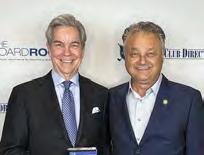

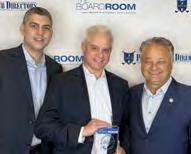




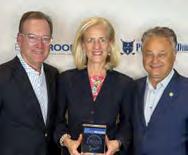
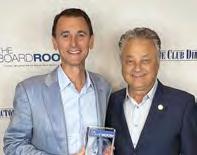






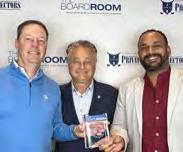
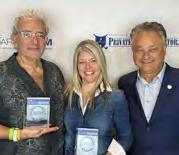






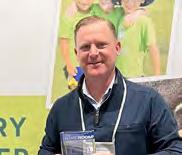













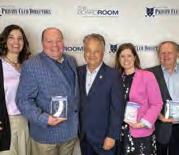































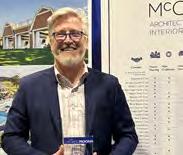
LIFETIME ACHIEVEMENT
1. Randy Addison
GARY PLAYER EDUCATOR
2. Ray Cronin
DAVE WHITE EDITORIAL AWARD
3. Henry DeLozier
JOHN FORNARO INDUSTRY IMPACT AWARD
4. Peter Jackman, Terminal City Club Matthew Allnatt, The Jonathan Club (not pictured)
JAY DI PIETRO VENDOR
5. SYZYGY+AZENCO
PRODUCT*
6. Preferred Club Lighting
7. Club Grub App AMENITIES PROVIDER
8. Duffy’s Tri-C Club Supply
9. NanaWall
5. SYZYGY+AZENCO
10. HFTP
RENOVATION
11. MAI | Marsh & Associates, Inc.
BOARDROOM INTERIOR DESIGN
12. Castor Design Associates BRANDING/COMMUNICATIONS
13. Strategic Club Solutions
BUSINESS INTELLIGENCE SOFTWARE*
14. MetricsFirst
15. Club Data Services
CASUAL DINING RENOVATION
16. AM Design Group
CHAIR MANUFACTURER
17. Eustis Chair
CHILDRENS’ PROGRAM
18. KE Camps
19. Corby Hall
20. The Verdin Company CLUB ENTERTAINMENT*
21. The Members Only Show – Michael Gutenplan
22. House Calls of Comedy – Howie Walfish
CLUB FOOD & BEVERAGE EQUIPMENT
Hotel Restaurant Supply (not pictured)
CLUB INTEGRATION TECHNOLOGY
Clubhouse Online (not pictured)
CLUB


CLUB MEMBER ANALYTICS
14. Jonas Club Software
CLUB PHOTOGRAPHY
25. E.A. Photography
CLUB SAFETY
26. Club Safe
CLUB SIGNAGE
27. Signera
CLUBHOUSE CASUAL DESIGN
16. AM Design Group
CLUBHOUSE DINING ROOM



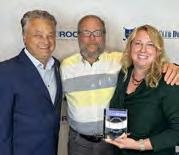
GOLF COURSE MAINTENANCE FIRM*
46. International Golf Maintenance (IGM)
47. BrightView (formerly ValleyCrest)
GOLF COURSE PRODUCTS
48. Landmark

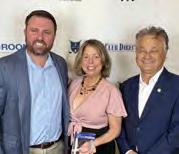
OUTDOOR FURNITURE*
35. XHIBTZ
66. JANUS et Cie
HISTORIC CLUBHOUSE INTERIOR RESTORATION*
49. Bozeman Design
50. C2 Limited Design Associates
HOSPITALITY UNIFORMS
51. Ambassador Uniform
HR SOLUTIONS
52. Insperity
HUMAN RESOURCES
28. Larson/Nichols Interior Design
CLUBHOUSE EXTERIOR DESIGN
29. Peacock + Lewis - Architects and Planners, LLC.
CLUBHOUSE INTERIOR DESIGN
29. Peacock + Lewis - Architects and Planners, LLC.
CLUBHOUSE INTERIOR DESIGN GRILL ROOM
30. JBD JGA Design & Architecture
CLUBHOUSE INTERIOR DINING
11. MAI | Marsh & Associates, Inc.
CLUBHOUSE LOCKER ROOM
11. MAI | Marsh & Associates, Inc.
CLUBHOUSE LODGING
31. Kuo Diedrich Chi Architects
CLUBHOUSE MULTI-PURPOSE LOUNGE
32. Angela Grande
CLUBHOUSE SUPPLIES
33. Forbes Industries
CONSULTING COMPANY
13. Strategic Club Solutions
CUSTOM DESIGN HOSPITALITY UNIFORMS
34. High-End Uniforms
CUSTOM DESIGN OUTDOOR FURNITURE
35. XHIBTZ Contract Furnishings
CUSTOM CLUB APP
36. Pacesetter Technologies
ELECTION MANAGEMENT SYSTEM
37. Survey & Ballot Systems
ENVIRONMENTAL COMPANY
38. Bambrella
EXECUTIVE SEARCH FIRM
39. Kopplin Kuebler & Wallace
FITNESS EQUIPMENT
40. Technogym
FLOOR MATTING
41. Proform™ Premium Matting & Commercial Carpets
FOOD & BEVERAGE TECHNOLOGY PRODUCT
42. System Concepts, Inc. / FOOD-TRAK
FOOD SERVICE STRATEGIC PLANNING
43. RealFood Hospitality, Strategy and Design
FURNITURE MANUFACTURER*
44. Gasser Chair Company
45. Shelby Williams
53. Gecko Hospitality
INTERIOR DESIGN BAR DINING ROOM
12. Castor Design Associates INTERIOR DESIGN LOBBY
28. Larson/Nichols
INTERIOR DESIGN MEN’S LOCKER ROOM
54. HINT | Harris Interiors
INTERIOR DESIGN WOMEN’S CARD ROOM
12. Castor Design Associates INTERNATIONAL STAFFING
55. MTL International Work and Travel KITCHEN EQUIPMENT
56. Hoshizaki
LAW FIRM
1. Addison Law
LOCKER COMPANY – METAL
57. Salsbury Industries LOCKER COMPANY – WOOD
58. Hollman, Inc.
MAIN BALLROOM INTERIOR DESIGN
12. Castor Design Associates MANAGEMENT COMPANY
59. Troon
MARKETING COMPANY
13. Strategic Club Solutions MASTER PLANNING
50. C2 Limited Design Associates MEMBER VETTING
60. Kennis
MEMBERSHIP ANALYTICS
61. Clubessential
MEMBERSHIP MANAGEMENT
14. Clubsystems Group
MEMBERSHIP SURVEY
62. McMahon Group
MEN’S GRILL INTERIOR DESIGN
63. Chambers
MODERN CLUBHOUSE DESIGN
31. Kuo Diedrich Chi Architects
NEW TECHNOLOGY PRODUCT*
64. Cobalt Software
65. Whoosh
OUTDOOR LIVING STRUCTURE
5. SYZYGY+AZENCO
ONBOARDING SOFTWARE
23. Club Core, Inc.


OUTDOOR TERRACE AREA
16. AM Design Group
ONLINE MEMBER ENGAGEMENT
67. MembersFirst PAYROLL PROGRAM
14. ClubPay
POOL AREA DINING
68. ClubDesign Associates
PURCHASING COMPANY
69. Avendra
PURCHASING SERVICES
68. ClubDesign Associates
PROJECT MANAGEMENT
70. PHX Architecture
68. ClubDesign Associates
REAL ESTATE SERVICE
71. Private Club Realty Group
REFURBISHED POOL FACILITY
72. Rogers McCagg
STAFF TRAINING COMPANY
73. RCS Hospitality Group
STRATEGIC PLANNING
62. McMahon Group
TAX CONSULTANT
74. PBMares
TENNIS COURT BUILDER
75. Welch Tennis
TENNIS MANAGEMENT
76. Cliff Drysdale Tennis
UMBRELLAS
38. Bambrella
WEBSITE COMPANY
61. Clubessential
WELLNESS FACILITY
31. Kuo Diedrich Chi Architects
WINE ROOM/HALL DESIGN
50. C2 Limited Design Associates
WINE LOCKERS
77. Vigilant
WOMEN’S LOCKER ROOM
30. JBD JGA Design and Architecture


HENRY DELOZIER
Henry DeLozier is a partner at GGA Partners. He can be reached via email: henry.delozier@ggapartners.com
Three Things Your Board Should Be Doing
Most private clubs are in their halcyon days. Memberships are full to overflowing in nine out of 10 clubs. Access to new funds has accelerated capital spending priorities. And the worst of the antisocial and undesirable behaviors demonstrated by some members during the pandemic seems to have subsided. Happy days are here, again.
Top-performing boards are using these happy times to focus on three keys for the sustained success of their clubs. They are (a) updating their clubs’ strategic priorities; (b) focusing on topline growth; and (c) planning ahead to optimize member and employee retention.
Review your club’s strategic priorities: During the most desperate pandemic times, club boards and their faithful operators were intent on keeping their clubs afloat. Then, thanks to resourceful thinking by many club managers and government loans in some clubs, boards were able to navigate the stormy waters. Certainly, few club leaders were thinking about strategy amid the COVID-19 tempest. Now, club leaders at leading clubs are updating strategic priorities and thinking.
Sound post-pandemic strategic planning must focus on three keys:
Economic sustainability: Now is the time to prioritize financial durability by planning for capital needs … the sources and uses of funds necessary to keep the club relevant to members. Common wisdom holds that private clubs use member dues to fund routine operational costs and wages while new members’ joining fees and other sources of funds serve capital needs.
The uses of funds in private clubs are clear-cut when you reference their capital asset reserve studies. Boards must know the useful life of all club assets and the cost of replacing these assets. Further, they should use the capital reserve study to develop a comprehensive 20-year model of capital needs.
Source of funds is the category that put most clubs into pre-pandemic trouble because club leaders had not adequately planned for the sources of funds that would meet the ever-changing appetite for capital. Sources of funds for private clubs are normally:
• Initiation/joining fees – The surge of new members joining clubs has provided tremendous lift to most clubs which have seen significant increases in member enrollments and capital accounts.
• Capital dues – Roughly two of every three private clubs require regular (monthly, quarterly or annually) payments from members for funding capital reserves. Most clubs segregate cap-
ital needs into two types: (1) capital maintenance, which is the timely care and upkeep of existing assets on the club’s balance sheet, and (2) capital improvements, which is the acquisition of new capital assets to be added to the balance sheet by using these funds.
• Capital calls – Joining fees and capital dues proceeds are often inadequate in total to fully fund the capital needs of clubs. As such, many club members refer to capital calls as “assessments” and dread them. Club leaders must find new methods which inform their members of the club’s capital funding model, methods and needs.
• Debt – Debt is a tool that can serve clubs well if the related costs and terms are helpful to the club. Debt is not the bogeyman feared by club members above the club’s average age. And debt is not a panacea for all things. The tool must be wisely used.
The key to effective economic planning is a thorough analysis of capital needs and sources.
Focus on top-line growth: Keeping a private club economically fit requires an understanding of the club’s economic model. Most ordinary members of the club warn their board members to contain cost escalation. This warning – while sound and worthy of consideration – overlooks a basic rule of business durability and that is revenue growth.
In the post-pandemic economy, club leaders must note that supply chain and inflationary impacts have driven three expense categories surging upward: fully loaded labor costs, risk management costs and expense categories which are most affected by the cost of oil. These three categories now account for greater than 60 percent of a private club’s expenses. Reasonable and responsible board members recognize that these costs are unlikely to decline in the near term.
Focusing on top-line growth requires that board members be alert to increasing members’ dues regularly. The question of “how much?” consistently arises and many club leaders look for the following guidance:
• Estimate the cost of club operations and price membership dues at a level which will cover all operational costs and expenses from dues. Many board members become caught up in club politics trying to guess members’ tolerance for dues increases. In fact, dues increases nationwide over the past three – now four –years have been in double-digits (above 10 percent) on average in most clubs. If your club is seeking to cut costs during a time of such cost escalation, the board is focused on the wrong metric. Dues are the key.











• Many club leaders worry that dues increases will cause members to resign. In fact, club members are more alert to the value proposition than they are concerned with dues increases. Thus, the board is well advised to ensure that members see that they are getting their money’s worth.
Like all businesses, private clubs rely upon revenue growth to provide a favorable value proposition.
Member and staff retention: Club leaders are often reminded that they “are in the member business” rather than golf or pickleball, or food and beverage. Focusing on member retention keeps your club financially fit and market relevant. There are three points of emphasis for board members:
• Monitor the club’s member satisfaction and commitment markers. Most clubs regularly survey club members on assorted topics. No topic is of greater strategic significance than members’ satisfaction and willingness to recommend their club to friends and family.
• Use net promoter score as a board metric. When staff members are proud of their club and feel that they have good and respected jobs, they are “promoters.” Dissatisfied staff members are seen as “ detractors.” Top-performing boards keep their eyes on staff NPS markers.
• Using a net promoter score model enables clubs to measure the level of commitment and support of the two key segments: members and staff. Declining NPS is a sure sign of an endangered club which is losing relevance to members and staff.
• Monitor the pipeline for those seeking to become members. Many club leaders have taken their eyes off the importance of traffic in membership leads, which is the early warning for demand and waitlist growth. Too many club leaders rationalize that there is a waitlist (so everything must be all right). Is the waitlist growing or receding? The answer to that question is the proverbial canary in the mineshaft.
It was tough enough to recruit members and staff. Don’t lose them due to inattention. Now is the time for top-performing boards to focus on the strategic factors that most influence the future of their clubs. There is no substitute for learned attention. BR


Forbes Travel Guide is the authority on hospitality excellence. We work with the best luxury hotel brands globally. Let us help you elevate your service to improve member satisfaction and retention.



Forbes Travel Guide worked with our leadership team to create custom standards and tailored training which have been implemented throughout the club. We value our partnership with Forbes Travel Guide.
Jeffrey P. McFadden Chief Executive Officer/General Manager The


MEMBERSHIP MUSINGS

BONNIE J. KNUTSON
Bonnie J. Knutson, PhD, is a people watcher. A professor in The School of Hospitality Business, Broad College of Business, Michigan State University, Dr. Knutson is a member of the Country Club of Lansing and the Michigan Athletic Club. She can be reached via email: drbonnie@msu.edu
Award or Reward? That is the Question.
Although it was decimated by the pandemic, the hospitality industry seems to be on the rebound. Airlines are full, hotel occupancy is estimated to have increased about 20 percent over its 2020 level and restaurants are returning to near pre-pandemic levels.
And “based on data from 300 clubs it considers representative of the U.S. market, the research firm Club Benchmarking shows that 25 percent of U.S. country clubs had full memberships before the pandemic. That number is pushing 50 percent today and climbing.” This sounds like a great club future to me.
So, what is the problem?
If you ask most managers, they will tell you that their biggest challenge is staffing. The reasons are well known: low wages, inadequate benefits, long hours away from family on weekends and holidays, and limited opportunities for advancement.
Add to these the dramatic rise in early retirement numbers, revolutionary remote work options, the upward trend in entrepreneurship and the federal unemployment benefit programs brought on by COVID-19, and it is not surprising that a club’s staffing demand is out of sync with a club’s staffing supply.
But there seems to be a more fundamental shift in how people view work itself.
It is called time. If we measure value as an algebraic equation, it would be V = E – C. In other words, the value of working where we do is simply the difference between the experience we have working there minus the cost of getting that experience.
The twist in this equation is that people are now calculating cost to include time, not just money. “People’s valuation of their own time has changed. Americans are less eager to do low-paid, often dead-end service and hospitality work, deciding instead that more time on family, education and leisure makes for a higher standard of living, even if it means less consumption.”
Joe Pine, author of the benchmarking book “The Experience Economy,” puts it this way: There is a difference between time well saved and time well spent.
Here is where the question of award or reward comes into the staffing picture. These two terms are often used interchangeably. And while they are related, they are distinct concepts.
Rewards recognize an employee’s service, effort or job well done; i.e., they are given as a result of a specific task or assignment and are intended to be a positive reinforcement that encourages repetition by the “winner” and emulation by others. Awards, on the other hand, recognize or honor exceptional achievement or contribution over time; i.e., sustained excel-
lence. Every year, the Kennedy Center Honors recognize those in the performing arts for their lifetime of contributions to American culture.
The Excellence in Club Management Awards recognize private club general managers and chief operating officers who have exhibited outstanding skills in managing their clubs. What awards does your club have?
I am a fan of recognizing employees with creative awards because they are more inspirational and can boost morale and motivation. But the operative word must be creative. To get your creative juices going, here are several ideas:
• Mentorship Marvel acknowledges someone who goes above and beyond to mentor and support colleagues. (Maybe you can award a cartoon-ish diploma.)
• Infectious Enthusiasm Trophy recognizes someone who brings contagious enthusiasm and energy to the club; the person is an employee cheerleader. (Could the award be a gilded pompom?)
• Master of Multitasking goes to employees who can effectively juggle and excel in handling many jobs simultaneously. (Something akin to a juggler could be used here.)
• Innovation Maestro Award is for employees who are always thinking outside the box to contribute innovative ideas to improve club operations and member experiences. (This award calls for some type of outrageous box.)
• Collaboration King/Queen crowns employees who foster collaboration and teamwork among colleagues across departments. (Crowns in a glass case are a natural.)
Of course, awards can also come with a monetary bonus, time off or other benefit. But no matter what they are named, or how they are structured, awards should be “branded,” fun and break through the clutter. After all, they are a foundation for creating a positive club culture, encouraging active employee participation, reinforcing their sense of belonging to a close community and having pride in working at the club.
As my dad always said, ”Our people stay not for what we pay them but for what they get.”
But always remember, the effectiveness of these programs depends on the specific needs and preferences of your employees. Regularly solicit feedback and adjust your reward programs accordingly.
Your bottom line will thank you. BR
BORIS FETBROYT
Boris Fetbroyt, USPTA, PTR, CRSE is director of racquets at The Philadelphia Cricket Club. He can be reached at (240) 413-0614 or via email: bfetbroyt@philacricket.com

RACQUET COMMITTEE
The Evolution from Traditional Tennis Memberships to Racquet Memberships
Private clubs, synonymous with exclusivity and refined leisure, have witnessed a notable evolution in recent years. Traditionally, tennis memberships stood as the pinnacle of racquet sports engagement in these elite establishments.
However, a discernible shift has occurred, transforming the landscape into a more inclusive approach with the introduction of racquet memberships. This article explores this evolution, delving into the factors driving the change and the benefits it brings to both clubs and their members.
The changing dynamics: The shift from traditional tennis memberships to racquet memberships reflects a broader societal trend toward diverse sporting interests. Recognizing the growing popularity of sports like squash, paddle, padel, pickleball and badminton, private clubs are adapting to meet the changing preferences of their members. Racquet memberships now encompass a broader spectrum of racquet sports, providing a more comprehensive and inclusive experience.
Inclusivity and diversity: One of the primary motivations behind this shift is the desire for greater inclusivity. Racquet memberships break down the barriers that may have limited participation to a single sport. Members can now explore and enjoy a variety of racquet sports within the same exclusive club environment. This diversity fosters a sense of community among members with varied interests, promoting social interaction and camaraderie.
Adapting to member preferences: Private clubs are keenly attuned to the preferences of their members. Recognizing that tennis might not be the sole focus for everyone, clubs have embraced a more adaptable approach. Racquet memberships allow members to customize their experience, choosing from a menu of racquet sports that align with their interests and skill levels. This tailored approach enhances member satisfaction and engagement.
State-of-the-art facilities: To support the shift toward racquet memberships, private clubs have invested in state-of-the-art facilities. Multipurpose courts designed for various racquet sports have become the norm, ensuring that members have access to top-notch amenities regardless of their chosen activity. This commitment to excellence enhances the overall experience for racquet members.
Programming and events: The evolution of racquet memberships has also prompted a reimagining of programming and events within private clubs. Directors of racquets now curate diverse calendars that cater to a range of racquet sports. Tournaments, leagues and social events bring members together, fostering a dynamic and vibrant racquet sports community.
Embracing technological advancements: Private clubs are leveraging technological advancements to enhance the racquet sports experience. From online court reservations to interactive coaching apps, technology is seamlessly integrated to make engagement more accessible and enjoyable for racquet members.
The transition from traditional tennis memberships to racquet memberships in private clubs reflects a dynamic response to changing member preferences and a commitment to inclusivity. By broadening their offerings to encompass various racquet sports, clubs are not only adapting to societal shifts but also enriching the overall membership experience. Racquet memberships stand as a testament to the evolution of private clubs, ensuring they remain vibrant, relevant and appealing to a diverse and discerning membership base. BR


Eric Loftus is president of Northeast Padel in Pocasset, MA, writing exclusively for BoardRoom. He can be reached at (508) 759-5636 or via email: eric@northeastpadel.com
Padel Offers the Perfect Next Frontier For the Private Club of 2024
Across the US over the past five years or so, as pickleball has grown in popularity from coast to coast, you might be forgiven for failing to notice the arrival of another insurgent racket sport that’s been causing waves outside our borders.
This sport is called padel.
While pickleball’s success story is well documented – the number of people playing the sport here in America between 2020 and 2022 grew by 59 percent – the story of padel is less so. At least in the US until recently, but that is about to change.
So, what is padel? Best described as combining the best parts of tennis, squash and racquetball, padel is a sport that originated in Acapulco, Mexico, in 1969 before later becoming hugely popular in Spain (it’s the second most played sport after soccer) and South America.
And so while pickleball is accepted as America’s fastest-growing sport, padel is widely considered the world’s fastest-growing sport, with an estimated 30 million players across more than 90 countries – a number that’s rising fast with a sport popular across Europe, the Middle East and, increasingly, parts of the US, including Florida, California and New York City.
Padel is played on an enclosed space court about onethird the size of a tennis court with walls of glass and metallic mesh. It is almost always a doubles game. Like tennis, there is a net and the scoring is the same, but the strokes, technique and rules are different.
One of padel’s biggest assets is its instant accessibility and inclusive nature. Like pickleball, it is far less technical than tennis, squash and even golf, and can be picked up by players of all ages and abilities almost immediately. There, perhaps, lies the secret to its international success for people of all sporting abilities, not to mention the significant potential for the private club sector.
In the competitive marketplace of 2024, clubs have to be innovative and evolve to attract members.
By building padel courts at your club, you are investing in a sport that is a proven success globally – in Europe alone, almost 3,000 clubs have been built in the last two years –and offering your members a chance to jump on a new trend by learning a sport almost entirely unknown to Americans, yet a sport that is complementary to the other racket sports you offer.

Furthermore, here is a sport that is more accessible than most racket sports; it is “easy to learn, hard to master” as the saying goes with this sport.
So, is there a pickleball-padel battle on the way? I don’t view it as a binary choice for clubs considering what facilities to build. The two sports are not mutually exclusive. In fact, some of the most interesting projects I’m seeing involve the construction of pickleball and padel courts alongside each other. Take, for example, the first-ever pickleball and padel complex on an American college campus at the University of the Pacific in Northern California – built with a clear vision to advance both sports.
As someone with a storied background in court construction (my business, Cape and Island Tennis & Track, is the most award-winning constructor in the United States), I’m often asked why I established my new padel court construction company, Northeast Padel. The answer is a simple one: passion and opportunity.
Passion for a sport that I’m sure you, like me, will become addicted to as soon as you step on the court. And an opportunity that I’m convinced you, as board members, club managers and staff, will quickly realize provides a pathway to greater enjoyment for your members and long-term financial stability for your club.
With the number of padel players in the US estimated to reach 10 million by 2030, now is the time to invest in building the sport that has taken the rest of the world by storm.


Quick to grasp but hard to master, padel is played almost exclusively as doubles. It is a racket sport practiced on an enclosed court measuring 66 feet by 33 feet, surrounded by walls of glass and metallic mesh. Like tennis, there is a net and the scoring is the same, but the strokes, technique and rules are different. Padel is played with a racket made of composite material on a playing surface covered in small holes and uses balls, similar to tennis balls but slightly smaller and with lower pressure. The sport is most popular in Spain (where about 20,000 of the world’s 37,000 courts reside) and is now sweeping across the Middle East, Europe, Asia and North America.




BoardRoom Institute is the only user-friendly, online learning center designed specifically for private club’s board and committee members that sets out to create better clubs through collaborative governance and one-on–one training by industry experts.
BoardRoom Institute means well-informed board members who are better equipped to make meaningful decisions, develop strategies with less micromanagement.
• Clarifying roles & responsibilities
• Setting process & best practices
• Understanding the club business model
• Shared playbook between the board and the GM/COO
• And more.
BoardRoom Institute is your solution:
• Customizable to your club
• Non-technical uses friendly
• Accountability: verification users have seen the course
• 24/7 access
• Over 70 interactive courses and training.


one-time set-up fee


Peter Jackman, Terminal City Club Receives John Fornaro Impact Award
By Wayne Moriarty

When Peter Jackman joined the Terminal City Club 10 years ago, the veneer of yesteryear was showing its cracks. The past was everywhere — from a world-class billiards room that was rarely used, to dining facilities that struggled to venture beyond an admirable Beef Wellington, to aging members who had less vigor than the scotch they liked to drink.
It was a good, old club with a respectable gym and a formidable swimming pool, based in downtown Vancouver, British Columbia, Canada.
Peter was hired because “good, old” was no longer good enough. The board wanted transformation—a younger and more diverse membership, as well as upgraded facilities and amenities to represent the changing times.
Today, under Peter’s vision and leadership, the TCC has surpassed the board’s expectations of 10 years ago. Members are younger, more diverse and more plentiful. Revenues have hit record numbers, and a sense of prosperity and optimism permeates the building and everyone in it.
Peter Jackman is the 2023 co-recipient of the John Fornaro Impact Award . The award goes to people who are recognized as leaders in the club industry.
“They are people who demonstrate strong business skills and creative approaches, a willingness to take risks, engaging other and who face ambiguity with enthusiasm,” said John Fornaro, BoardRoom ’s CEO and publisher.
“They also demonstrate innovation, and we believe this is a significant characteristic of Peter’s contribution to the industry as he has continued to transform traditional practices through innovative member experiences.”

In a recent interview for the Terminal City Club’s monthly newsletter, one esteemed member called the TCC “Peter’s Place”, and while Peter would humbly eschew such lofty praise, many of the longer-term members here commonly refer to the facility in terms of “before Peter” and “after Peter.”
Much of his transformational work at the Terminal City Club began with strategic planning and the unabashed pursuit of what he calls the “Big Audacious Goals” (BAGs).
“When I started, I laid out some very ambitious goals around membership and quality of experience. Some of our board members may have even considered the “BAGs” ridiculous. But that’s just how I am—I believed we could do it. So, the team laid out strategies for the goals and then worked like crazy to realize them.”
The club would also need to update more tangible things in order to reach those goals. Some were simple upgrades like the beautification of the numerous patios, as well as modernizing menus with contemporary food and drink options that reflect Canadian West Coast roots and sensibilities.
But some of the changes to space and experience have not been simple at all. They have been completely game changing. The new Members’ Lounge, for example. It is the flagship centrepiece of change under Peter’s leadership as GM and CEO.
“When we redesigned and modernized the old billiards room to make it into the place it is today, we were looking for more than just a new food and beverage outlet,” Peter said. “We wanted to completely change our members’ behaviors and patterns. We wanted them to stop thinking of us as just a lunch spot. We wanted our members to use the club at all times of the day, from early morning work-out, to late-night lounge after the show.”
Board members wanted a hub, and a hub is what they got.
“That room has won awards for design and experience,” Peter added. “It shifted how people view the club.”
After the remarkable success of the Members’ Lounge, the club redesigned The Grill, its primary dining facility. The updates included a fresh look, beautiful furniture, and a spectacular new NanaWall providing a year-round floor-to-ceiling view of the North Shore mountains and access to the patio space outside.
But the biggest hit with members (and a new revenue stream) has been the “secret” private dining room with show kitchen, hidden behind a wall of micro-lockers, which serve as member liquor lockers. The secret is that the wall opens up to reveal the room behind, (if you know where to reach for the hidden-in-plain-sight handle).
In response to changes in work habits since the COVID-19 pandemic, Peter recognized an opportunity to leverage the new Grill kitchen capacity and meet the changing needs of members who no longer had downtown office space. The TCC staff offices were relocated from the main club floor to an upper floor of the Terminal City Tower, developed by the club 25 years ago. The space freed up was then renovated into seven uniquely decorated private day offices of various sizes.
Later this year, the modern take on an old-fashioned “speakeasy” will be added to club’s popular Lion’s Pub.
At the Terminal City Club, “change” has been an invigorating tonic of success.
“I am honored to be recognized with this award, but it’s the team here that keeps hitting it out of the park ... I don’t cook — the cooks cook, Chef Dan cooks. They won’t even let me wear whites. It’s the staff in every area of this club who are trying to do a little better every day — that’s the main reason we continue to grow and prosper. Since I have been here, all the significant innovation has occurred because the team and the board has welcomed the change. And, of course, we have a pretty amazing membership!”
The Terminal City Club is 132 years old. It has kept its doors open through two World Wars, stock market crashes and pandemics. But just keeping the doors open has never been the point for Peter and his team.
“I fly out of bed every morning wanting to come to work. I have an amazing wife and two great kids who tolerate my long hours. When I’m here, I can feel that everyone on staff, as well as the members, all know that our best days are ahead of us. That’s quite a feeling,” Jackman concluded. BR
Wayne Moriarty was a journalist for 38 years, including 12 years as editor-in-chief at The Province in Vancouver, British Columbia. He has been a member of the Terminal City Club since 2005.





Randy Addison Recognized With BoardRoom’s Lifetime Achievement Award

By Timothy J. Clow

If you’ve been in the club industry for a very long time, you know Randy Addison and Addison Law.
It all started in 1976 with an ‘out of the blue’ call from a recruiter to Randy Addison (who was litigating cases and not seeking another job). He was asked to meet at Kip’s Big Boy restaurant in Dallas about a job opportunity with a gentleman named Robert Dedman with Club Corporation of America. Randy was interested.
He and Nancy had a young family, and he also thought maybe he could get a membership at Brookhaven Country Club, where the CCA offices were located. The next thing he knew, Randy was hired after meeting with Dedman and then sent off to negotiate and purchase a golf club for CCA.
Randy learned very early not to go back to Robert Dedman with problems about the transaction but to return with the problems identified, creative resolutions discovered, the transaction successfully closed and the club acquired.
In 1978, just two years later, to maintain and continue to develop this unique learning expertise, Randy convinced the CCA board to allow him to convert the entire CCA law department into an independent boutique law firm in the club, golf and hospitality industry.
The core principle Addison established from the beginning was that they would be problem-solving ‘business lawyers’ who knew the legal issues involved and the unique club, golf, and hospitality business issues, which are the keys to successful club operations and transactions.
“Congratulations to Randy for being selected by Boardroom Magazine to receive the Lifetime Achievement Award for 2024. When I think of the many pioneers in the club industry, Randy’s name always comes to mind. Randy’s skills as a lawyer, negotiator, problem solver, mentor and unifier

have served his clients and the club industry in a way that will leave a lasting footprint in the sand for others to follow. It’s been an honor and privilege to have worked with Randy, my friend, for over 40 years.” (Thomas Bennison, chief development officer, Invited)
Now, for over 45 years, Randy, along with his partners, Dallas Addison, Tim Clow, and Matt Martin, have represented parties in over 1,500 transactions involving the ownership and operation of private clubs, public golf facilities, resort projects and residential golf course developments throughout the United States.
Randy has always liked challenging projects, some of which are well-known clubs such as Desert Mountain Club, Pinehurst Resort and Country Club, Cordillera Clubs, 3-Creek Golf Club, Amelia Island Equity Club, The Bridges at Rancho Santa Fe, Firestone Country Club, The Homestead, Mission Hills Country Club, Barton Creek Resort, Dallas National Golf Club and Vaquero Club.
BoardRoom magazine’s Lifetime Achievement Award is presented annually to outstanding people immersed in the private club industry.
“Randy Addison has contributed much to the industry,” explained BoardRoom’s CEO and publisher John Fornaro. “His outstanding leadership, research, education, and organizational skills and achievements are indicative of his contributions over many years.
“He stands out for his kindness, generosity, keen intelligence, mentorships and his valuable contribution to those he serves,” Fornaro added.
Because of the multitude of club matters handled over the years, Randy and his partners developed the “Club Counsel Program” for ongoing operational issues, specific club agreements, and due diligence programs to assist and guide club boards, members, and owners in operating and acquiring club facilities.
Randy has been my lawyer and friend for over four decades. We have worked together on some of the most complex business transactions. Randy’s knowledge of the law, the club business, and his deal structuring creativity are incredible assets for his clients. He has the unique ability to convincingly explain the rationale for a business or legal point to the other side. I trust Randy implicitly and am fortunate to have him in my business and personal life. (Jim Hinckley, president of Century Golf Partners)
Everyone knows that working with a large group of members to guide them to a decision is always challenging. One of Randy’s continued attractions to being in the club business has been his privilege and ability to work with great club owners, board members and vendors.
One example is his representation of Member Equity Conversions, where the members acquire the club facilities. Randy truly enjoys working with outstanding member groups to create successful memberowned clubs that have rejuvenated and reinvented the club facilities.
The transition of a club from a developer to the members is never simple. I was involved in the transactions of two separate private clubs. They would not have been as successful without Randy’s excellent guidance.
The complexities of the necessary revisions to the existing club documents and agreements were voluminous and challenging and required explanation to the membership throughout the process.
Randy and his team have always been available to guide us and assist in making sure that the process was sound and the members informed, which resulted in a very positive outcome. I cannot thank him enough. (Fred Arbuckle, President of The Bridges at Rancho Santa Fe and The Club at 3 Creek)
Randy has always advised others that buying, selling or operating a golf club is very much like a “city” with the numerous issues involved. To assist others in the development and operation of clubs and to avoid the many pitfalls in the industry, Randy, for many years, has consistently shared his expertise by speaking at numerous educational seminars, including the International Hospitality Conference, ABA Annual Meetings, Golf Inc. Expos, CMAA meetings, ABA Resort/Club Seminar and other golf course development seminars.
Addison has been recognized and admitted as a Fellow of the American Bar Foundation, limited to the top one percent of lawyers in the ABA.
And for 25 years, BoardRoom magazine has named Addison Law “Law Firm of the Year” in the golf industry.
Addison continues to advise clubs, based on experiencing the ups and downs over the years in the industry, that many of the critical issues remain the same. However, he believes clubs can’t be standardized. This is because each is unique, and each one needs to maintain an enjoyable “fun” club experience for their members, have long-term planning to upgrade the facilities and have their governance documents flexible to meet changing market conditions while adhering to new changes in the laws affecting operations. And...of course, have a backup water supply! But the main thing Addison says is, to have fun; you’re in the club business!
Timothy J. Clow has been a partner with Randy Addison at Addison Law for 34 years.

DISTINGUISHED CLUBS


RONALD BANASZAK
Ronald Banaszak, CCM, CCE, BoardRoom Distinguished Club Executive Vice President of International Business Development. Ron may be contacted at (415) 420-5183 or ron@boardroommag.com.
Michael Vlad and The Argyle Club: A Culmination of Leadership, Service and Distinction
In the realm of private clubs, The Argyle Club stands as a testament to the seamless integration of history, service excellence and visionary leadership. At the helm of this distinguished establishment is Michael Vlad, the general manager and CEO whose transformative leadership has propelled The Argyle Club to attain Distinguished Club with Elite designation status.
The Argyle Club, founded in 1955, has been a cornerstone of the community for decades. Nestled in the heart of San Antonio, TX, it has evolved into a symbol of exclusivity and refined social experiences. Under Vlad’s adept leadership, The Argyle Club has not only preserved its rich history but has elevated its status to become a sought-after private club.
Beyond its doors, The Argyle Club actively contributes to the community through its longstanding support for Texas Biomed. For 68 years, the club has fostered a symbiotic relationship, contributing to the research that addresses complex health problems globally. This commitment to social responsibility enhances the club’s reputation as a place where culinary excellence, fabulous facilities and outstanding service align with a greater calling – saving lives.
Vlad’s journey with The Argyle Club began over 10 years ago. His philosophy on leadership is rooted in a clear and inspiring vision that serves as a guiding force for the entire organization. Drawing inspiration from Friedrich Nietzsche’s notion that a strong “why” can overcome any “how,” Vlad emphasizes the importance of purpose in navigating challenges.
One of his key achievements is the cultivation of a positive, diverse and inclusive organizational culture. The Argyle Club has fostered a sense of unity and pride among its staff. This positive workplace culture has contributed to employee satisfaction, increased productivity and, most importantly, exceptional member experiences. The emphasis on critical thinking and adaptability from his academic experiences aligns seamlessly with the dynamic ethos of the hospitality sector.
Furthermore, completing the Berkeley Chief Executive Officer Program at UC Berkeley Haas School of Business has enriched Vlad’s leadership style. This program has enhanced his strategic thinking, leadership skills and global perspective. The realignment of cultural objectives
with organizational goals and the focus on financial sustainability have become integral to The Argyle Club’s strategic planning.
The Argyle Club’s commitment to service excellence is evident in the strategies employed to foster a service mindset culture among the team. Beyond professional growth, the club extends support to the personal development of the staff, creating a sense of collective accountability.
Vlad’s commitment to leading with purpose and vision is exemplified in the day-to-day operations at The Argyle Club. By putting members at the center of every initiative, the club ensures that operational decisions prioritize the needs and preferences of its esteemed members. The recent introduction of the Membership Analytics Predictor, an AI predictive analytics tool, showcases the club’s dedication to staying ahead in member engagement strategies.
Looking ahead, Vlad envisions a future for The Argyle Club defined by adaptability and continuous enhancement. The goal is to create new programs, design facilities and implement amenities that attract and retain members. Equally important is the commitment to meeting the evolving needs of employees, fostering a harmonious work environment where satisfaction leads to the creation of exceptional member experiences.
Balancing financial sustainability with service excellence is a challenge Vlad embraces with strategic acumen. Rigorous cost controls, operational efficiencies, introducing new services and amenities, prioritizing member satisfaction and leveraging data analytics are among the strategies employed to ensure the club’s financial health without compromising on the quality of service.
Vlad’s leadership at The Argyle Club is a symphony of purpose, vision and innovation. His dedication to excellence, commitment to service and strategic foresight has maintained the club’s distinguished status and elevated it to new heights.
As a beacon of exclusivity and refinement, The Argyle Club stands as a shining example of a private club where member experiences are crafted with precision and passion. The Argyle Club continues to shape the narrative of private clubs, setting the standard for excellence in the realm of exclusive social experiences. BR
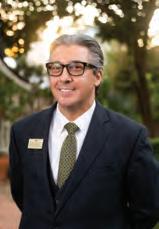
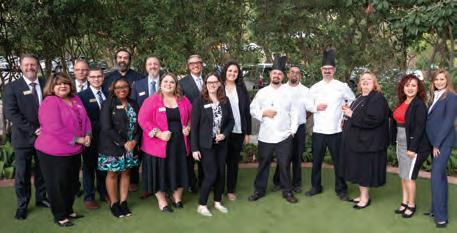



DISTINGUISHED GOLF DESTINATIONS
Salish Cliffs Golf Club: A Tapestry of Tradition, Renovation and Excellence
Salish Cliffs Golf Club, a Distinguished Golf Destination with Exceptional status nestled in the scenic beauty of the Pacific Northwest, stands as a testament to the fusion of golfing excellence, rich history and a commitment to community.
In this exploration of Salish Cliffs, we delve into the meticulous care put into maintaining the course, the recent bunker renovations, the approach to employee management, the diverse lodging options and support for the Squaxin Island Museum and Library Research Center. Finally, we conclude with the club’s perspective on being a Distinguished Golf Destination.
THE
OVERARCHING
EMBRACE OF TRADITION
Salish Cliffs Golf Club’s journey is steeped in history. Its roots trace back to 2011. The course, which intertwines seamlessly with the natural beauty of the region, has not only aged like fine wine but has also been meticulously maintained to preserve its original charm. The undulating fairways and strategically placed hazards contribute to a challenging yet rewarding golfing experience.
“Our commitment is to preserve the legacy of Salish Cliffs,” said Tyler Brown, head golf professional. “We invest in cutting-edge technologies while respecting the course’s traditional design. It’s a delicate balance between modernization and preservation.”
Bunker renovations: A contemporary touch to tradition: Recently, Salish Cliffs embarked on a comprehensive bunker renovation project, breathing new life into an already exceptional golfing experience. The resort collaborated with renowned golf course architects to enhance the strategic placement of bunkers, ensuring they challenge seasoned players and provide a welcoming environment for newcomers.
Investing in people: The key to excellence: While the course is undoubtedly the star attraction, Salish Cliffs understands that its success also hinges on the people who make it run seamlessly. The resort prides itself on a robust hiring process focused on identifying individuals who not only excel in their roles but also embody the spirit of hospitality.
“We believe in investing in our people. Training programs, competitive benefits, and fostering a positive work environment are our cornerstones. Happy employees translate to happy golfers,” Brown emphasized.
Retaining quality staff is equally crucial. Salish Cliffs has implemented initiatives like mentorship programs and continuous skill development to ensure employees find a long-term career path within the resort.

Lodging options: From cozy retreats to luxury suites: Beyond the golf course, Salish Cliffs offers a diverse array of lodging options, catering to the preferences of every guest. From cozy cabins nestled in the woods to luxurious suites overlooking the fairways, the resort provides a sanctuary for relaxation after a day on the greens.
Community commitment: Supporting the Squaxin Island Museum and Library Research Center: Salish Cliffs recognizes the importance of giving back to the community. A testament to this commitment is its support of the Squaxin Island Museum and Library Research Center. The resort actively engages in fundraising events, sponsorships and collaborative projects that promote the preservation of cultural heritage and education.
The resort appreciates its connection with the Squaxin Island Tribe. Contributing to the preservation of history is an honor. It’s not just about being a golf destination. It’s about being part of a larger community fabric.
DISTINGUISHED GOLF DESTINATION: A CULMINATION OF VALUES
As a Distinguished Golf Destination, Salish Cliffs embodies a commitment to excellence, preservation, community engagement and an unforgettable golfing experience. It’s not merely a label but a reflection of the resort’s core values.
The ownership behind Salish Cliffs envisioned a place where golf isn’t just a sport but an immersive experience. To be recognized as a Distinguished Golf Destination validates ownership’s efforts. It’s a commitment to surpassing expectations and creating lasting memories.
Salish Cliffs is not just a golf course. It’s a journey through time, a celebration of tradition and a dedication to creating an unparalleled golf haven. The careful preservation of the course, the recent renovations, employee management, diverse lodging options, community support and the honor of being a Distinguished Golf Destination all come together to form the rich tapestry of Salish Cliffs. BR



RONALD BANASZAK
Ronald Banaszak, CCM, CCE, BoardRoom Distinguished Club Executive Vice President of International Business Development. Ron may be contacted at (415) 420-5183 or ron@boardroommag.com.
World Golf Village, A Balance of Luxury and History
Few places are as special and luxurious as World Golf Village in St. Augustine, FL. For those looking for a complete resort experience, World Golf Village has it all: exceptional dining, fantastic golf, a resort lifestyle (via spacious villas or stylish hotel rooms) and the World Golf Hall of Fame.
While the property is best known for the quality of experience throughout the resort, the King & Bear golf course is the jewel. The King & Bear is best known as the only golf course co-designed by Arnold Palmer and Jack Nicklaus. It is named after the golf legends. Palmer earned the nickname “The King” during his playing career and Nicklaus adopted the “Golden Bear” moniker.
Combining the contrasting styles of the two designers created a challenging course that incorporates features from traditional Scottish-links courses and new traditions in American golf. The course is known for the numerous lakes bordered by large coquina rock that come into play throughout the course. This rock is unique to Northeast Florida, one of the only places in the world where it may be found. Loblolly pines dot the front nine while decades-old oak trees provide shade for the back nine.
World Golf Village takes great pride in maintaining its golf course to the highest standards, ensuring that every tee box, fairway and green is in top condition. What sets World Golf Village apart is its dedication to customer service. The staff is trained to go above and beyond to exceed everyone’s needs. Overall, the staff is committed to quality and focuses on exceptional service, solidifying the club’s status as a premier destination for golfers and non-golfers alike.
At the King & Bear, feedback from members, guests and employees is highly valued. It is crucial for continuous growth and improvement. To facilitate this, World Golf Village has implemented the “Talk to The Manager” texting program, prominently advertised throughout the club. This software enables anyone to send a text message, which is distributed anonymously to all department heads. This allows managers to respond promptly to customer needs and ensure a high level of satisfaction.
Lon Grundy, general manager of World Golf Village, is a 30-year “lead by example” veteran club leader. It is important for him that World Golf Village is designated as a Distinguished Golf Destination.
“Being recognized as a Distinguished Golf Destination signifies a commitment to delivering exceptional experiences for our members and guests,” Grundy said. “It reflects an unwavering attention to detail, not only in maintaining well-kept facilities but also in going above and beyond to create memorable moments.”
While at the King & Bear, members and guests can visit the hall dedicated to Palmer and Nicklaus. This exhibit features inspiring quotes from the two and photos of them on and off the course. The World Golf Hall of Fame members, both inducted in the inaugural class in 1974, spotlight their decades-old friendship rather than their storied rivalry.
Effective communication and a shared commitment to success characterize the management team’s relationship with the property owners. Despite the owner being out of state, management has established a system to keep ownership informed and engaged. A weekly scorecard serves as a comprehensive communication and financial update. This scorecard ensures that the owner receives regular updates on key metrics, financial performance and critical developments within the business.
Grundy has big-picture advice for his colleagues. “Focus on efficiency, consistency and continuous improvement in all aspects of your facility’s operations.” This includes managing costs, streamlining processes and implementing best practices to ensure that your facility is running smoothly and effectively. Regularly review your operations and look for ways to improve and optimize.”


BoardRoom magazine Recognizes the Private Club Presidents of the Year
By Chryssoula Filippakopoulos
Now in its 16th year, BoardRoom magazine annually recognizes the world’s top private club presidents, captains and chairs as Private Club Presidents of the Year, for their outstanding work, their understanding of the industry, and role and responsibilities of the club’s board of directors.
In this continuing series, BoardRoom introduces six of its top 20 presidents for 2023. The Distinguished Club President was featured in the January/February 2024 issue. Private club board presidents play a huge role in professional operations of their clubs as a volunteer working diligently with their board of directors and general managers, striving for well informed, but not emotional decisions. This recognition by BoardRoom magazine has attracted board president nominations from clubs and other nominators around the world. These outstanding presidents exemplify the focus on the leadership responsibilities, the accountability and the management of the board providing a healthy respect for the club’s macro management. They are cognizant of the importance of working, effectively and efficiently, with their volunteer boards and the dedication required from everyone with whom they work.
Key elements of a “good” board include commitment, competence, diversity, collective decision making, openness, transparency, effective communication with the management and the membership, fiscal responsibility, development and establishment of the clubs’ mission, vision and policy direction, especially through establishment of a strategic plan. A successful board president draws upon the expertise of other board members, the club’s institutional memory and stewardship of the club’s resources.
As well the board president provides new board members and future board presidents with information they need to perform effectively as board members.
Congratulations to these outstanding private club board presidents.

Private Club Presidents of the Year Major Sponsors



Liza Barnett Emmet has been a leader in the financial services industry for over 25 years. In 2023, she became the first female commodore in the 148-year history of the Florida Yacht Club.
“Liza has been an enterprising leader and tireless trailblazer in positioning our club for future generations,” said Carol Edell, the club’s general manager.
“Her determination to ensure the Florida Yacht Club ranks among the best in the nation is exemplified by her commitment to listening to others and understanding the scenarios involved in running a club before making any decisions,” Edell added.
“Liza is consummately honest, overflowing with integrity and wants the best for the membership and staff members alike.”

With the costs of running a first-class club ever increasing, Barnett Emmet led the development of policies to protect the value of club membership and ensure the club’s financial health.
“Our members deserve to have the value of their membership at the forefront, and that thought is at the core of every decision we make,” Barnett Emmet opined.
She ensured the board understood the club business model in which dues support day-to-day operations, and initiation fees and capital assessments fund capital improvements. These are critical for the club’s multi-million-dollar renovation and financial health. Barnett Emmet provided club managers with the resources and tools they require to benefit the member experience and refused to cut costs at the expense of affecting the quality of the operation.
Eliminating non-member banquet business, for example, has allowed staff members to focus 100 percent on member dining and member events, reducing the impact on member parking and wear and tear on the clubhouse.
She set the tone for subsequent board meetings by inviting Jim Butler and Mike Moran of Club Benchmarking to the annual board retreat, where the focus was on creating strategic initiatives. The resulting initiatives ranged from governance and finance to membership and programming. Board members were assigned initiatives, met with teams and reported back during board meetings. This allowed board meetings to focus on major issues rather than day-to-day club operations.
Barnett Emmet, a sixth-generation native of Jacksonville, drew on her deep ties to the community when she was elected to the Florida Yacht Club board in 2015 and selected to be on the flag in 2019, which means she began serving as a board member. The flag order is as follows: treasurer, secretary, rear commodore, vice commodore and commodore, with board members serving a one-year term in each role. BR
JIM DOEHRING, PRESIDENT | EDGEWOOD COUNTRY CLUB | BURR RIDGE, IL

JIM DOEHRING PRESIDENT

Jim Doehring is leading the way at Edgewood Valley Country Club during a time of change.
In 2022, club members approved an $18 million renovation project that will significantly enhance the club’s amenities while securing its future.
“I was lucky to build upon the work completed by the last three presidents and their boards, as it took years of planning and research to bring this project to life,” said Doehring, president of Burr Ridge, IL club.
“While the final task of gaining approval landed with our board, their efforts to endorse the project
were crucial to its success, and I am fortunate to be at the helm of it all at such an exciting time.”
Doehring, who grew up in the suburbs of Chicago and graduated from North Park University, keeps the excited and curious membership informed of the renovation progress through monthly communications with construction updates and photos. Even without a clubhouse, members enjoyed the food and beverage program, made fun and inviting by the staff.
“Jim’s positive and practical approach is complimented by his deep admiration for the health of the club and its membership,” Paul Geallis, general manager of Edgewood Valley Country Club, said about Doehring, who joined the club in 2015 with his wife, Amy, and their twin sons.
“He has a familiar and progressive leadership style that has resonated with seasoned and new members alike. He has been a uniting force among the board, getting ahead of issues and ensuring all members have an opportunity to provide feedback for significant capital projects.”
The board and general manager work together to carry out the club’s objectives, including planning for the future through standing committees and improving the member experience. Doehring has been instrumental in shaping the club’s strategic vision by understanding the pulse of the club and upholding the membership’s best interests.
He started his career with the Lettuce Entertain You restaurant group before getting into the wine business, working in both distribution and supply and later starting his own company, Source Code Beverage. BR
LIZA BARNETT EMMET COMMODORE
CAROL EDELL GM
PAUL GEALLIS GM
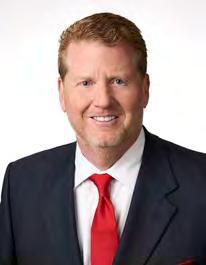
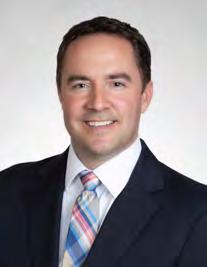
Passionate and energetic.
Two words Bryan Stone, general manager and chief operating officer of the Westwood Country Club, uses to describe President William Doyle.
“He addresses challenging topics with vigor while maintaining a comfortable and engaging environment for governors to speak their mind honestly and openly,” Stone said.
“President Doyle was present and accessible to both management and members and was eager to provide support and ease the burden of challenging topics or conversations. He gave committees with the freedom to conduct due diligence and present proposals for board consideration.
JIM

JIM FOLEY PRESIDENT


ERIC HOGAN GM/COO
From the minute Justin Foley began his tenure as president of Exmoor Country Club, he was committed to advancing its mission to provide the finest golf, sporting and social experiences for members and their guests. He has kept the board and management team focused on that mission.
As a result, the member experience has improved through expanded and elevated programming, a focus on service excellence and a sustained and fully funded investment in facilities.
“Justin is the best leader there is,” said Eric Hogan, Exmoor’s general manager and chief operating officer.
Mr. Doyle provided a balance of professionalism and seriousness while maintaining an environment of fun.”
Westwood has always embraced a family-friendly brand and preserving legacy membership opportunities for future generations of members was a board priority. Doyle led the board as it revisited the club’s outdated and ineffective legacy membership program.
The board engaged with the membership, finance and bylaws committees and with management to explore long-term solutions. President Doyle and the board members were transparent with their findings and they sought reaction and feedback from members. After months of careful consideration, review and revision, the board presented a revised legacy membership program that 79 percent of the membership approved.
In addition, a renewed focus on fiscal conservatism and responsible and efficient management helped maximize the capital fund for future capital investment needs. Member vision and member experience surveys evaluated overall satisfaction with the club and identified opportunities for improvement and investment.
After Westwood completed more than $17 million in long-range plan clubhouse renovations and expansions in October 2022, Doyle and the board asked GM Stone to develop a new five-year strategic plan. The president and the board volunteered the necessary support and resources for the project but also confirmed confidence in management’s ability to lead the effort.
Doyle, who graduated from Penn State University, is an entrepreneurial enterprise software executive with a consistent record of exceeding business and revenue objectives. He was vice president of Decision Management Group and CEO of WorldQuant Predictive. Doyle and his wife, Tina, along with their children, Declan and Bevin, have been Westwood members since 2009. BR
PARK, IL
“He has vision and passion. He has committed a tremendous amount of time to understanding the business model of a private club. He is collaborative, understands the governance model and works within it. He tasks committees to develop recommendations, fosters healthy discussion at the board level and entrusts the professional staff to manage the operation.
“He is a fantastic strategic partner for me, simultaneously relying on me and supporting me. He is a great boss, mentor and cheerleader for me and my team.”
Foley led the board and management team in developing a funding and marketing plan for an $8.3 million capital improvement project involving the pool complex, outdoor and clubhouse dining spaces and the main kitchen.
The proposed funding model depended solely on member equity. Seventy-five percent of the members supported the project. Work is scheduled to wrap up in June. Because of Foley’s efforts, the club will be well-positioned with expanded and refreshed dining amenities, and future boards will be debt-free when considering other capital projects. Thanks to the work of Exmoor’s previous boards and general managers, the club embraces the industry’s best practices. The board is committed to funding the property’s capital needs and honors the club’s 127-year history while committing to its future success. Exmoor embraces the board-GM/COO model and develops and adheres to a five-year strategic plan. Each year, the board develops plans that support the pillars of the strategic plan.
Foley grew up in Chicago and graduated from the University of Notre Dame. He has had a distinguished career in the capital markets and trading industry. He is co-president and head of trading at Gelber Group. Foley has served on the board of several nonprofit organizations. He and his wife, Erin, have raised their four children at Exmoor. Their oldest son recently joined as a legacy member. BR
WILLIAM DOYLE PRESIDENT BRYAN STONE GM/COO
FOLEY, PRESIDENT | EXMOOR COUNTRY CLUB | HIGHLAND


When he discusses the achievements he realized at Carmel Country Club in 2023, President Bill Hamel is quick to praise the efforts of his fellow board members and the team.
“It’s important to me to note that these accomplishments are all plural as the board and the Carmel team helped drive these successes,” Hamel said.
“(Last) year presented a number of challenges, but I’m most proud of how we handled the transition in upper management, worked through the challenges of the new economic realities and ad-

dressed the generational tensions within our membership to provide the best experience possible for all members of our club.”
Carmel’s board is the strategic governing body of the club. During his tenure, Hamel worked closely with his fellow board members, committee liaisons and club management to understand the club’s needs while navigating the construction of the next strategic plan.
Hamel’s dedication to transparency with the membership helped create an open forum for curious members to learn more about their club. He provided the resources necessary to overturn antiquated practices and for members to learn more.
“Bill has proven himself to be a phenomenal leader both inside and outside of the boardroom,” said Aaron Dawson, Carmel Country Club’s general manager and chief operating officer.
“He has worked closely with the board members and club management team to fully understand our club’s needs. His navigation of difficult situations, such as a major dues increase, is commendable. Bill has dedicated himself to learning more about industry best practices through our strategic plan, board retreats, and ongoing governance education.”
Hamel, who has been a member of Carmel Country Club since 2007, worked in the bag room in 1980 and has a unique perspective of how the club operates. He attended Wake Forest University before heading to law school at Campbell University. Hamel is a director and partner at Kirk, Palmer & Thigpen PA. He and his wife, Kelly, have two children (Brady and Hope) and a golden retriever (Millie). In his free time, Hamel enjoys sports, gardening, cooking, beer and a good tequila. BR
MICHAEL HARTRICK, PRESIDENT | TORONTO LAWN TENNIS CLUB | TORONTO, ON, CANADA

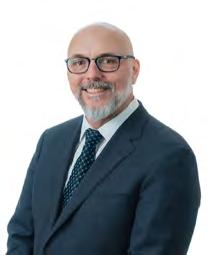
“He has truly shaped a path of shared success for the Toronto Lawn Tennis Club.”
So said David Main, the club’s general manager, about President Michael Hartrick.
“During Michael’s time on the board, and particularly as president, he has embraced collaboration, championed good governance, steadfastly nurtured a ‘club first’ stewardship mentality and thrived as a perpetual learner,” Main added.
Hartrick, who joined the Toronto Lawn Tennis Club in 1993, was elected to the board in 2019. He served as governance chair for two terms before becoming president in 2022.
With his focus on the club’s long-term success, Hartrick collegially led a consensus-driven team to key achievements, including the introduction of capital dues and a facilities renewal project for which shareholders carried the vote in the fall of 2023.
“Presenting the Serving Our Future Project Plan to shareholders and their unprecedented engagement were made possible through countless hours volunteered by members, the full support and commitment of fellow board directors and also of our GM, David Main, and many members of his team,” Hartrick explained.
“When needed, David advanced the process as facilities planning committee chair, ensuring the board received an expert data-driven recommendation.”
Introducing capital dues in 2023 was a strategic initiative benefiting the Toronto club in multiple ways, including improving member experience. Capital dues allow for the timely repair and replacement of depreciated assets and free management to undertake progressive programming with unencumbered operating dues, both of which advance member use and enjoyment of the club. Members are now engaged as stewards of the club and contribute to securing its future.
Hartrick advocates for effective governance, particularly where it guides the relationship between the board and management. Under his leadership, the board continues to focus on strategic and policy decisions while working collaboratively with Main and the senior management team, respecting the strategic plan, budgets and succession.
Hartrick and his wife are avid tennis players who also enjoy the club’s many amenities, particularly food and beverage. Hartrick is a child welfare lawyer and counsel at child mortality inquests. He is also a provincial adjudicator serving the Child Abuse Register. BR
BILL HAMEL PRESIDENT
MICHAEL HARTRICK PRESIDENT
AARON DAWSON GM/COO
DAVID MAIN GM

Excellence in Club Governance
Excellence in governance is key to success for private clubs. BoardRoom magazine is featuring a series of articles written by Henry DeLozier, a partner with GGA Partners, an international consulting firm and trusted advisor to private clubs, golf clubs and residential communities around the world.
This issue features Governance – Addressing Transparency. As society becomes more open and increasingly skeptical, club members demand greater transparency from their boards. Whether in member focus groups, general meetings of members or the club dining room, members seek greater transparency. Three factors are proving critical to highly effective private club boards: (a) communication methods, (b) communication cadence, and (c) nondisclosure rules. Read more on page 103.
Red Flags in the Boardroom. Most private club board leaders are aware of their duties as fiduciaries thanks to a steady drumbeat from BoardRoom magazine and other leading thought sources. Generally speaking, they know that they are bound by duties of care, loyalty and obedience. The duty of care indicates that directors must be prepared, informed and present for board service. The duty of loyalty means that directors must place the club above themselves to ensure that their efforts are guided by what benefits the club. And the duty of obedience requires that directors adhere to club bylaws and governing rules. Everyone knows these things … right? Read more on page 104.
EXCELLENCE IN CLUB GOVERNANCE

HENRY DELOZIER
Henry DeLozier is a partner at GGA Partners. He can be reached via at henry.delozier@ggapartners.com
Governance – Addressing Transparency
As society becomes more open and increasingly skeptical, club members demand greater transparency from their boards. Whether in member focus groups, general meetings of members or the club dining room, members seek greater transparency.
Three factors are proving critical to highly effective private club boards: (a) communication methods, (b) communication cadence, and (c) nondisclosure rules.
Boards are encouraged to heed three primary factors:
1. Establish and normalize the board’s communication methods. Develop a comprehensive communication plan for the club and make board communications an important and consistent part of the club’s communications. In so doing consider:
a. Topics of interest – Most club members seek a sense of “belonging.” See that they are invited to suggest topics of interest to them. In most clubs, that roster of needs includes activities and events, human interest stories about fellow members and staff, and the latest programs for each member segment.
To ensure a sense of inclusion, see that members are aware of important activities well in advance of the sign-up or registration periods.
b. Multiple media options – Rely upon a wide array of media tools ranging from social media, email, postcards, and posters within club buildings. Most clubs serve multiple generations with preferred and most commonly used media options. Recognize that different subsets of the club’s members – separated by gender interests and generational media usage –require recognition and programming.
2. Maintain a reliable cadence of communications. Establish, announce and honor a realistic cadence of communications by topic and by membership category to help your members know what to expect and when. There are several keys to an effective communications cadence:
a. Communications profile – Develop an understanding of communications preferences for each member. Understand when – by day of the week and time of day – each member wants communications from the club. Understand what media options each member prefers. Use it.
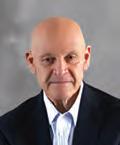
b. Communications calendar – Publish the communications calendar to enable all members to watch for the topics of greatest interest to them. Keep it. Ensure that members and staff are well aware of the schedule and have ready access to each communication.
c. “Big events” communications – For the most popular club-wide events, such as the member-guest, holidays with Santa, parent-child dance, interrupt the normal cadence to draw attention to these special occasions.
3. Be transparent about the topics which will not be disclosed. Some topics – such as matters of club member discipline, employee compensation and benefits, and contract negotiations while in process – are confidential and should not be disclosed. Make it clear to members that topics require confidentiality of board members … and honor that confidentiality requirement. Be understanding and consistent to demonstrate that the board seeks the openness many members desire except on these important points.
Be transparent about what topics the board will not divulge for reasons of confidentiality and employee/member privacy.
Some members want to see board meeting minutes and the club’s financial information, such as the balance sheet and income statement. The board should develop and broadly communicate what information it will share with members and in what format. The board is well advised to remember that these reports should be considered confidential and, therefore, not readily distributed outside of the club membership.
Beyond members’ demands for greater transparency, effective boards want club members to be well-informed and engaged with their clubs. Private club boards must maintain highly effective, truthful and consistent communications with club members. The rewards are greater member satisfaction, member engagement and a restful night’s sleep for board members. BR
HENRY DELOZIER
Henry DeLozier is a partner at GGA Partners. He can be reached via at henry.delozier@ggapartners.com
Governance – Red Flags in the Boardroom
Most private club board leaders are aware of their duties as fiduciaries thanks to a steady drumbeat from BoardRoom magazine and other leading thought sources.
Generally speaking, they know that they are bound by duties of care, loyalty and obedience. What red flags, then, should they watch for in the boardroom?
The duty of care indicates that directors must be prepared, informed and present for board service. The duty of loyalty means that directors must place the club above themselves to ensure that their efforts are guided by what benefits the club. And the duty of obedience requires that directors adhere to club bylaws and governing rules.
Everyone knows these things … right? No. In fact, many board members put themselves and their parochial interests ahead of the club and choose not to adhere to their duties. Four red flags are waving in club boardrooms when this occurs:
1. Preparedness – Most board members have not studied board materials before the meeting is called to order. How can you tell? Usually, they are rapidly skimming board reports and information once seated.
The lack of preparation indicates that board members are too busy or too disinterested to prepare for the meeting. It is a signal that should not be overlooked.
How to address those who are ill-prepared: Be respectful and direct in a one-on-one conversation. “I see that you are not prepared for board meetings. Are you too busy? Or is there a reason you do not prepare to serve well?” If the problem continues, suggest that the unprepared individual stand aside for others who will take board service responsibly.
2. Confidentiality – Like that of any other corporation, club business is confidential and proprietary. This means that board deliberations and discussions are not to be shared outside the boardroom. Not even at the gin rummy table in the men’s grille … or in the beauty salon … or even at the grocery checkout counter.
Too often, board members forget that their club is a corporation which requires board members to comply with the same standards as a publicly traded entity such as General Electric or Apple. The incapability to respect and preserve the confidentiality of the boardroom is a warning that the board chair and others should not ignore.


How to address those who are not confidential: Mark all board documents as “confidential” and advise indiscreet board members that they should not serve on the board if they cannot be relied upon to maintain the trust and confidentiality of fellow board members. If the problem persists, ask the board members to stand down.
3. Collegiality – A growing frequency of bullying is evident in club boardrooms. Often, this behavior arises from frustration or non-board differences in lifestyle, interests and/or backgrounds. Boards that perform well conduct discussions and even disagreements in a patient and respectful manner. Bullying is a red flag.
How to address those who are bullies: Advise them that the behavior must be stopped. Do not equivocate or make excuses. Effective servant leadership requires mutual respect. Bullying behaviors should not be tolerated, and bullies should be asked to surrender their seats on the board.
4. Micromanagement – Many board members in private clubs are exceedingly supportive and want the best for their clubs. Some board members cannot oversee without needing to take over. Turning off the impulse to tell others what to do is essential to effective board service. The board exists to empower and enable the management team to perform well. Board members becoming overly involved in tactical matters and management are a decided danger to the club.
How to address those who micromanage: Explain to board micromanaging members that others observe their overreaching behavior and believe it is a disservice to the club and its management team. The board chair should discreetly instruct offending board members to cease their overreaching behavior.
Board leaders do well to watch for the red flags that can undermine the efforts of an otherwise strong board. BR
GORDON WELCH
Gordon Welch, president of the Association of Private Club Directors, has over 20 years’ experience in private clubs and 12 years of experience as an association executive and registered lobbyist. For more information or to discuss your orientation you, can reach him at gordon@boardroominstitute.com or (918) 914-9050

Best Practices of Board Members
Being a board member of a private country club comes with prestige and responsibility. To ensure the smooth functioning of the club and the satisfaction of its members, board members must adhere to best practices. Here are the top 10 best practices that can guide board members in their roles.
1. Commitment to vision and mission: Board members should have a clear understanding of the club’s vision and mission. Aligning decisions and actions with these guiding principles ensures that the club remains focused on providing an exceptional experience for its members. If your club does not have a mission statement, stop everything you’re doing, gather the board and write one.
2. Transparency and communication: Transparent communication is the cornerstone of a successful country club. Board members must keep members informed about important decisions, financial matters and upcoming events. Regular newsletters, social media posts and an open-door policy can foster a culture of transparency. Communication is as important as membership. Today, I spoke with a club that has five employees in the communication department.
3. Financial stewardship: Managing the club’s finances responsibly is a key duty for board members. Regularly reviewing budgets, overseeing financial reports and ensuring that dues are used effectively contributes to the club’s long-term financial health. Most clubs need a financial health checkup. A review of your balance sheet is a good place to start.
4. Membership engagement: Actively engaging with members is essential for understanding their needs and preferences. Board members should encourage feedback, help organize member events and establish committees to involve members in the future of their club.
5. Strategic planning: Developing a comprehensive strategic plan is vital for the club’s success. Board members should work collaboratively to set long-term goals, anticipate challenges and devise strategies to enhance the overall experience for members. It’s easy to want to do it yourself, but I highly recommend you get a third party to assist you.
6. Compliance and legal responsibilities: Country clubs operate within a framework of laws and regulations. Board members must stay informed about legal requirements, ensuring that the club complies with all applicable rules. This includes issues related to employment, safety, membership rights and 501c7 issues.
7. Professional development: Board members should actively seek opportunities for professional development. Staying informed about industry trends, attending conferences and participating in workshops can enhance leadership skills and contribute to better decision-making. This is true not only for the board but for senior staff as well.
8. Ethical conduct: Upholding the highest ethical standards is paramount. Board members should demonstrate integrity, honesty and fairness in all their dealings. This fosters a culture of trust among members and ensures the club’s reputation remains untarnished.
9. Risk management: Identifying and mitigating risks is crucial for the long-term sustainability of a country club. Board members should conduct regular risk assessments, implement necessary safeguards and have contingency plans in place to address unforeseen challenges.
10. Succession planning: Recognizing that board positions have term limits, you need to have a wellthought-out succession plan. This ensures a smooth transition of leadership, preserving institutional knowledge and maintaining continuity in the club’s operations.
Being a board member of a private country club is an honor and a responsibility. By adhering to these 10 best practices, board members can contribute to the success and sustainability of the club. A commitment to transparency, financial stewardship and member engagement, coupled with ethical conduct and strategic planning, forms the foundation for a thriving private country club that stands the test of time. BR
IDEAS
Detroit Athletic Club
Children Share Their Creativity at Art Exhibition

The youngest members of the Detroit Athletic Club, a BoardRoomDistinguishedClub in Detroit, MI, are unleashing their inner Leonardo da Vinci through the club’s annual youth art exhibition.
“We are always looking for ways to introduce the DAC to our future generations of members,” says Lyz Mickley, the club’s youth and family activities manager.
“It was started to give children a way to get involved at the DAC and be proud to see their artwork displayed,” Mickley says about the youth art exhibition, which began in the winter of 2021 for member children 17 and under.
Mickley buys supplies from the art store and prepares kits for families.
“It takes a good amount of time and effort to make sure they are all accurate and have all the supplies needed, especially since we have grown in canvas size and amount of participants,” Mickley says.
She prepared 96 art kits for the 2023 youth art exhibition, 22 more than the year before.
The children receive the kits at the beginning of November and have two to three weeks to complete their paintings at home. The theme of their artwork changes every year.
The submissions for the most recent youth art exhibition showed scenes from the children’s favorite DAC memories, such as the youth bowling league, Christmas celebrations and swimming in the pool.
A new addition to the 2023 youth art exhibition was the pasta and painting party at the club. Ten families (42 people) attended. After lunch, the young artists worked on their masterpieces in one of the banquet rooms for two hours.
The results of the children’s creative pursuits hang on the walls of the club’s third-floor art gallery hallway for a period that runs roughly from Thanksgiving week to mid-January.
The youth art exhibition has proven to be a hit.
“Although there are no awards given for the show, we measure the success of the event by the increase in participation each year and the excitement on the kids’ faces when they come back to visit the DAC and can show off their artwork to their family members,” Mickley says.
“Our membership loves to see the creativity from our kids each year. Although many members are used to fine art at the club, this is a very colorful welcome change to brighten up our third-floor art gallery hallway. Our employees also enjoy visiting the artwork and seeing the creative depictions from the kids.”
The youth art exhibition has become a yearly tradition in the household of club member Steve Gaura.
“After the artwork is hung, my boys are proud to show off their work, and it gives me a whole new appreciation of what the DAC has to offer,” Gaura says. BR




Chryssoula Filippakopoulos is the copy editor and Innovative Ideas editor with BoardRoom magazine. She was a newspaper reporter for more than eight years and worked as a marketing and communications specialist for 16 years. She is a graduate of the School of Journalism at Toronto Metropolitan University (formerly Ryerson University) in Toronto, ON. If you have an Innovative Idea you’d like to submit, please send them to boardroom@studiodelmar.net
Flint Hills National Golf Club
Field Guide Gives Members a New Way to Enjoy Their Club
With the field guide in one hand and binoculars in the other, members and guests of Flint Hills National Golf Club in Andover, KS, have what they need to set out on self-guided tours of the grounds and enjoy the club in a new way.
“The field book helps you enjoy the plant and animal life of our superb golf course,” said Myra Devlin, who came up with the idea for “Walk with Nature at Flint Hills National Golf Club: A Field Guide of Animals & Plant Life” and led the project.
“It (Flint Hills National) is a place to get away from the rigors of city life and let the sights and sounds of nature ease your mind and body,” added Devlin, the wife of Tom Devlin, the club’s owner.
The easy-to-read, aesthetically pleasing field guide was born because of the questions members and guests have asked over the years about the animals and plant life found on the grounds.
“It is universal in appeal and gives everyone, across all classes of membership, another way to enjoy and utilize the club,” Christina Gusella, the club’s assistant general manager, said about the 115-page book, which took about a year to complete. It comes with a pullout map of the property.
Gusella said Flint Hills National management and staff collaborated with the surrounding community on the field



guide. Staff, especially the grounds and landscaping teams, contributed content. Local artists created the illustrations and graphic design, local print shops printed and bound the book, and staff at the Kansas Department of Wildlife and Parks fact-checked the text.
Field guides are for sale at the pro shop. Members and guests who want to browse the field guide quickly will find one in the clubhouse hallway, where they will also find a display highlighting some of the information in the guidebook.
The response to the field guide has been positive.
“Our members seem to value its uniqueness and creativity,” Gusella said. “I believe our members take pride in the knowledge that the field guide provides, and for both our members and staff, it is exciting to know that wildlife and plant life continue to grow and flourish on our grounds through our continued efforts.”
For employees, the field guide is a way to show off the club’s features.
“Our ‘Walk with Nature’ field guide truly showcases the charm and serenity of Flint Hills National Golf Club,” commented Matthew Prater, lodging director. “From the largemouth bass to the bald eagle, the wildlife we have here is so beautiful and diverse, not to mention our amazing plant life.” BR





CHRYSSOULA FILIPPAKOPOULOS

GREGG PATTERSON
Gregg Patterson is founder and president of Tribal Magic. He can be reached via email: GJPAir@aol.com
Fun Times on ‘The Fantasy Nine’
Delicious
I have a dream.
This is the dream of an Old Geeky Guy, a walker and a talker who hasn’t played much golf, and what golf he played was really bad.
But when he played, the playing was fun.
This Old Geeky Guy dreams of a golf course called The Fantasy Nine, where fun is delivered in the clubhouse and on the golf course, where the best bits and pieces of conventional golf, pitch and putt, miniature golf, Top Golf, adventure golf and after-golf are combined into a delicious recreational stew, a place where the four Big Uglies of golf—too much time, too difficult, too expensive and too little fun—are banished to the dustbin of history. Fun? Golf? Huh?
The serious will scream, and the pros will snicker. Don’t get me wrong. This Old Geeky Guy celebrates people who love serious golf, who play on world-class courses, compete in tournaments, win the Open, master the Masters. This Old Geeky Guy enjoys walking great golf courses, tagging along with a talented foursome, talking to caddies, exploring the clubhouse, hearing the stories and experiencing the warm embrace that great clubs deliver.
But in his dreams, this Old Geeky Guy sees something different—a golf experience that delivers fun with lots of laughs, lots of yak, a bit of exercise and a smidgen of challenge, with a “linger longer” clubhouse energized with an employee team delivering The Warm Embrace.
A Fantasy Nine.
THE WISH LIST
This Old Geeky Guy has a long list of wants for The Fantasy Nine.
The Fantasy Team: The Fantasy Nine has a hospitality-centric employee team that’s focused on delivering The Buzz, The Love and The Glow, a group of club enthusiasts who deliver The Warm Embrace from the time The Old Geeky Guy arrives to the moment he exits, a team that calls
him by name, gives him The Big Welcome and asks where he’s been traveling and how well he’s been doing.
There’ll be a front desk staffer who follows up his online reservation with a chirpy call to confirm the time, the foursome and the club’s emphasis on fun.
There’ll be a pro who shouts out the glories of golf, oozes with enthusiasm for the course, encourages The Old Geeky Guy when he’s droopy, sends him notes on his birthday and emails memory photographs when he’s played.
The Fantasy Nine will be a place where the starter knows and likes The Old Geeky Guy and assembles a fun-focused-foursome that does golf the way fun golf should be played.
The Fantasy Course: The Old Geeky Guy will be greeted in the pro shop by a sign that shouts out “This Is Us”—The Fantasy Nine—Fun, Fast and Social!!!”
There’ll be an after-you-arrive-and-before-you-play three-minute “psyche zone” with meditation, green tea, music and breathing exercises to help distance The Old Geeky Guy from “out there” and prepare him for fun times “in here.”
The Fantasy Nine will have a warmup driving range with a free bucket of well-used golf balls and dozens of metal targets, a putting green that makes The Old Geeky Guy feel good whenever he putts, a Track Master on every tee, nine short undulating fairways, a narrow “un-rough” rough, 15inch holes, lots of visual entertainment (plenty of trees, city views, rolling countryside) with lots of small hazards that are “score-reduction” targets (puddles, sand traps and metal silhouettes).
The Fantasy Rules: Linger time in the clubhouse must equal playtime on the course. Casual “anything goes” dress is permitted and encouraged. A two-point reduction for the “long ball” off the tee. Three clubs only—player’s choice, carried by hand—no bags allowed. Speed is a “must do”— tee up fast, walk fast, talk fast, abandon lost balls, toss balls from the traps, the rough and the woods.
More rules. Golf carts are “verboten” unless you plead and weep and offer up your youngest child. Swings only count if you hit the ball. Unlimited mulligans. Tee up the ball from anywhere at any time. Hit one of the hazards—Fat Guy metal targets, sand trap, boulder, mid-fairway stumps—and get a one-point reduction. Find someone else’s lost ball and get a one-point reduction. Place your ball where you hoped it would go, pick your ball up in the middle of the hole, and skip a hole if you need a break.
And at The Fantasy Nine, players must record interesting stories, bizarro bets, noteworthy characters and bizarro situations on the scorecard to stimulate postplay, hang-time discussion.
The Fantasy Hang: Linger time is a biggie at The Fantasy Nine. Long Time Hang Time will be a “must do” in the club’s “attitude readjustment zones,” where whatever happened “out there” is replaced by a laugh-at-the-madness bonding opportunity “in here.” The Fantasy Nine will provide indoor and outdoor “linger locations” with cheapo tables and chairs, offer right-priced comfort food and libations, and energize the spaces with upside surprises—raffles, games, quizzes— to elevate The Laugh Factor during The Linger.
The Fantasy Price: At The Fantasy Nine, prices will be rock-bottom cheap. There’ll be special prices for kids, families, old people, first-timers, extreme high handicappers, highly entertaining characters and frequent users. There’ll be loaner clubs for free, three sleeves of “lose ‘em and forget ‘em” used balls for free, a bucket of junko practice driving range balls for free. There’ll be pro shop goodies at Walmart prices, one free “we’ll teach you how to play The Fantasy Nine in 30 minutes” lesson for first-timers, value-priced lessons for individuals and groups, and a free hot dog, diet soda and cup of greasy, salt-encrusted fries for every nine holes played.
WONDERFUL
Serious golf is tough, time-consuming and hugely frustrating, and the journey from Newbie to Accomplished ain’t quick and it ain’t easy.
The Old Geeky Guy knows that Fun Golf can be part of The Golf Adventure. He dreams of Newbies who’ll start by putting in the living room, graduating to miniature golf, enjoying a few hours of Top Golf, transitioning to Fun Golf, moving on to a conventional nine-hole pitch and putt course and finally graduating to a proper 18-hole course, their enthusiasm for the game of golf growing with each chapter in the journey.
The Old Geeky Guy envisions The Fantasy Nine as an alternative for Newbies and Oldies alike. Fun. Social. Cheap. Fast. And hugely entertaining, diverting and energizing.
Dream the dream.
And enjoy the journey. BR





• Building maintenance/FFE management
• Communications.
We suggest integrating the five strategic pillars relevant to running a successful club into the bonus/review process and attaching key performance indicators to each of these areas to ensure clarity and measurability. For example:
1) Financial sustainability (20 percent of bonus): Operating the club in a way that supports the club’s mission, maintains healthy membership levels and all operating needs as well as capital investment.
a. KPIs to measure:
i. Achieve club annual budget
ii. Ensure all club departments achieve their departmental budgets annually
iii. Achieve/maintain 1,500 total members by yearend.
2) Effective leadership (20 percent of bonus): Leading the club through transparency, effective communication and adoption of best-in-class governance practices.
a. KPIs to measure:
i. Update and improve leadership onboarding to ensure a comprehensive approach, vital sharing of information and systems that will create successful outcomes
ii. Design and deploy ongoing leadership development processes to ensure key staff leaders are consistently educated, developed and invested in.
3) Member engagement (20 percent): Cultivate deep engagement with the membership by ensuring frequent usage, meaningful relationships and emotional connection to create passionate ambassadors who embrace an ownership mindset.
a. KPIs to measure:
i. Achieve/maintain net promoter score of nine or higher
ii. Achieve/maintain previous year member usage numbers or higher.
4) Human capital management/Operational excellence (20 percent): Building a well-trained, best-in-class, highly functioning team of professionals by actively attracting, retaining, developing and rewarding the club’s most valuable assets.
a. KPIs to measure:
i. Maintain/improve team member net promoter score of nine or higher
ii. Design and deploy standard operating procedures for all front-line positions to ensure club standards are consistently met in all areas of the club
iii. Establish an effective retention plan to reduce employee turnover to 5 percent or less.
5) Capital planning (20 percent): Capital asset planning includes equipment, machinery, amenities, buildings, infrastructure and land needs being maintained, reinvested in and replaced in appropriate time frames to ensure facilities are fresh, relevant, functional and appealing.
a. Create a capital reserve study to ensure all club assets are documented
b. Execute kitchen renovation on time and on budget
c. Effectively enhance the employee break room based on responses from employee surveys while completing on time and on budget.
The “weight” of each item and the “weight” of each KPI should change based on the importance of each to the club and its overall goals. How heavily each is rated should be mutually agreed upon by all parties. In addition, board discretion should be used when necessary. Taking the COVID19 pandemic as an example, boards should have the ability to alter, modify or amend the payout plan in the best interest of the club in the event of unforeseen events impacting the operation.
Overall, when creating a review/bonus plan, the following questions should be answered with yes:
• Do the goals support our strategic plan?
• Are the goals SMART? Can we define what success looks like?
• Does the plan reward team and individual performance – not one at the expense of the other?
• Upon accomplishment of these goals, will our club be materially closer to our vision?
Lastly, a case can be made for incorporating 360-degree performance reviews into a club’s performance management system. When considering implementing 360-degree performance reviews, we recommend participants are mutually agreed upon and that all department heads, some board members, some committee members and some members at large are included in the process. This doesn’t necessarily need to be an annual process, as a bi-annual 360-degree performance review is sufficient.
Clear feedback, as a dynamic exchange, benefits the GM/COO, the team, the board and the club as a whole. When GM/COOs actively seek feedback and participate in goal-setting, it demonstrates their commitment to personal and professional growth.
This commitment significantly contributes to the club’s success and fosters a positive, forward-thinking organizational culture. Such a culture not only meets the expectations of younger managers but also positions the club as an attractive workplace for emerging leaders eager to contribute to their own growth and the club’s overall success. BR
Richard Kopplin, Kurt D. Kuebler, CCM & Thomas B. Wallace III, CCM, CCE, ECM are principals with Kopplin Kuebler and Wallace. https:// kopplinandkuebler.com
how their participation in total club experiences truly benefits the members. Immersive, total club experiences create value for every member, ingratiate the department heads and open doors to increasing levels of member participation,” Coyne stressed.
“The golf professional should be the face of the club’s golf operation. They should be front-facing, visible, and always engaging with members and staff,” said Robin Shelton, CCM, PGA Master Professional and general manager of the Newport Beach Country Club, Newport Beach, CA.
“A good golf professional cannot have a singular focus. They need to be engaged with members, tournaments, staff, retail, training, and so many other things. If the golf professional only had a singular focus, it would be like a quarterback in football who can only run one play,” he added.
“The roles and expectations of our golf professionals, including director of golf and assistant pros, align with the overarching goal of providing an unmatched lifestyle experience at Santaluz,“ said Russell Sylte, CMP, PGA Master Professional and general manager and COO of The Santaluz Club of San Diego.
“The responsibilities of a golf pro at a club that aims to offer an unmatched lifestyle experience extend beyond giving lessons and managing the pro shop. They foster a warm, friendly atmosphere, promote golf as a family-friendly activity, organize tournaments and social events, and contribute to the club’s tradition and culture. Their role is integral in ensuring that all family members find appealing activities and services at the club.
“Given the Santaluz mission statement’s emphasis on variety and family inclusivity, the golf pro’s focus should not be singular. Instead, they should embrace a multifaceted role that includes teaching, mentoring, event management, and retail operations, all designed to enhance the member experience and honor the traditions of Santaluz life,” Sylte added.
Are private club golf pros today underutilized and underpaid? If so, why?
“I don’t believe they’re underutilized; maybe they could be included and more involved in all aspects of club business. I always encouraged my head professionals and director of golf to do the CCM certification (through the Club Management Association of America) to make them more marketable and versatile in our industry.
“Underpaid? It depends; the good ones and good clubs are well compensated … there are a number of great golf pros at great clubs that don’t have the size, budget or revenue to compensate at the desired rate. If so, why?” Leemhuis queried.
“Private club golf pros may sometimes be perceived as underutilized and underpaid,” said Santaluz’s GM Sytle.
“This can be attributed to a variety of factors, including traditional club structures that may not fully leverage the
pros’ expertise in enhancing the overall member experience, budget constraints, or a misalignment between club priorities and the allocation of resources. To counteract this, Santaluz ensures that our golf pros are integral to our mission by actively involving them in member engagement and club activities beyond traditional roles, thereby justifying better compensation,” he added.
“Wages for PGA Professionals have increased steadily since 2017, but when you look at the big picture, wages for PGA Professionals in the last 30 years have decreased compared to other department heads at the club,” explained Levy.
“The PGA professional used to be the highest-paid person at the club, sometimes the second highest-paid person behind the general manager. Many times, we see that they are the fourth or fifth highest-paid person at a club.
“One area where the golf professional could increase their wages and increase their value is member retention. When members write their dues check every month, and we all know that clubs with golf have much higher dues than clubs without golf, the issue of whether they have been utilizing the club or not is often the deciding factor as to whether they stay a member,” Levy explained.
“When the PGA professional and their staff do a very good job of engaging with the members, coaching and teaching their membership, running a tournament program that’s inviting to a majority of the membership, they are the face of the golf program. Engaging with the membership makes


JOIN US FOR THE ASSOCIATION OF CLUB CATERING & EVENT PROFESSIONALS (ACCP) National Educational Experience August 25-27, 2024 / Lake Tahoe, NV Includes a Full Day of Education at Martis Camp!



“What an amazing experience! The ACCP truly has a one-of-a-kind skill for inspiring, fun and educational events. Every detail was so impressive. I am so happy that clubs can learn from such an amazing association. What an honor to attend such an extraordinary event!”
-Ronald Banaszak, CCM, CCE, EVP / International Business Development, Distinguished Clubs
“Thank you so much for a great conference! I was so impressed by the quality of education, the participation from the vendors, and the amazing experiences. I can speak from our entire Team at Desert Mountain - there was SO much to take back to our Club!”
-Joe Macke, Clubhouse Manager, Desert Mountain Club
“This conference really gave me a fire in my belly to come back to my club and do more...I want to share that inspiration with my team and hope that we can take our club to the next level!”
-Amanda McCleery / Ballantyne Country Club

Educating the Club Industry. . . One Catering Director at a Time www.TheACCP.com
Contact: Lynne LaFond DeLuca Lynne@TheACCP.com

those members more inclined to keep writing those monthly dues checks. It would be beneficial for clubs to look at an incentive program tied to member retention for the PGA professional and their staff.”
However, there’s often a shortage of assistant pros because of the lack of hours, low pay, and the fact that many can’t afford to live near their clubs. So, what should the duties of the assistant pro be to attract them to the profession?
“Their duties are the same as those of the golf professional but with an emphasis on learning each area by taking responsibility for each area during their time as an assistant. And the golf professional needs to MENTOR!” emphasized Leemhuis.
“Teaching members how to play or improve their golf, or booking tee times, selling golf clothing and balls? All of the above! Who should decide what they do? They should, with guidance and counsel from the GM/COO,” he added.
“Teaching and coaching their members to enjoy all aspects of the game and providing a world-class daily golf experience that promotes for each member the emotion of connection to their club, where they would never think of resigning their membership should be the focus,” added Levy.
“The most important factor in hiring and retaining good assistant golf professionals is providing an environment of growth and advancement for their career. It’s not a coincidence that certain clubs become known as golf professional universities or factories, where a high percentage of the assistants move on to their own head professional or director or golf positions. That is because the professional there is doing a wonderful job of training, educating and advancing their staff members’ careers. Additionally, providing a compensation package that allows them to provide for their family is critical,” Levy accentuated.
“This is not unique to golf,” injected the PGA’s Easterbrook. “Mortgage rates are high; cost of living is high and family priorities don’t make it as easy to move as it used to be.
“Many of the staff challenges are regional. Many quality assistants are hired away from members into other businesses. There is a strong focus on educating the clubs in America that work-life balance is critically important, and clubs should focus on assuring their golf professionals have that same balance in their lives,” Easterbrook added.
“Like every profession, to become great, you need to do your internship,” explained Coyne.
“The best will find this possible through great mentorship programs designed to build the prowess to take on head positions. Junior development, instructional programs for non-players, and other programs can be set up specifically for the assistants, creating revenues on which they can live.
“Very simply, they should establish themselves as the “Director of Fun” to all members, regardless of handicap. Engage in every opportunity and build the program one new golfer at a time. The industry has seen significant
growth since COVID. Manifest this opportunity by ensuring we never again see people leaving the game,” Coyne added.
“The primary purpose of golf professionals should be aligned with the club’s mission. While teaching and improving members’ golf skills are crucial, as noted earlier, integrating these professionals into broader club operations – such as event organization, member service and retail management – enhances the overall member experience,” GM Sylte commented.
“The decision on their focus should involve collaboration between club management, the golf pros themselves, and perhaps member feedback to ensure alignment with club goals and member needs.
“To attract assistant pros despite challenges like low pay and high living expenses, clubs could redefine the role to include a more diverse set of responsibilities that provide valuable experience and career growth opportunities.
“This could include specialized training programs, involvement in club management, and incentives tied to membership engagement and satisfaction. Offering competitive compensation, membership satisfaction allowances and other benefits such as education investment also makes these positions more appealing,” Sylte added.
“It’s an incredible profession and I don’t think the duties of golf professionals need to change. As an industry, managers and boards need to understand the market and adjust accordingly (as would be the same for all positions at a club),” injected Newport Beach GM Shelton.
“The primary purpose of the golf professional should be the member experience, which is multifaceted. I don’t think you can be limited to one part of a member experience, but a good golf professional has the skills to enhance all parts of a member experience, not just a singular piece,” he added.
And who should decide what the pros do?
“The club’s board of directors and it should be clear before taking a new role with a new club. The importance is a direct result of the team’s ability to deliver in all areas of the operation,” Easterbrook said.
So, given some drawbacks, how can clubs enact change to make the golf professional’s path more relevant for private club golfers?
“Golf professionals need to be given the status and respect they deserve as professionals and need to be compensated accordingly. Goals need to be set and they should be held accountable … as should all department heads!” Leemhuis expressed.
“Stay focused on all members, engaging in things even outside golf. The pro can be a star by simply being visible, engaging and friendly to everyone,” stressed ClubMark’s Coyne.
“It’s refreshing to see the significance of growth resulting from COVID and the need to socialize and engage in outdoor activities. We must remember that clubs and trends are cyclical, meaning they trend up and down.
“By setting a goal to engage non-golfers as seriously as we engage golfers, these cycles can be diminished and clubs can enjoy maintaining the currently high levels of membership and satisfaction,” Coyne added.
“Institute all these points we’ve stressed. Incentivize and direct their teams accordingly.
It’s no coincidence that great clubs allow the golf professional to make a good living. They are focused on their and their family’s financial well-being. Look at the great clubs where the professional is the second highest paid team member – the Oakmonts, Southern Hills, Seminoles, Medinah’s, Preston Trails of the world,” said the PGA’s 40th President, Paul Levy.
“Understanding, communication, and education. Private clubs should understand the marketplace and the needs for the position of assistant golf professionals. Clubs should communicate expectations for the role and position. Education for the employees to continue to make them better should be a priority,” GM Shelton added.


“However, to make the golf professional’s path more relevant for private club golfers, clubs should focus on professional development, creating a clear career pathway that includes opportunities for advancement within the club,” emphasized GM Sylte.
“Incorporating technology for teaching, member engagement and operational efficiency could also play a role. Clubs should foster a culture that values continuous improvement and innovation in services and activities offered by golf professionals.
“The future of golf professionals in private clubs, particularly in clubs striving for an unmatched lifestyle experience, lies in broadening their roles to become ambassadors of the club’s mission. This involves excelling in golf instruction and management and being key players in creating a community members feel proud to belong to.
“Encouraging professional development, ensuring competitive compensation and fostering a culture of inclusivity and innovation can help align the professionals’ contributions with the club’s goals and member expectations.
“Aligning the responsibilities and development of golf professionals with the mission and values of the club, such as those of the Santaluz Club, can ensure that they are neither underutilized nor underpaid but are instead central to delivering the lifestyle experience promised to members,” Sylte concluded.
PUBLISHER’S FINAL THOUGHTS
Some pros may not be able to afford to live near where they work. It’s also important that club pros be aware of members whose handicaps have been going up and work with them.
As part owner of a club, I removed my pros from the pro shop and moved them to the driving range. I paid them a livable wage along with bonus money when
GM/COO, CEO, AGM, Clubhouse Management, F&B, Financial, Golf, Culinary, Agronomy, Racquets, HR, Fitness & Wellness, Membership and Marketing Professional Searches.
EDUCATION & TRAINING
We design programs to equip club leaders with knowledge and tools to successfully navigate their jobs. Our interactive sessions involve storytelling, sharing experiences, role playing & situational awareness
CONSULTING & PLANNING
Our team, has an unparalleled, more than 500 combined years of country, golf and community club management experience. We are your partners and trusted advisors dedicated to ensuring your success.
Our Board Dynamics/Model has been presented to over 1000 private clubs and communities. Our best practices are respected and regularly highlighted by the leading industry publications and associations.
Thomas B. Wallace III, CCM, CCE, ECM Managing
KK&W 412-670-2021 tom@kkandw.com www.kkandw.com

the average handicap of members dropped. All the club’s lessons were free. My pro also was focused on usage and retention, which I believe is extremely important.
To reiterate: A golf professional at a private club is more than just someone who gives golf lessons and sells equipment. They play a pivotal role in shaping the golfing experience and the club’s culture. Here are what I view as some of their key responsibilities.
Golf instruction: One of a golf pro’s primary responsibilities is instructing club members. This includes offering individual lessons, group clinics, and junior golf programs. The golf pro helps golfers of all skill levels improve their game, from beginners to advanced players. Often, this leads to many golfers playing more frequently and being more active at their private club.
Pro shop management: Golf professionals are typically responsible for managing the golf shop at the club. This involves ordering inventory, merchandising products, and handling sales transactions. The golf pro ensures that the shop is well-stocked with equipment, apparel and accessories that meet the needs of club members.
Tournament organization: Golf pros often organize and oversee club tournaments and events. They develop tournament schedules, coordinate registrations and ensure that events run smoothly. Golf pros may also provide on-course support during tournaments, such as officiating rules and scoring assistance.
Course management: Golf professionals work closely with course superintendents to maintain the quality and playability of the golf course. They may provide input on course setup, maintenance practices, and facility improvements. Golf pros also monitor the pace of play and enforce course rules to ensure an enjoyable experience for all golfers. Golf professionals should be accepted as members of senior management that they are. All too often, the club’s pros are not accepted as senior management members, which they are.
Member relations: A golf professional must build strong relationships with club members. They serve as a point of contact for members, addressing their questions and concerns, accepting feedback and responding appropriately.
Golf pros often organize social events and activities to foster camaraderie among members and create a sense of community at the club.
Player development: Golf professionals play a crucial role in developing the next generation of golfers. They may offer junior golf programs, school outreach initiatives, and introductory clinics to introduce newcomers to the game. By engaging young players and promoting a welcoming environment, golf pros help ensure the long-term growth and sustainability of the sport.
Professional development: To maintain their expertise and credentials, golf professionals participate in ongoing professional development activities. This may include attending workshops, earning certifications, and staying informed about industry trends and best practices. This can consist of certification through the PGA of America, a process many private club pros follow today. By continually enhancing their skills and knowledge, golf pros are better equipped to serve the club members’ needs.
Private clubs can take proactive steps to make the golf professional’s path more relevant and impactful for club golfers. Here are some strategies for enacting change:
Enhanced member engagement: Clubs should actively involve golf professionals in member engagement efforts. This may include creating opportunities for golf pros to interact with members regularly, such as hosting meet-and-greets, organizing instructional clinics, and soliciting feedback through surveys or focus groups. By fostering more robust connections between golf pros and members, clubs can better understand and meet the needs of their golfing community.
Expanded programming: Clubs can broaden the range of programming offered by golf professionals to appeal to a broader audience. In addition to traditional instruction and tournaments, golf pros can develop innovative programs such as fitness clinics, skills challenges, and themed events. By offering diverse and engaging experiences, clubs can attract new participants and keep existing members excited about the game.
Investment in Technology: This is increasingly important in golf instruction and player development. Clubs can invest in state-of-the-art teaching tools, such as launch monitors, video analysis software, and online learning platforms, to enhance the effectiveness of golf instruction. By leveraging technology, golf pros can provide more personalized feedback and help golfers achieve their goals more efficiently.
Professional support and recognition: Clubs should recognize the valuable contributions of golf professionals and provide them with the support they need to succeed. This may include competitive compensation, professional development opportunities, and access to resources such as marketing assistance and administrative support. By investing in the professional growth and well-being of golf pros, clubs can ensure that they remain motivated and committed to delivering exceptional service to club members.
Community outreach: Clubs can play a proactive role in promoting diversity and inclusion within the golfing community.
Golf professionals at private clubs play a multifaceted role in shaping the golfing experience and club culture. By embracing innovation, fostering stronger connections with members and promoting inclusivity, clubs can make the golf professional’s path more relevant and impactful for club golfers.
At least, that’s the way I see it. BR
John G. Fornaro, publisher
DICK KOPPLIN
Richard (Dick) M. Kopplin, CMAA Fellow, is a partner with Kopplin, Kuebler and Wallace, a private club industry executive search and consulting firm. You can reach Dick via email: dickopplin@aol.com
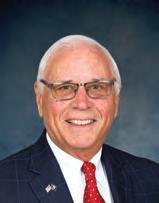
Membership Privileges?
WHAT
THE
THIS MUCH I KNOW FOR SURE
#@*$%& ARE YOU THINKING???
In the course of working with club boards and search committees to identify and retain professional executive leadership (GM/CEs) for their clubs, our firm typically conducts a market compensation analysis and assists in the final agreement negotiations with the successful candidate.
I’m continually amazed at how many seemingly competent managers expect membership privileges for themselves and often their families as part of the “normal” benefits provided to them. Where does this entitlement expectation come from?
Some years ago at a club I was hired to manage, one of the first operational standards defined for management and the employee team stated in no uncertain terms that “no employee of the club, including management, will be allowed to consume alcohol on club property.”
Our golf professional staff had been in the habit of playing golf with the members and then having drinks and sometimes engaging in card games after they finished playing golf. There could be no good end to this story, so I explained to the head pro and his assistants that they should continue their golf games with the members but there would no longer be any consumption of alcohol or participation at the gin table. This standard was endorsed by the club’s board, as board members had realized that some golf employees were acting more like members than employees.
A recently terminated general manager who contacted us had lost the board’s trust not because of his lack of ability but because of the activities of his wife and kids at the pool.
It seems that with his family’s daily use of the pool, his spouse had earned a reputation among employees as “the most difficult member.” Additionally, his two children were entered in all of the swim club events and expected to travel to events at other clubs as though they were children of club members. There could be no good end to that story and there wasn’t.
Sometimes a club president will suggest to the general manager that they should participate in the golf and social events at the club with their spouse. The subliminal message to the manager: “You are one of us.” Well, the reality is the
manager/spouse is not “one of them.” Likewise, there can be no good end to this story.
In one instance, the club general manager and his wife won a couples golf event and then the problems really began.
A perspicacious general manager will politely decline invitations to participate regularly in club events and instead play golf on Monday or whatever day the club allows employees to play.
That doesn’t mean that, on occasion, the general manager should not participate if asked to play with a group of members or at the annual board tournament. However, there should never be a perception that “our manager is on the course again today” or, even worse, “they’re playing with their regular group of members on Saturday morning.”
There can be no possible good emanating from general managers and their families becoming active participants and users of club facilities. Not only do employee/member lines become blurred for the general managers but there can also be frustration at the staff level as employees struggle with the “are they employees or members” issue.
This entitlement thinking can undermine any of the positives that a quality general manager may be providing the club because of how emotionally charged this issue can become. It provides fodder for the “bridge ladies” and is the hot topic at the “round table” in the club grille.
Successful club general managers have set clear standards for themselves and their employees when it comes to socializing at the club. These standards recognize that while general managers may, on occasion, enjoy club privileges, they are not entitled to the same membership privileges purchased by their employers, the members.
If they don’t understand that distinction, there can be no good ending to this story.
This much I know for sure. BR













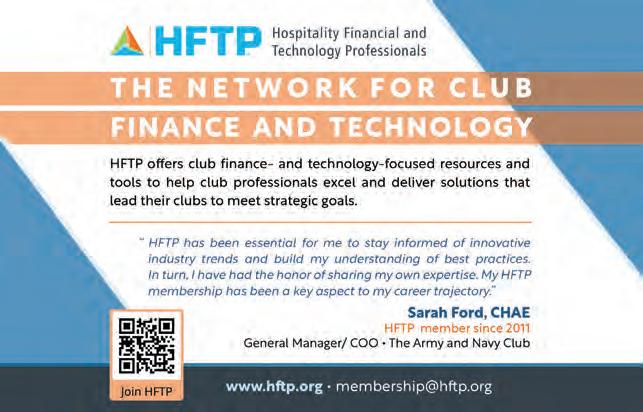













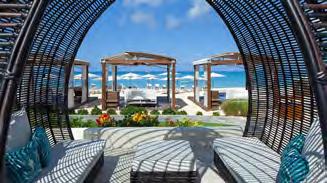


Steve Berlin
CLUBS AND PEOPLE MENTIONED
Tyler Brown, head golf professional, Salish Cliffs Golf Club, Shelton, WA
Kris Butterfield, director of membership, communications & public relations, Bethesda Country Club and president of PCMA.
Frank Cordeiro, CCM, COO, Colonial Country Club, Fort Worth, TX.
Boris Fetbroyt, USPTA, PTR, CRSE, director of racquets, The Philadelphia Cricket Club, Philadelphia, PA
Todd Dufek, locker room manager, The Country Club at DC Ranch in Scottsdale, AZ.
Susan Greene, GM/COO of Waterlefe Golf and River Club, MPOA, Bradenton, FL
Lon Grundy, GM, World Golf Village in St. Augustine, FL
Mark Gurnow, PGA member and general manager, Superstition Mountain Golf and Country Club, Gold Canyon, AZ.
Peter Jackman, GM, Terminal City Club, Vancouver, BC, Canada
Dr. Bonnie Knutson, the Country Club of Lansing and the Michigan Athletic Club
Nancy Levenburg, member, Spring Lake Country Club, Spring Lake, MI
Wayne Moriarty, member, Terminal City Club, Vancouver, B.C. Canada
Jessica Payne, director of membership, San Jose Country Club, Jacksonville, FL.
Robert D. Podley, CCM, CAM, GM of Colonial Country Club, Fort Myers, FL.
Pamela Radcliff, SHRM-SCP, CAM, director of human resources, Hideaway Beach Club, Marco Island, FL
Michael Vlad, GM/CEO, The Argyle Club, San Antonio, TX





